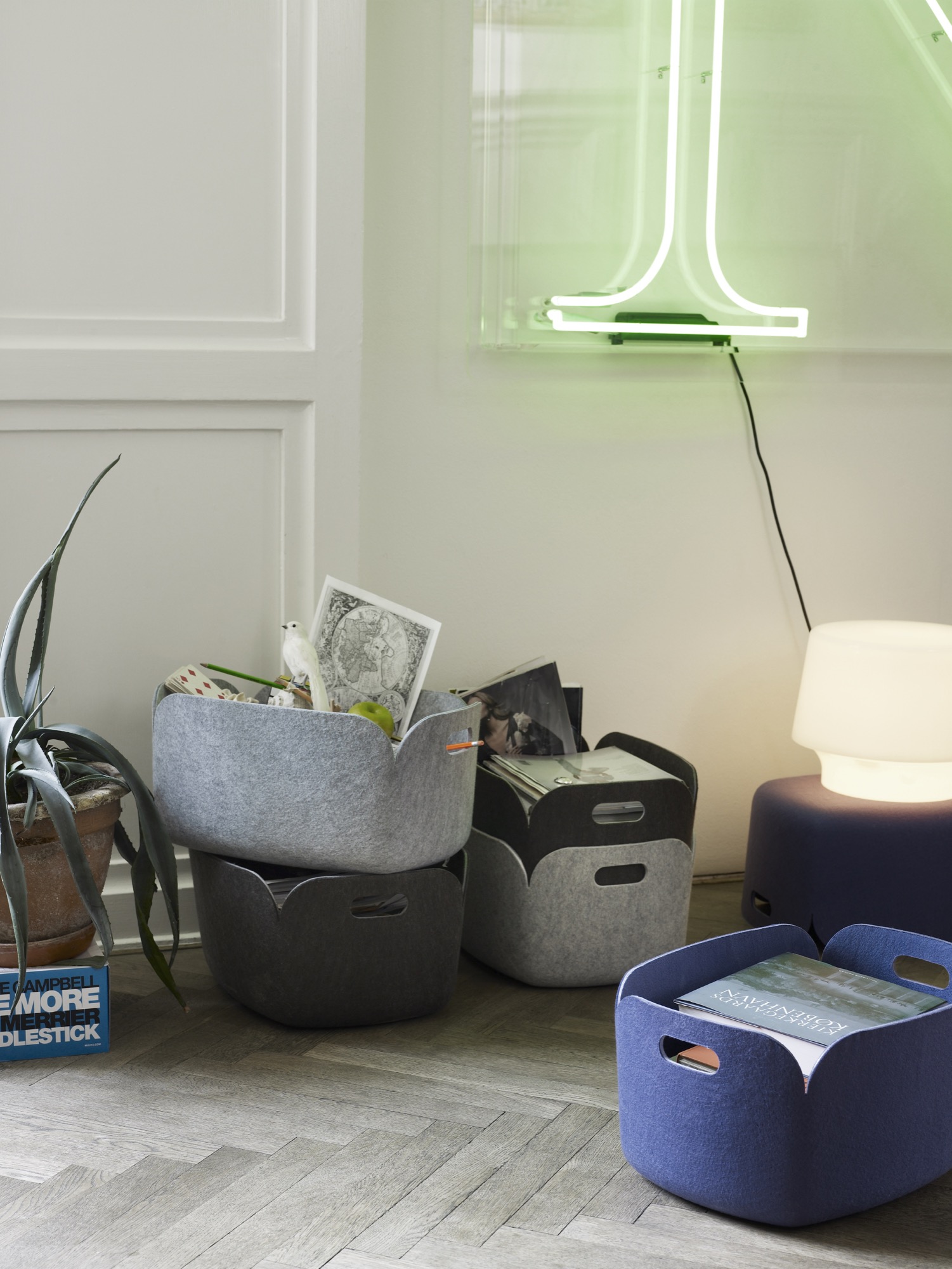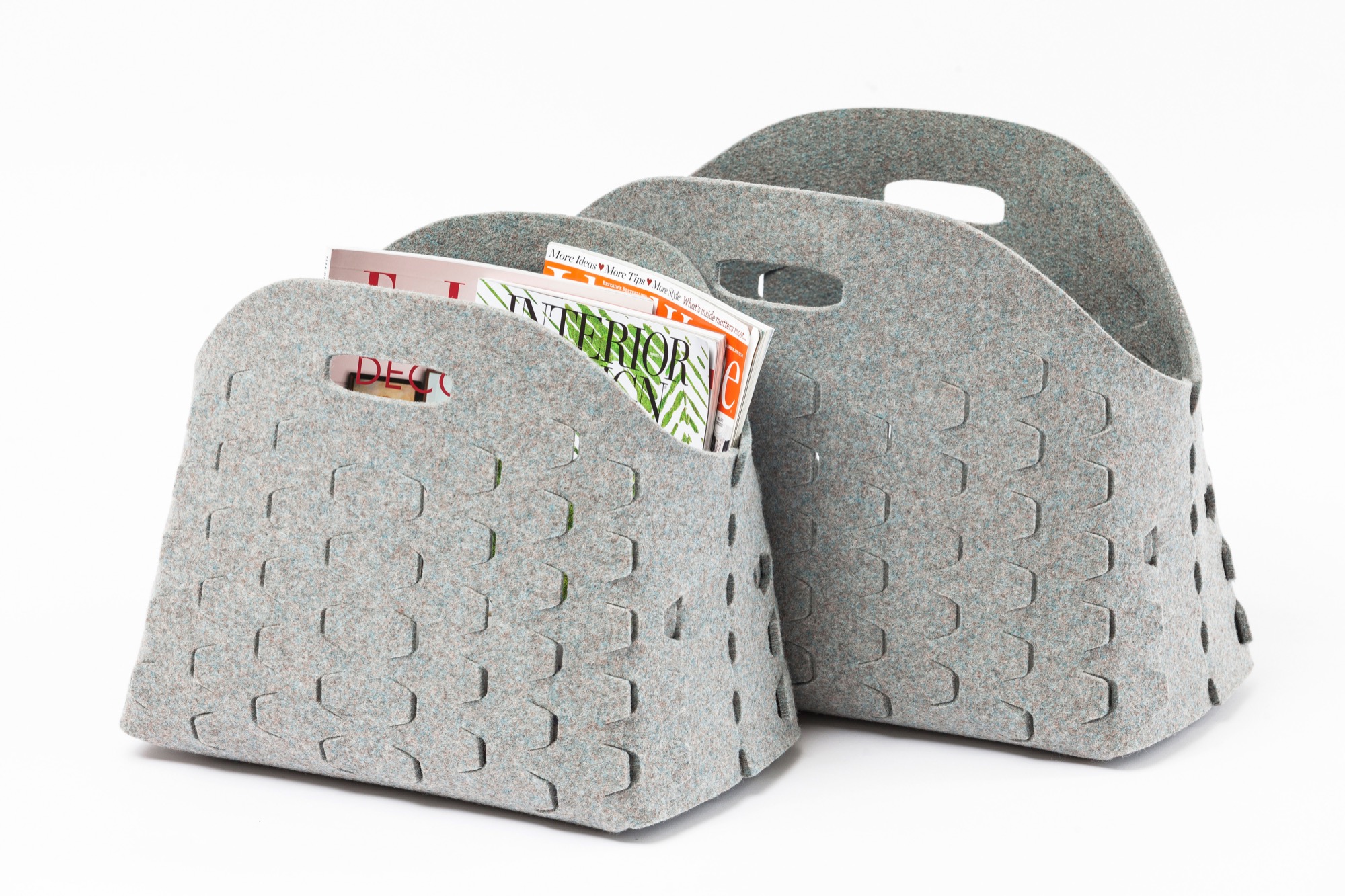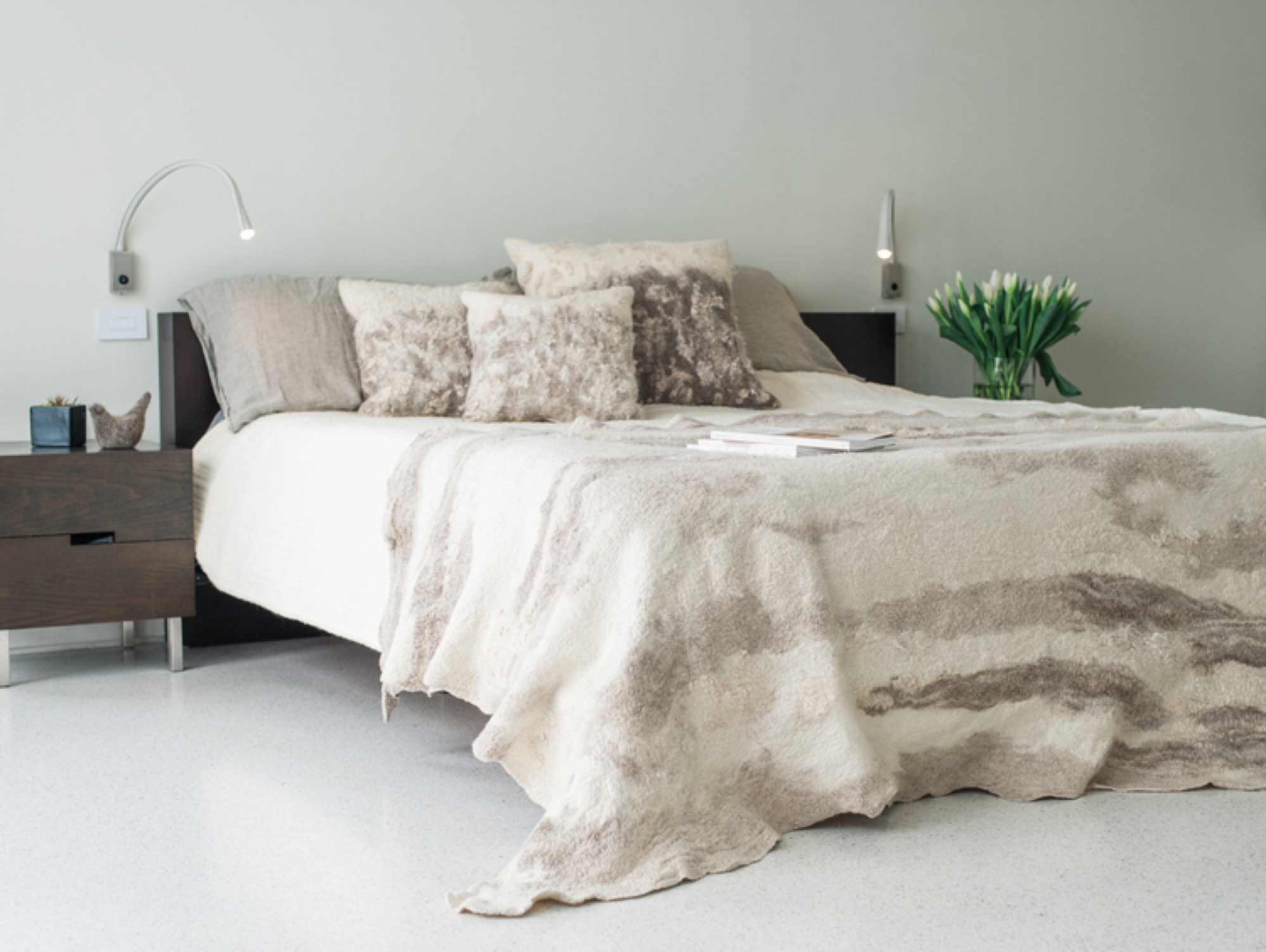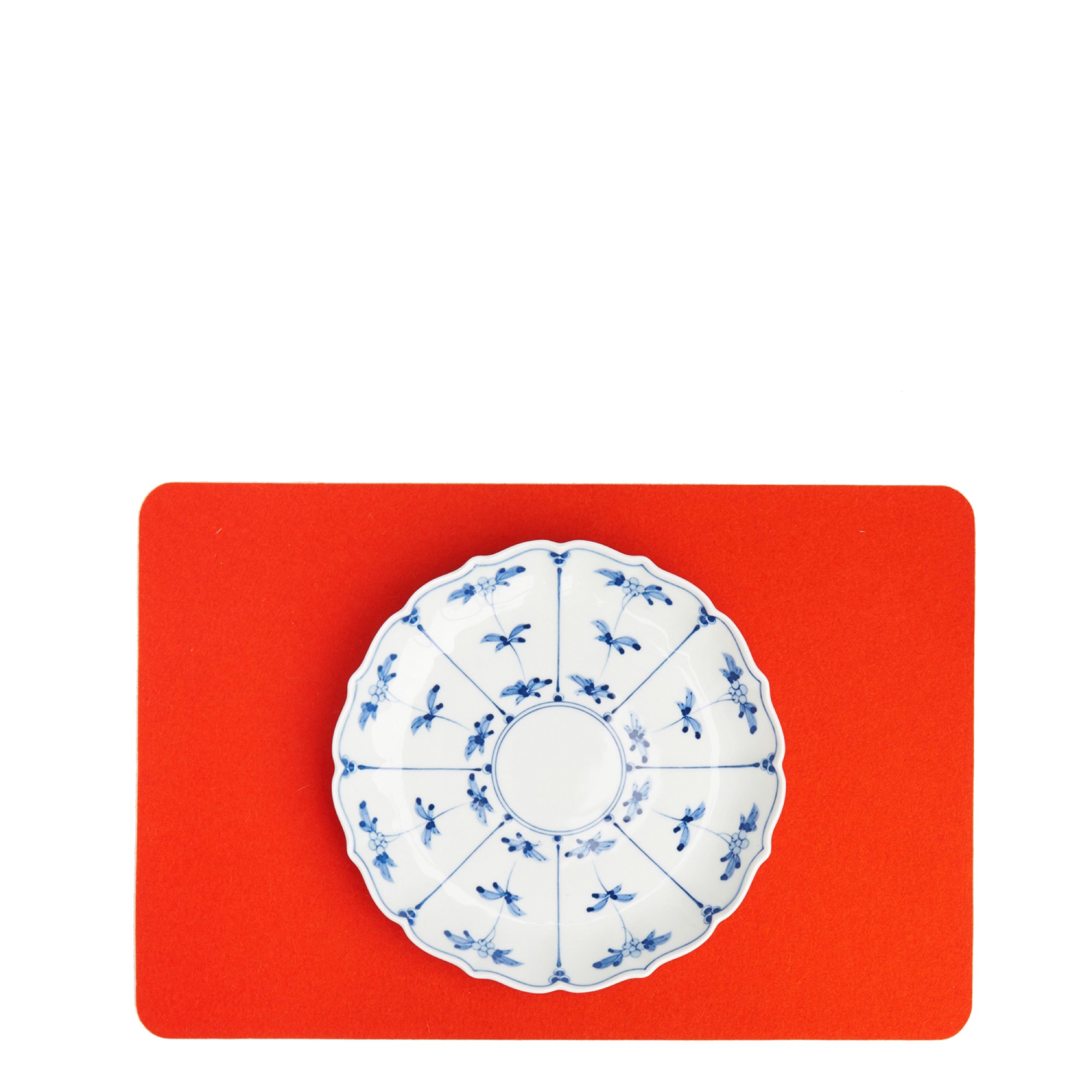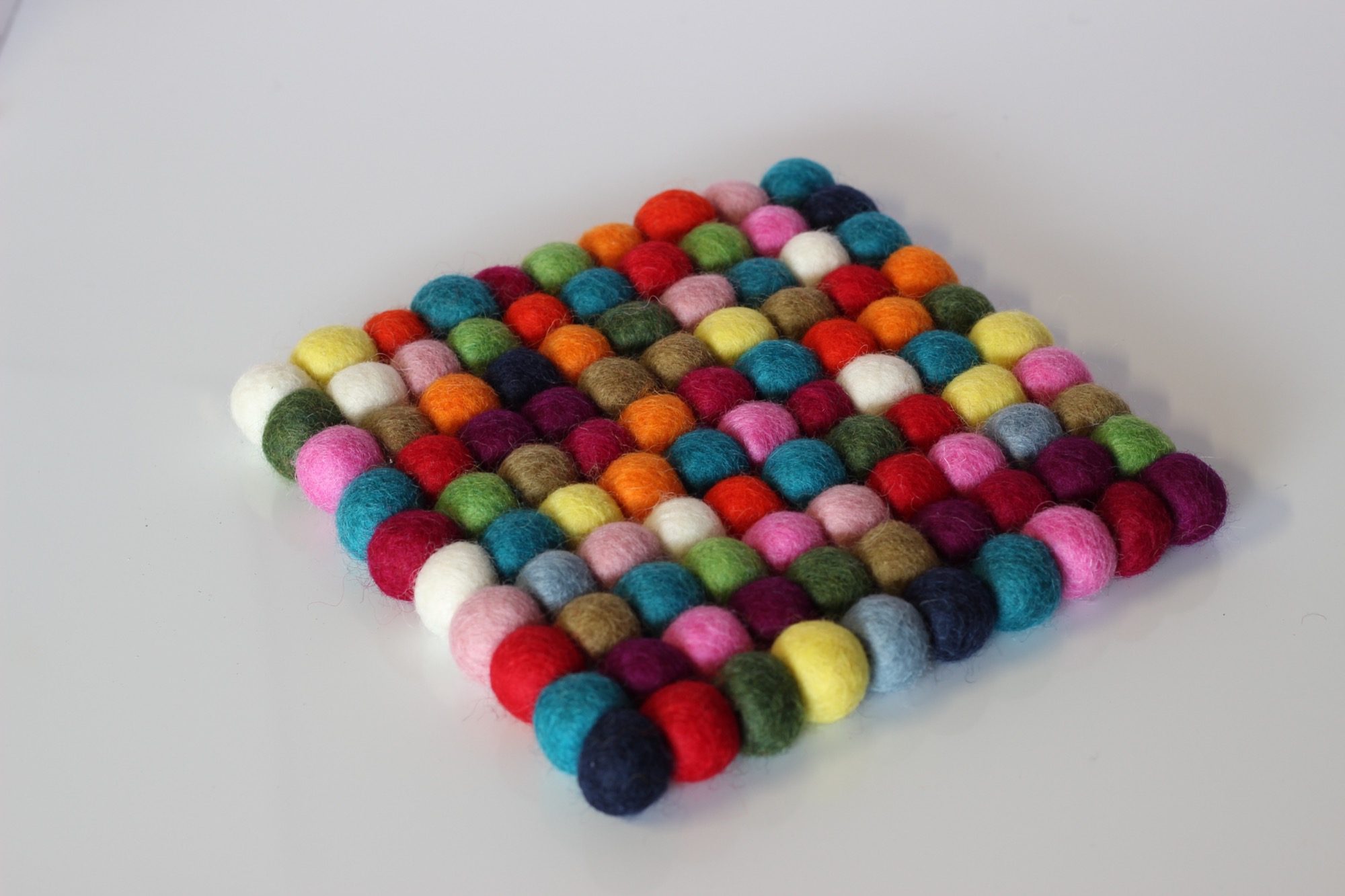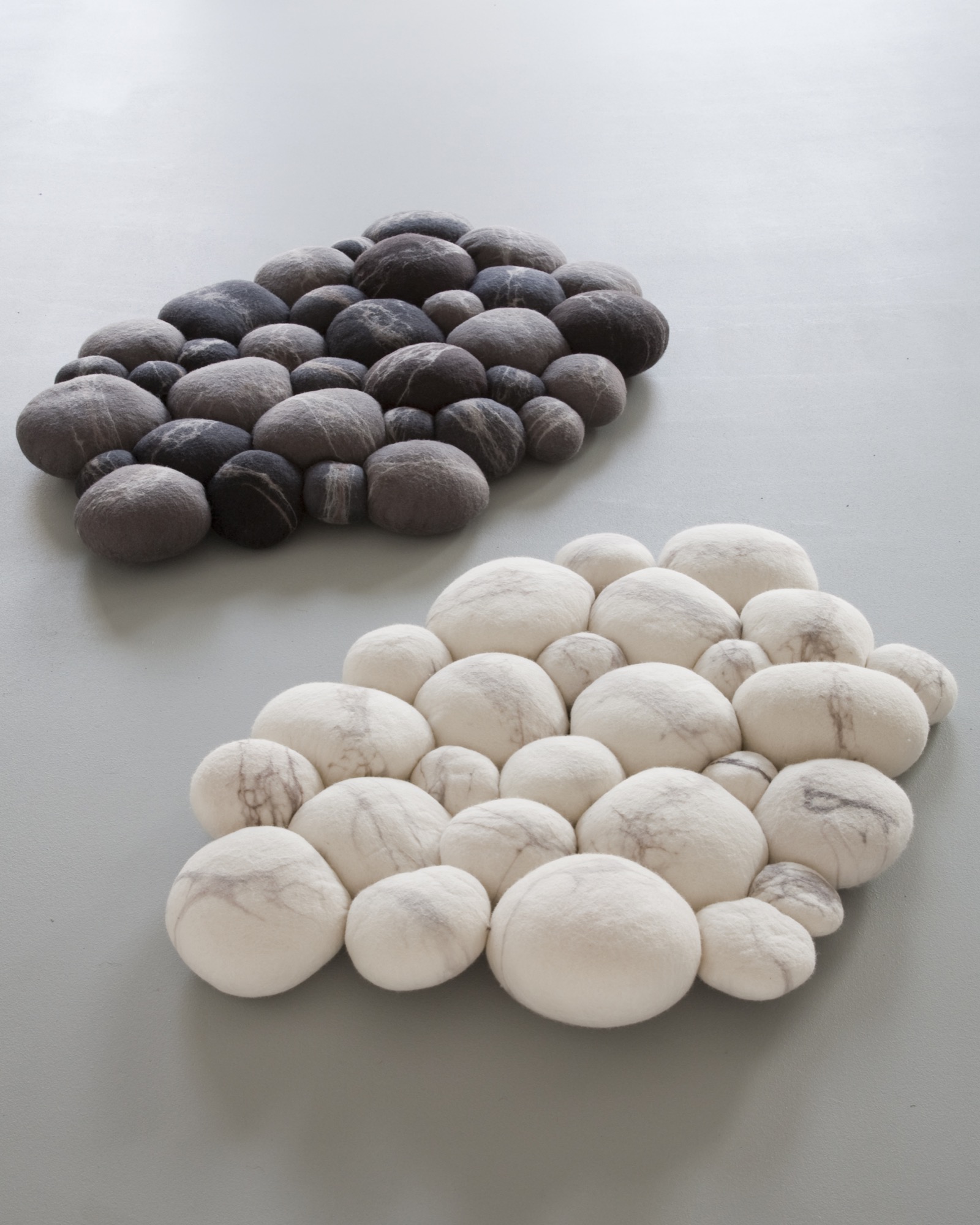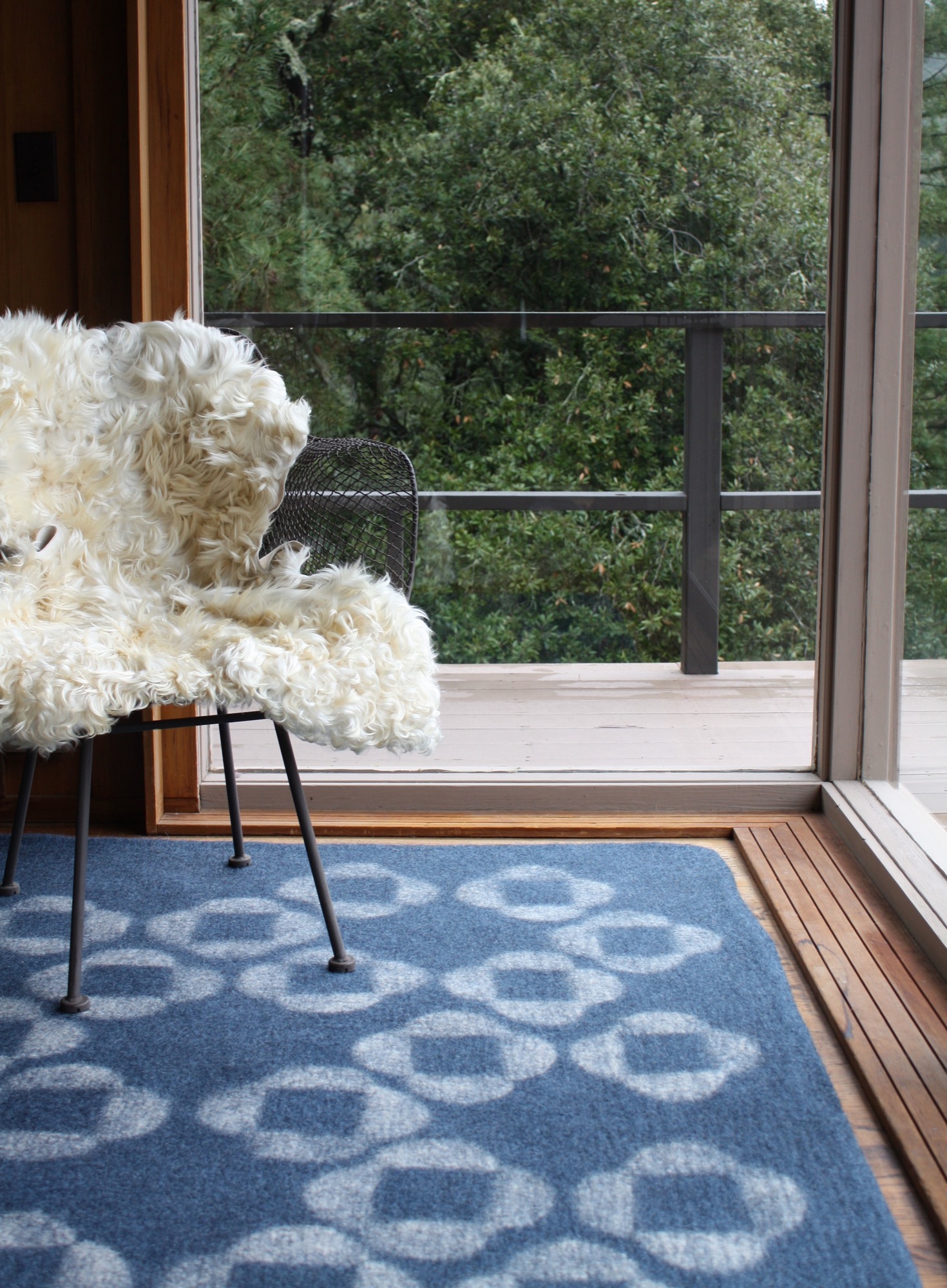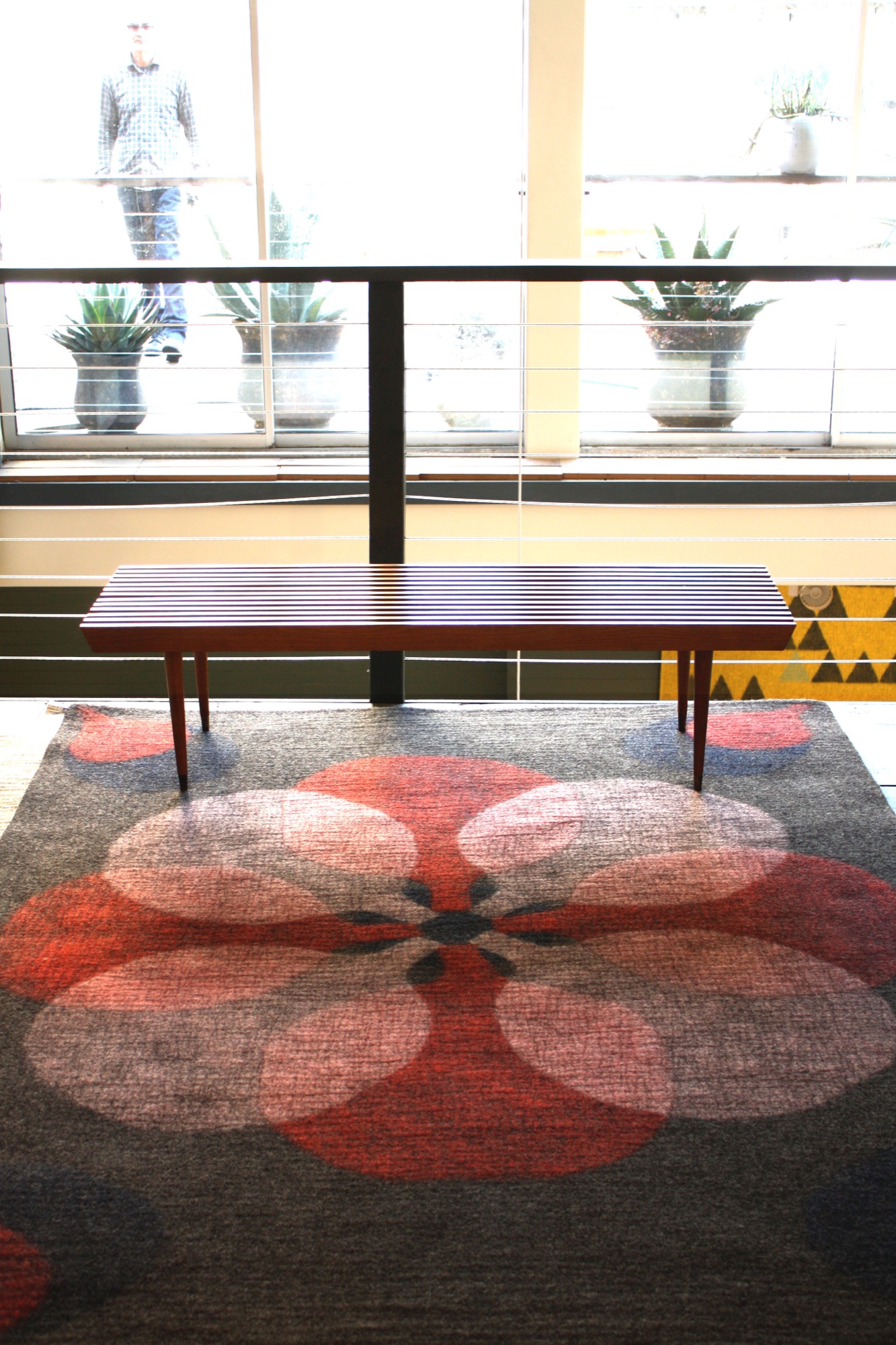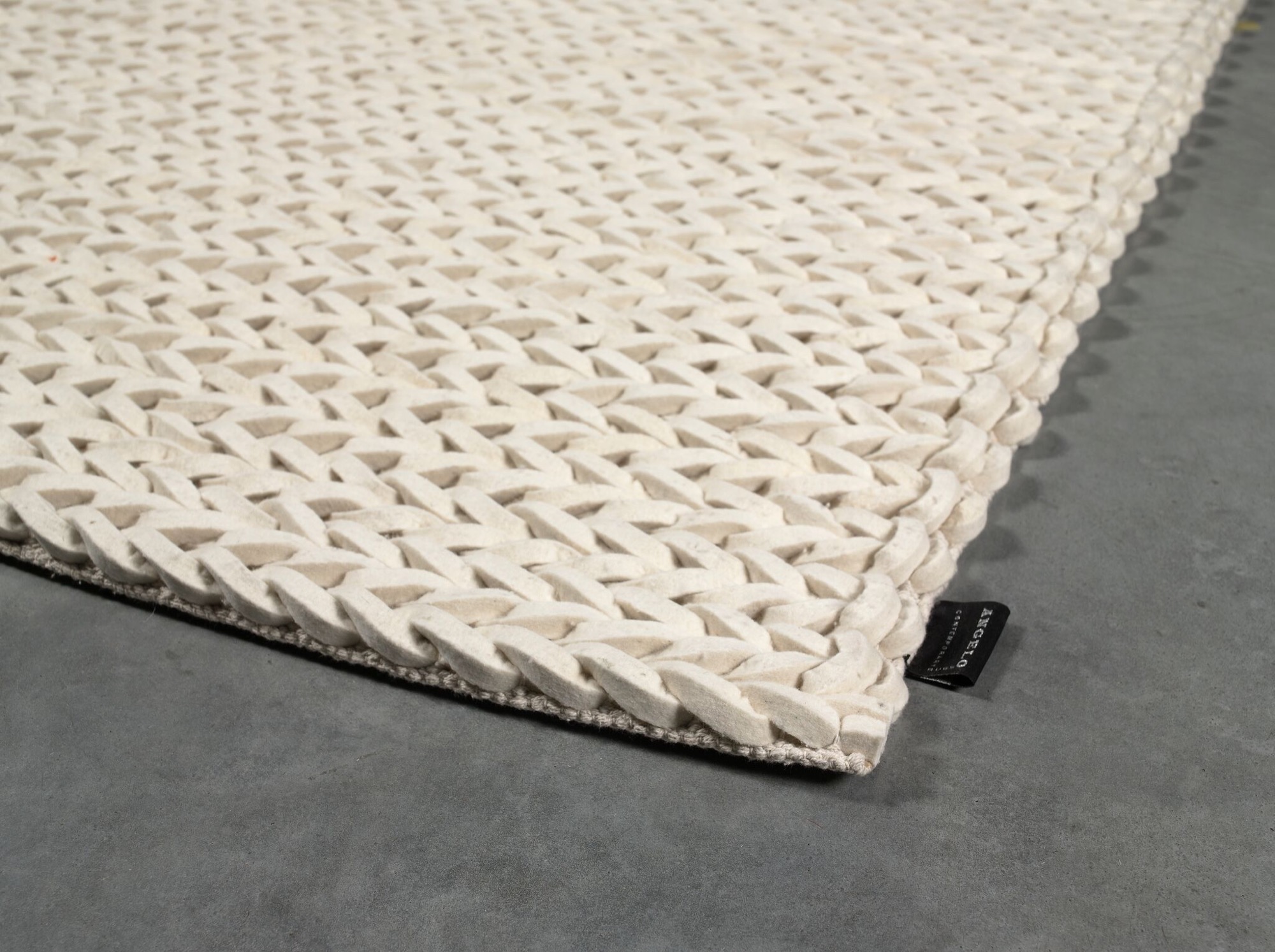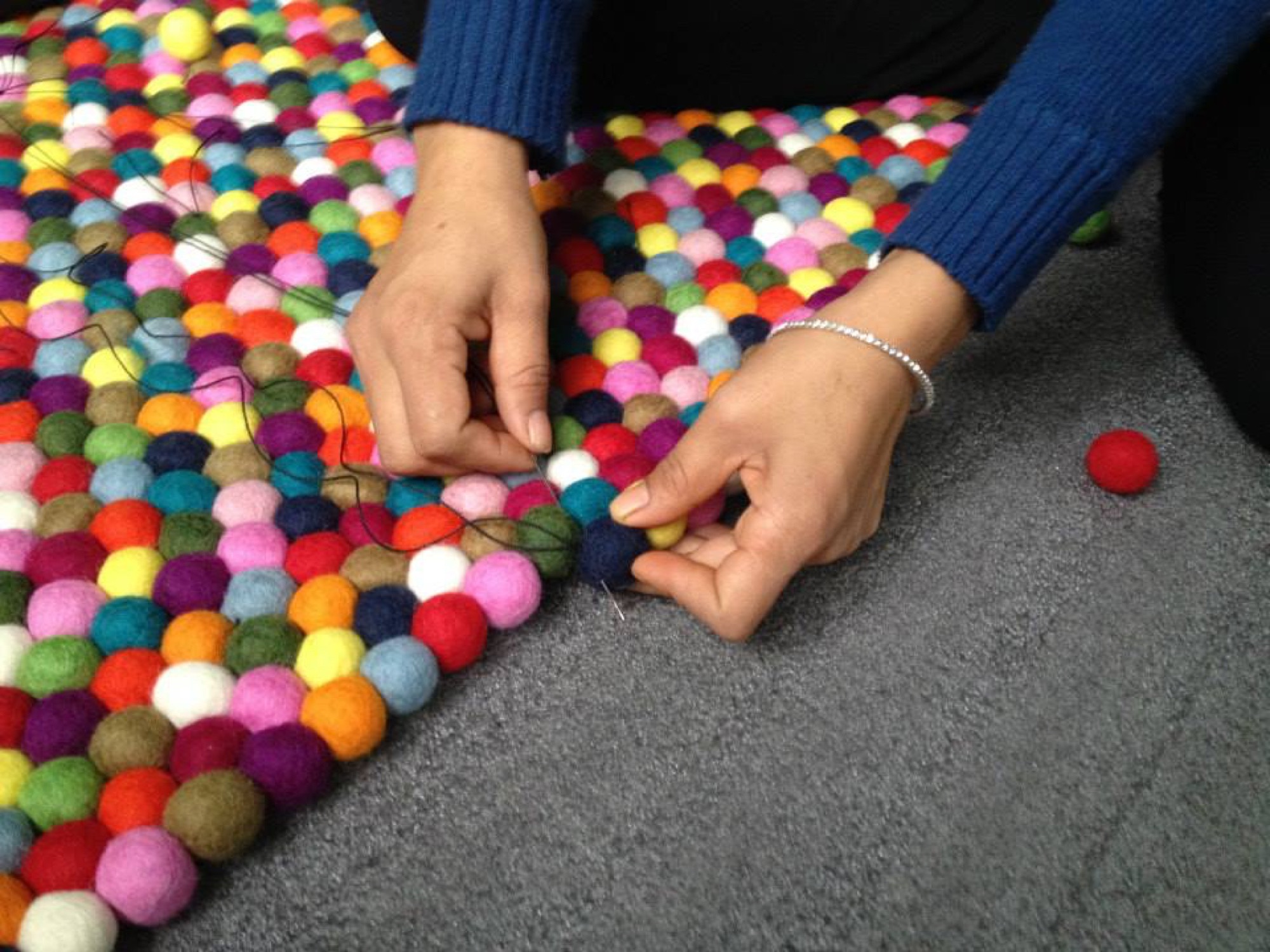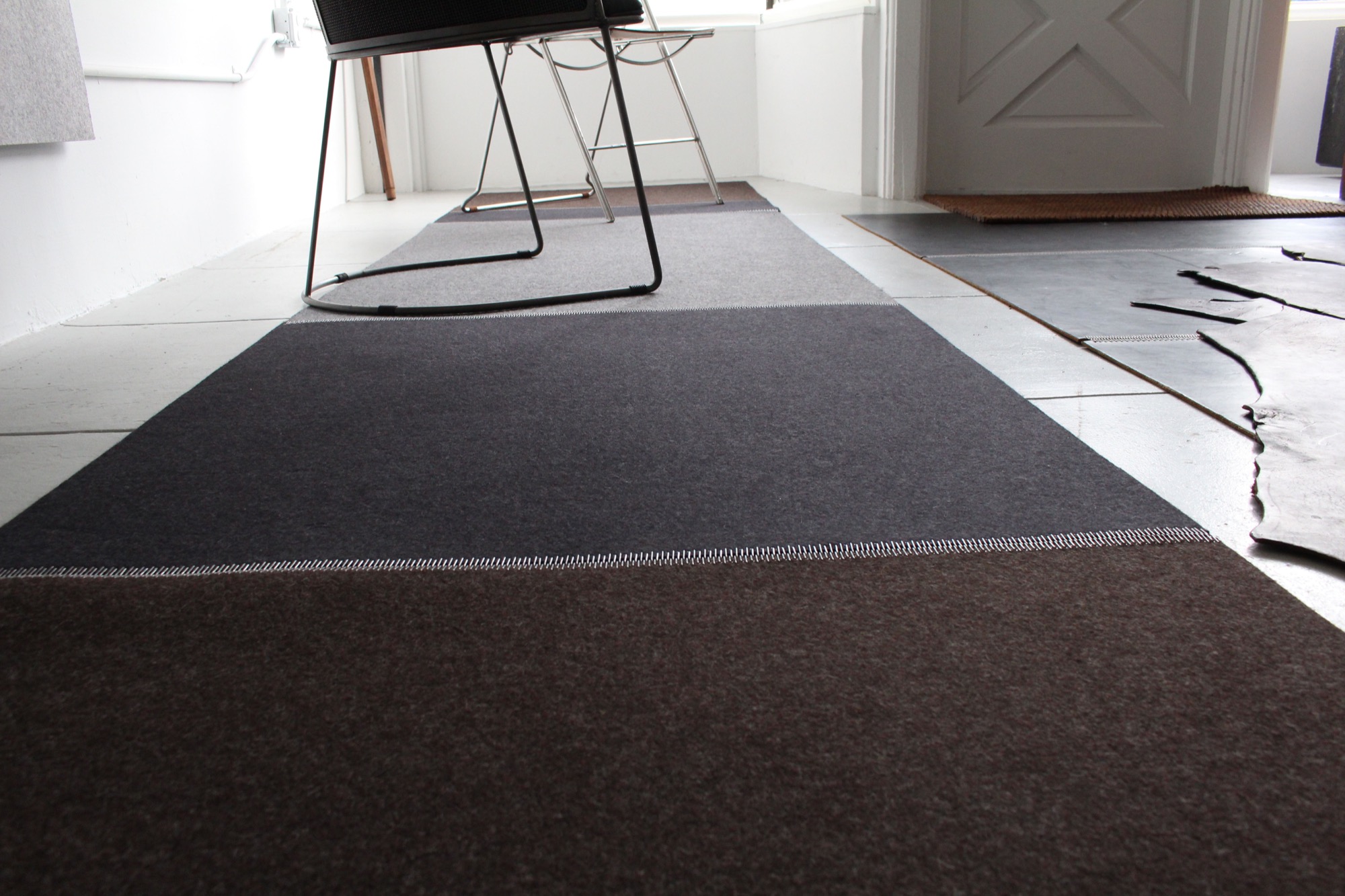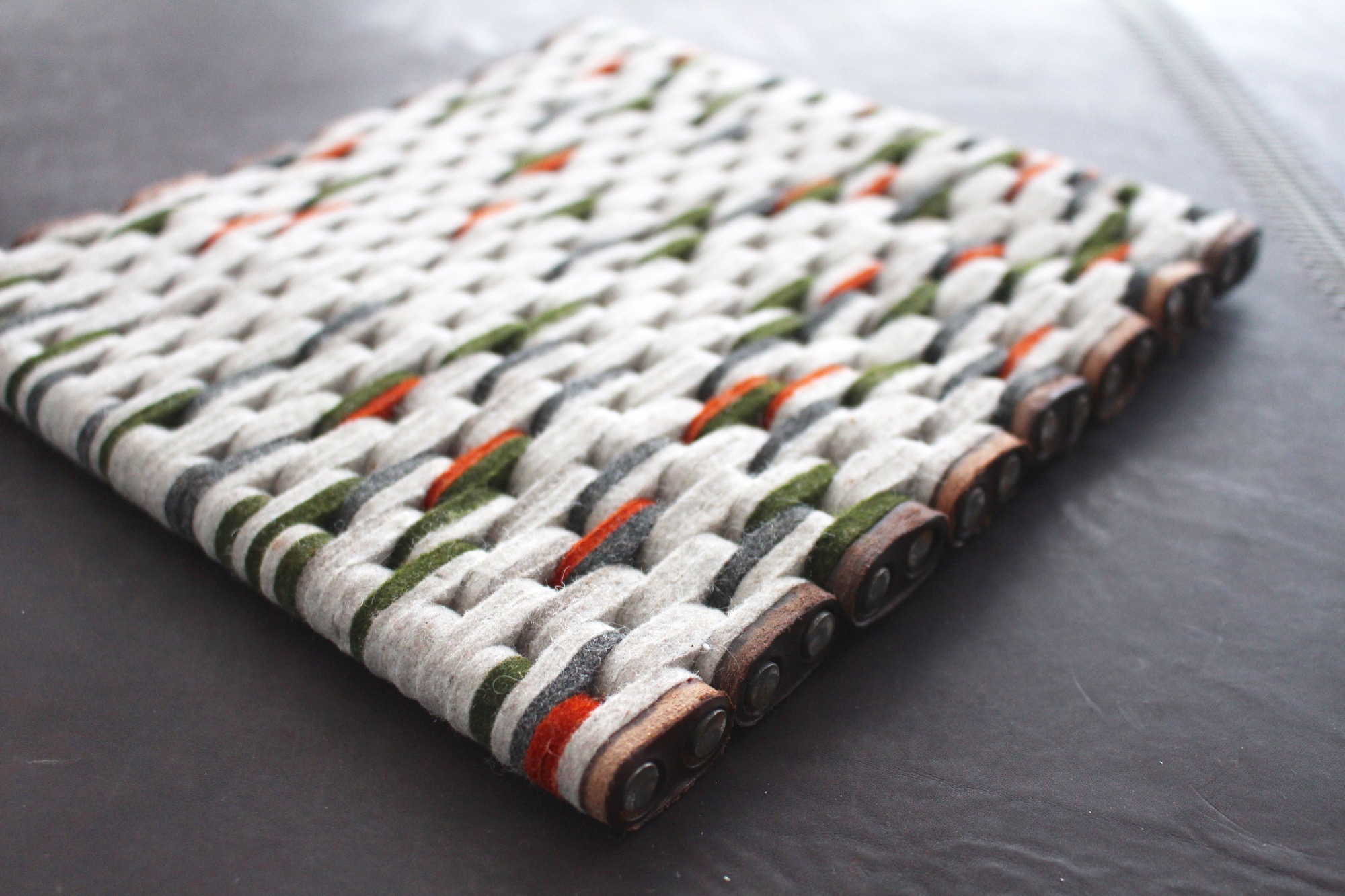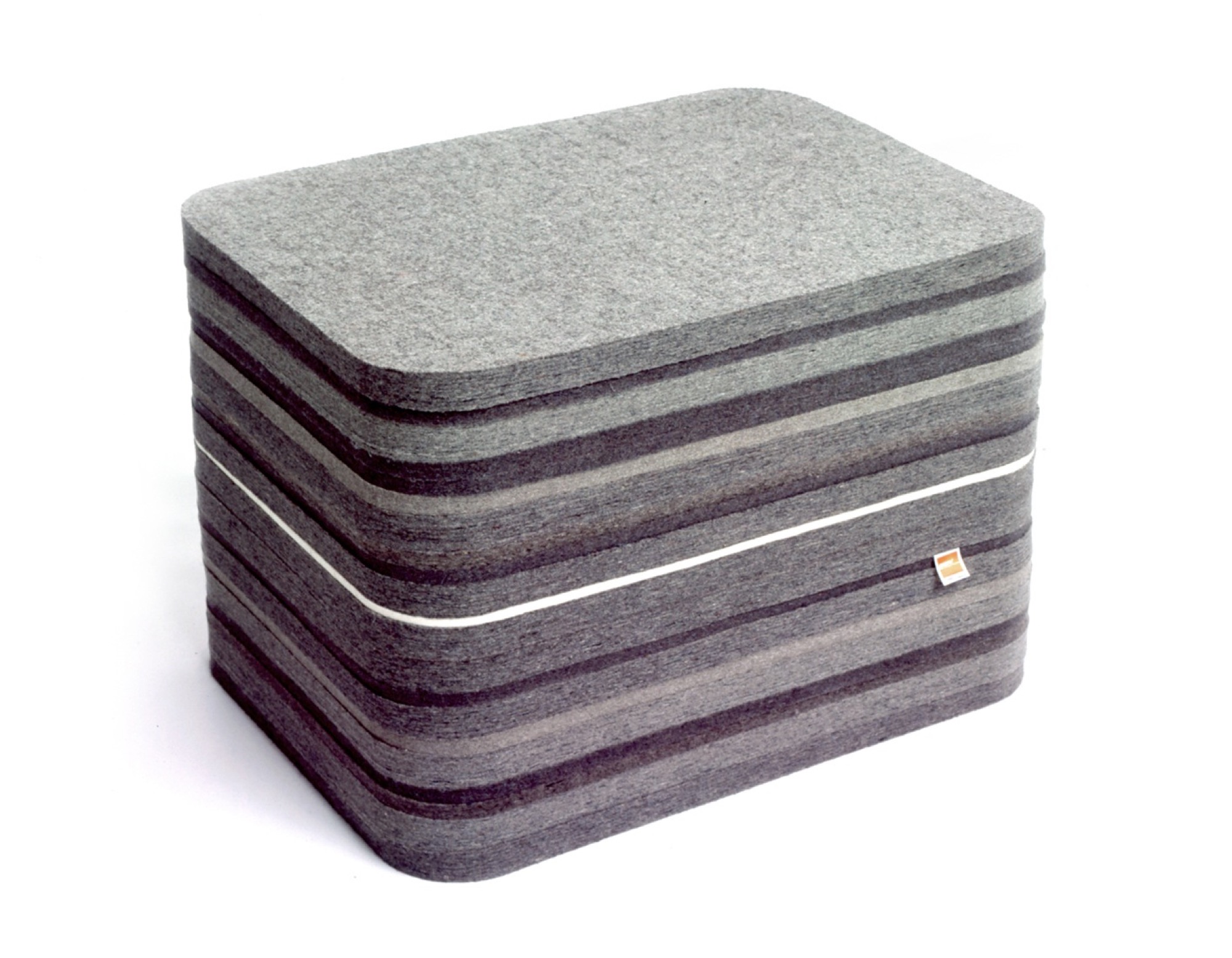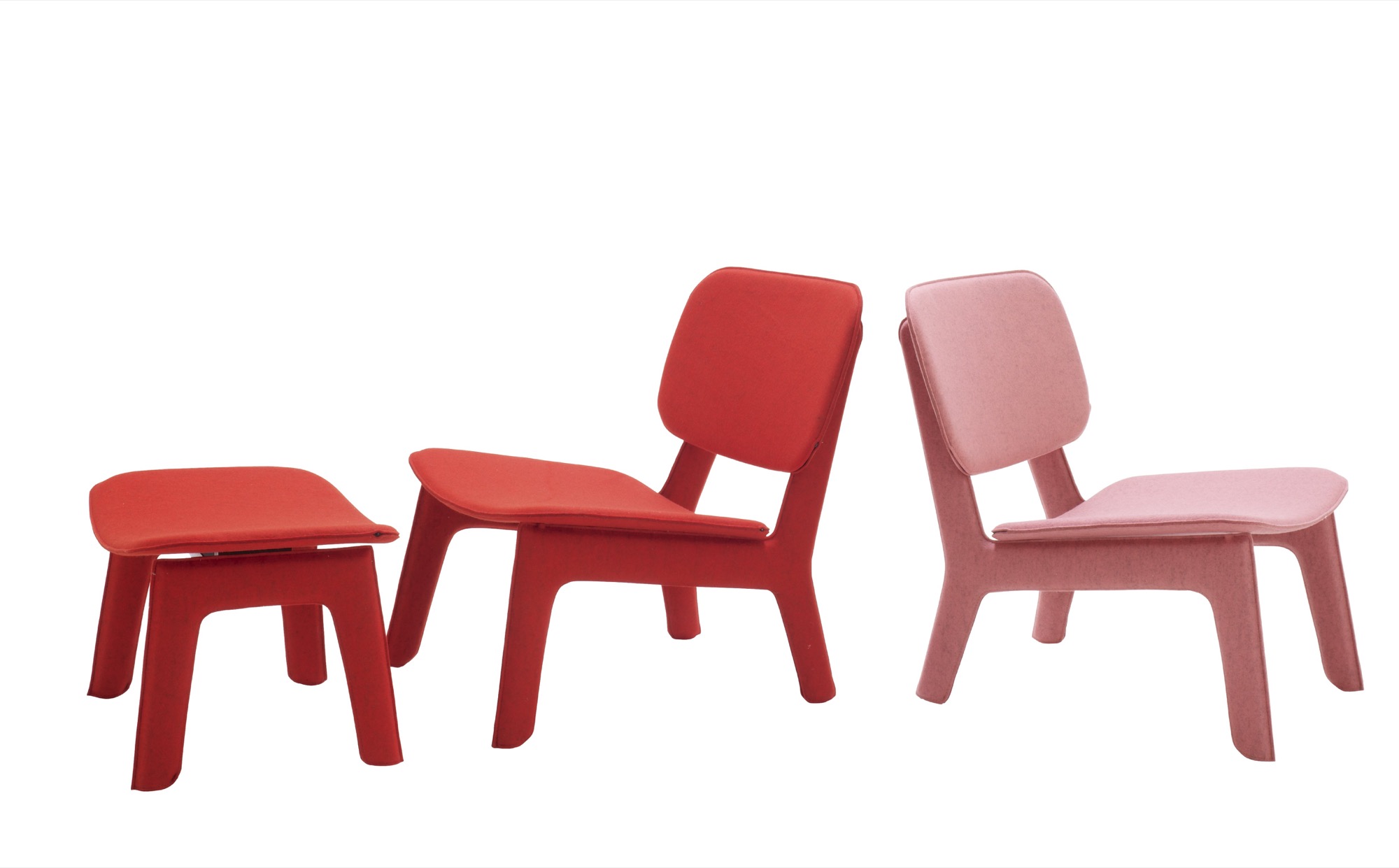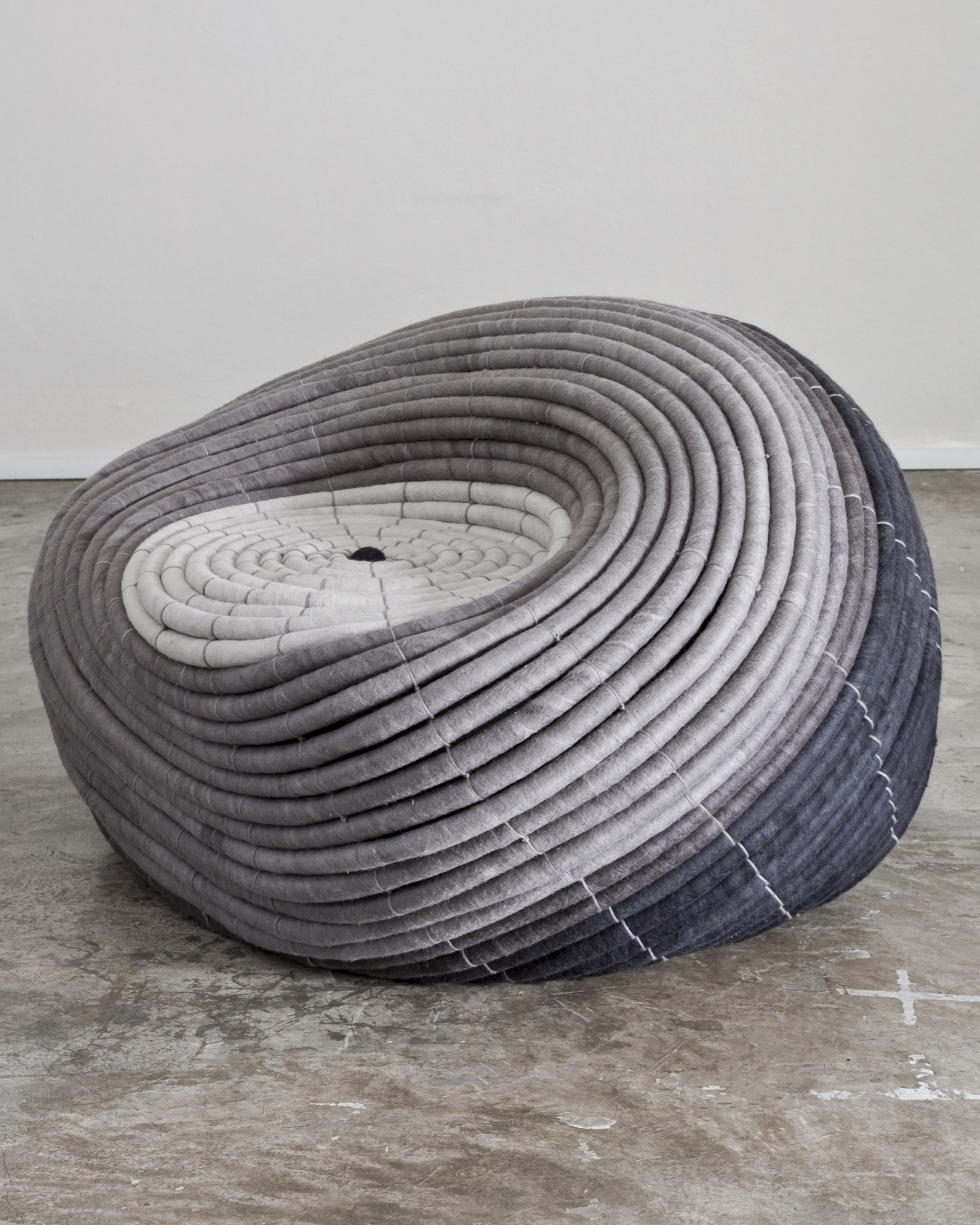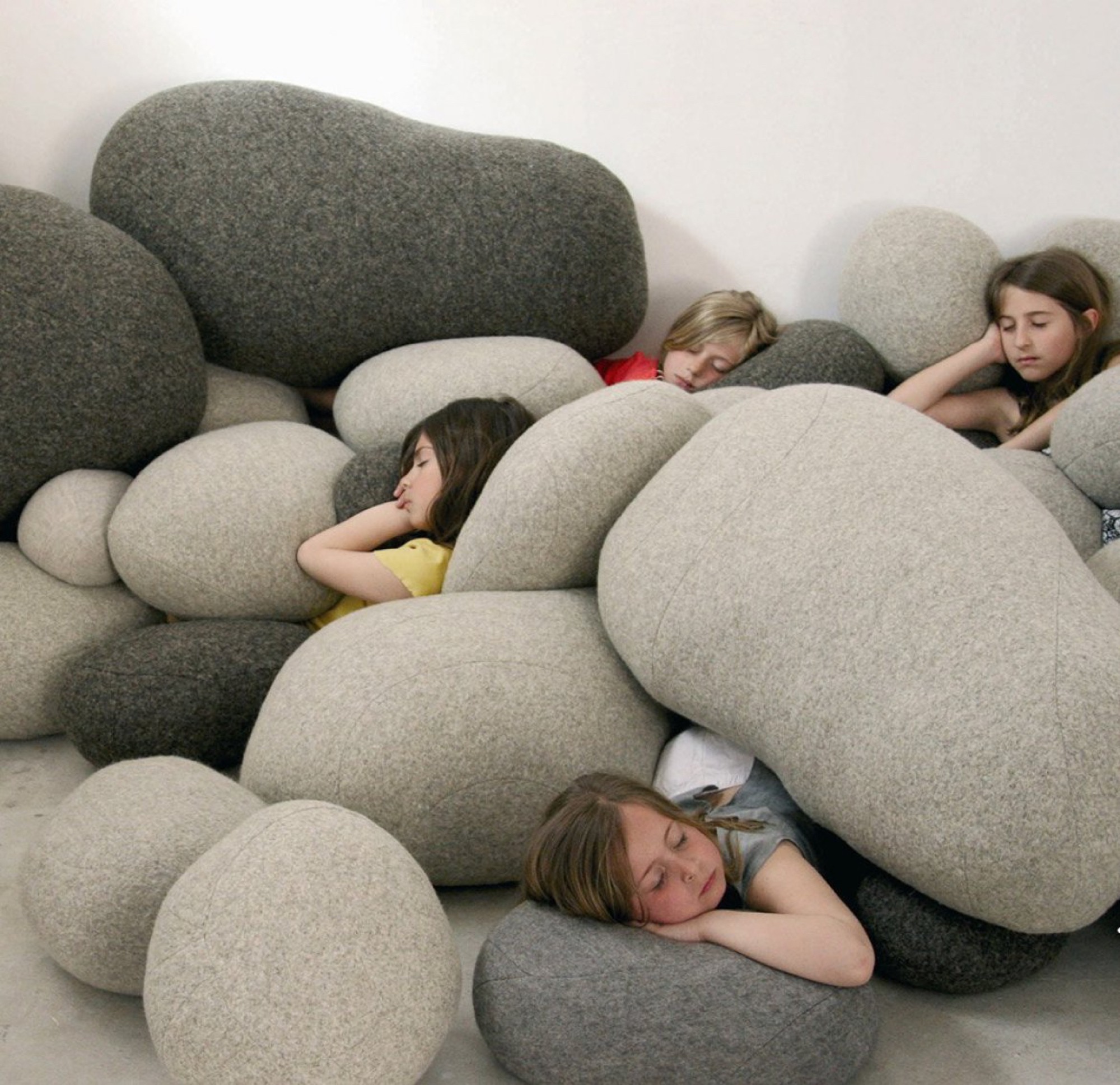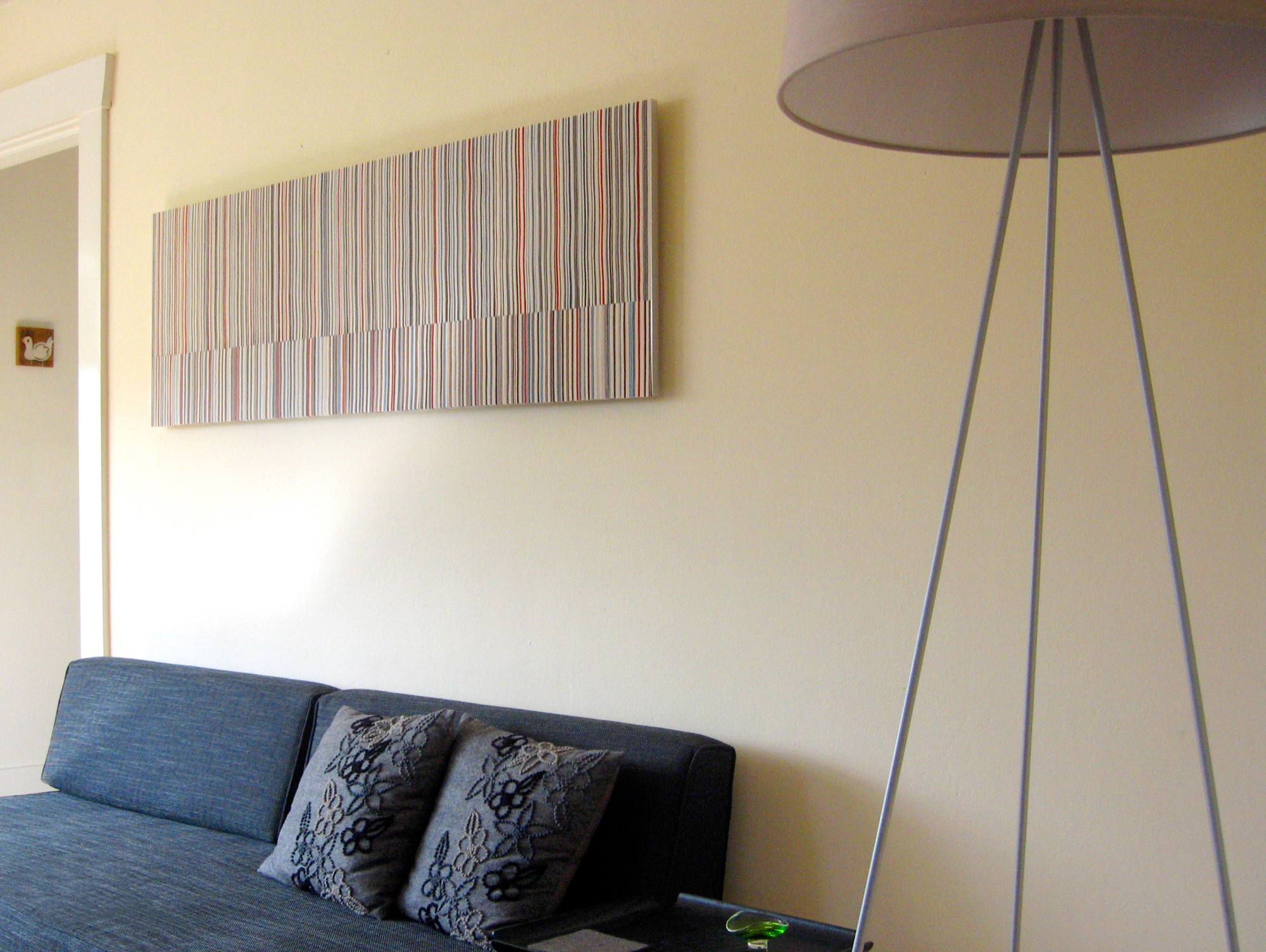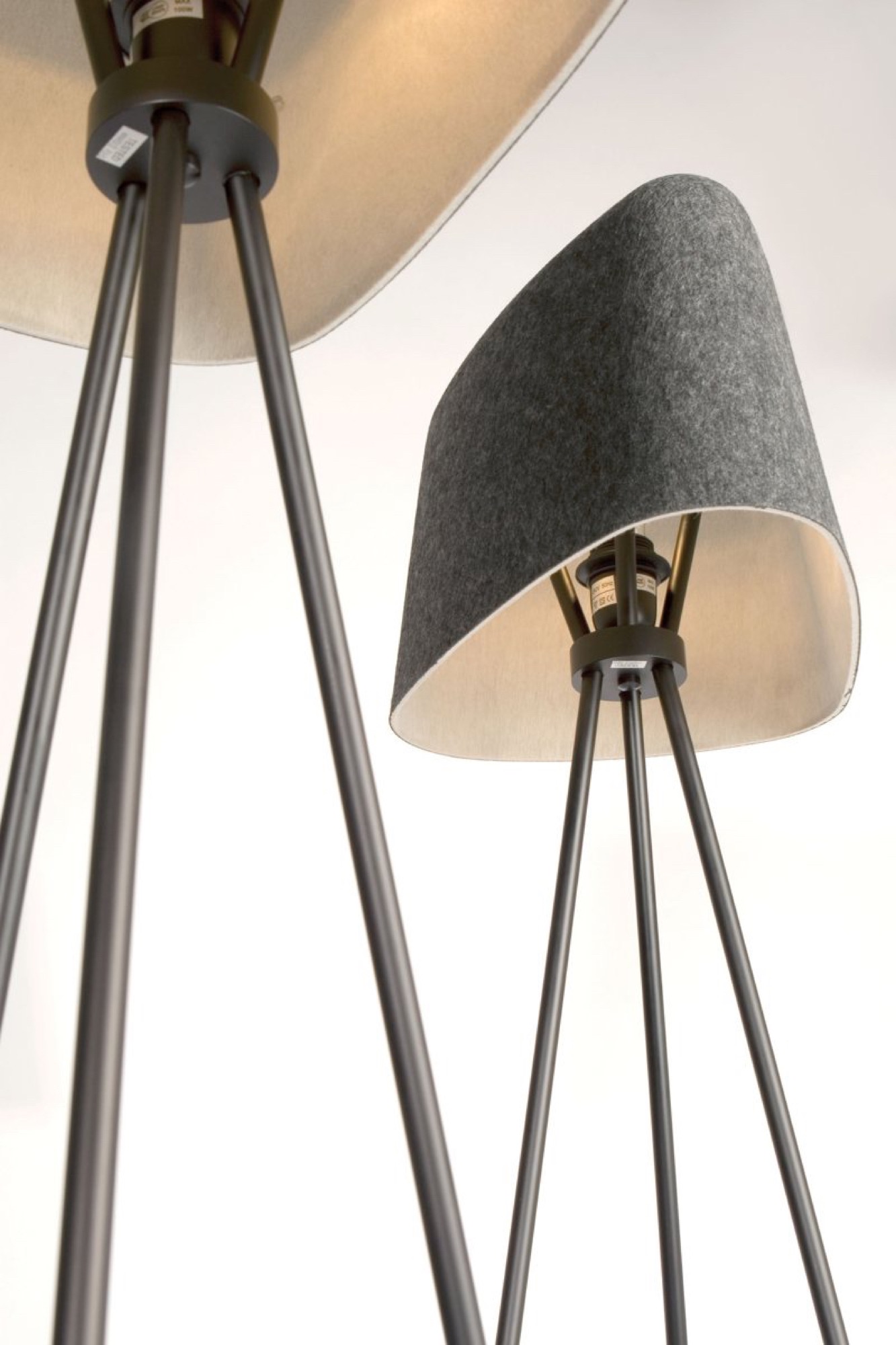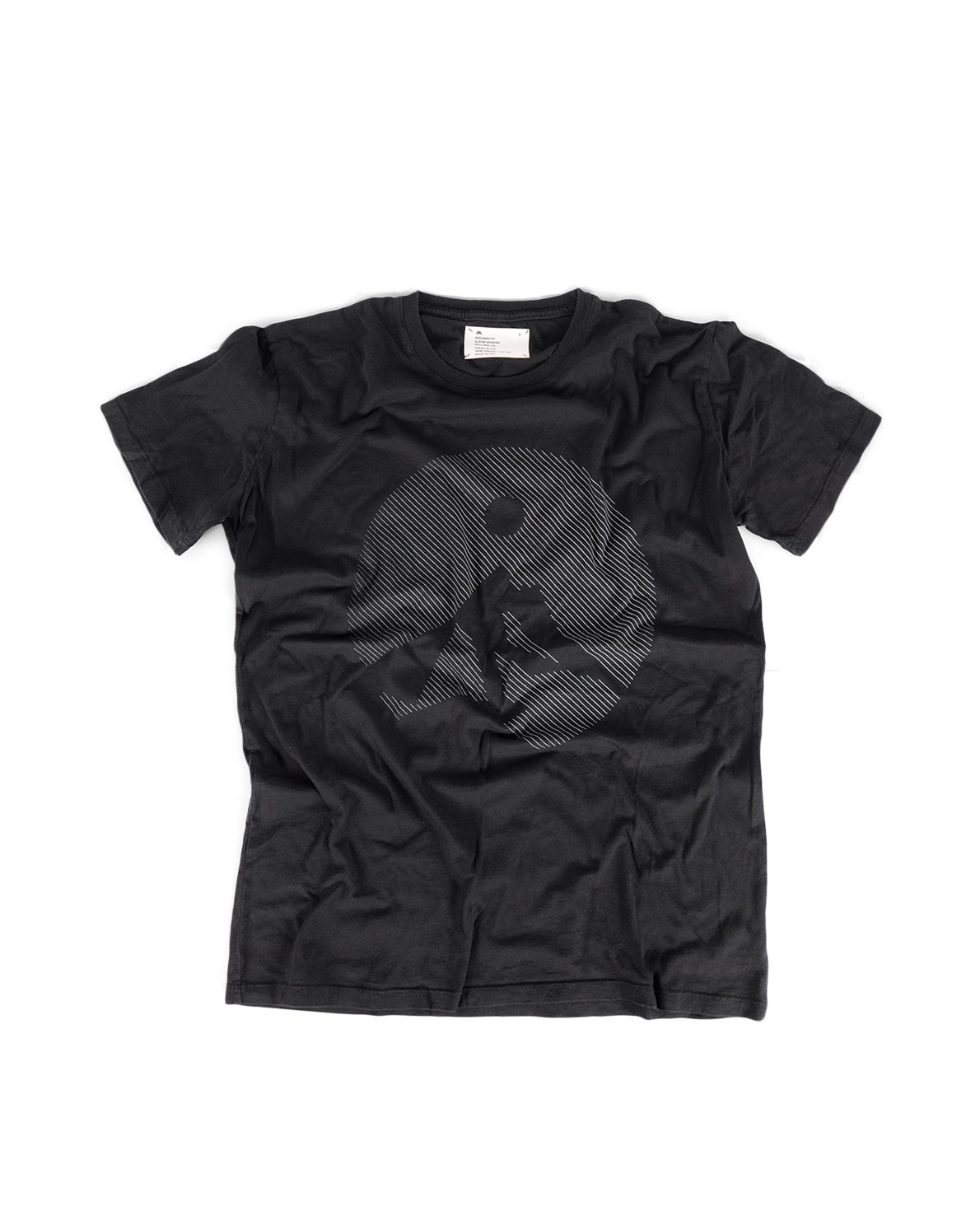
Inspirations
Explore the elevated life in the mountains. This content debuted in 2015 with Alpine Modern’s printed quarterly magazine project.
Inspirations No. 14
In this article… blah, blah, blah.
Hope you're enjoying a relaxing Saturday. We're getting bundled up and about to head down to the Cafe for waffles with our guests visiting from California. There's nothing like sugary waffles and warm coffee to kick off a weekend with friends. We're so thankful for the success of Alpine Modern Cafe and the amazing staff that wake up every morning to serve our neighborhood and the wide-eyed visitors from around the globe. It's demanding, being in the service industry, but occasionally our drained egos are refilled by a thoughtful online review, a sincere thank you, or, in this case, a spot at the top of a well-regarded list. Alpine Modern Cafe was highlighted, along with Intelligentsia, as the best place to get coffee in the USA from the Financial Times newspaper. We learned about this on Friday when we had an unusual number of Englanders visiting the Cafe, all snapping photos for their Instagram accounts. So cool! Well done, everyone! Here are some inspirations to keep you busy this morning:
Finally, someone designed a television for the modern home. The Samsung Serif is a work of art.
Coco has become an Instagram icon. She lives in Japan and she is only six years old.
This online illustrated guide to Frank Lloyd Wright's signature buildings.
This new game from our friend, Matt Sisson, called Ravine. We’ll be carrying it in our Shop once it’s ready but if you want to support Matt and receive an early copy, back him on Kickstarter.
Mr Porter curated a wonderful list of retreats. What’s more luxurious than a retreat in the middle of nowhere?
Chasen + Stone Matcha made this video about the cultivation and production of it matcha. This small farm in Japan supplies all the matcha for our Cafe and Coffee Bar.
Desktop cold brew coffee system by Bruer.
Two alpine-modern architects in Colorado worth noting: Studio-B and tres birds workshop
Loving these new Reebok × Barneys New York suede shoes.
Our Canadian friends at Wise sent us samples of their hair care products. We’ve been using the shampoo for the last two weeks. It smells splendid and the packaging design...it's oh so nice.
This home in Northern California is worth the click.
Pia Wallen Stockholm Design Studio
We had the opportunity to meet with the renowned designer, Pia Wallen, in her magnificent Stockholm studio.
Louisiana Art Museum in Denmark
If you must see one museum while in Copenhagen, go to the Louisiana. It's about one hour north of the city and you can get there by bus or taxi. The exhibitions and installations are nice but what truly sets this museum apart is the architecture of the building and its setting on the water. Also of note is the exquisitely curated gift shop (we took copious notes of newly discovered designers for the Shop) and the free kids' artistic studios.

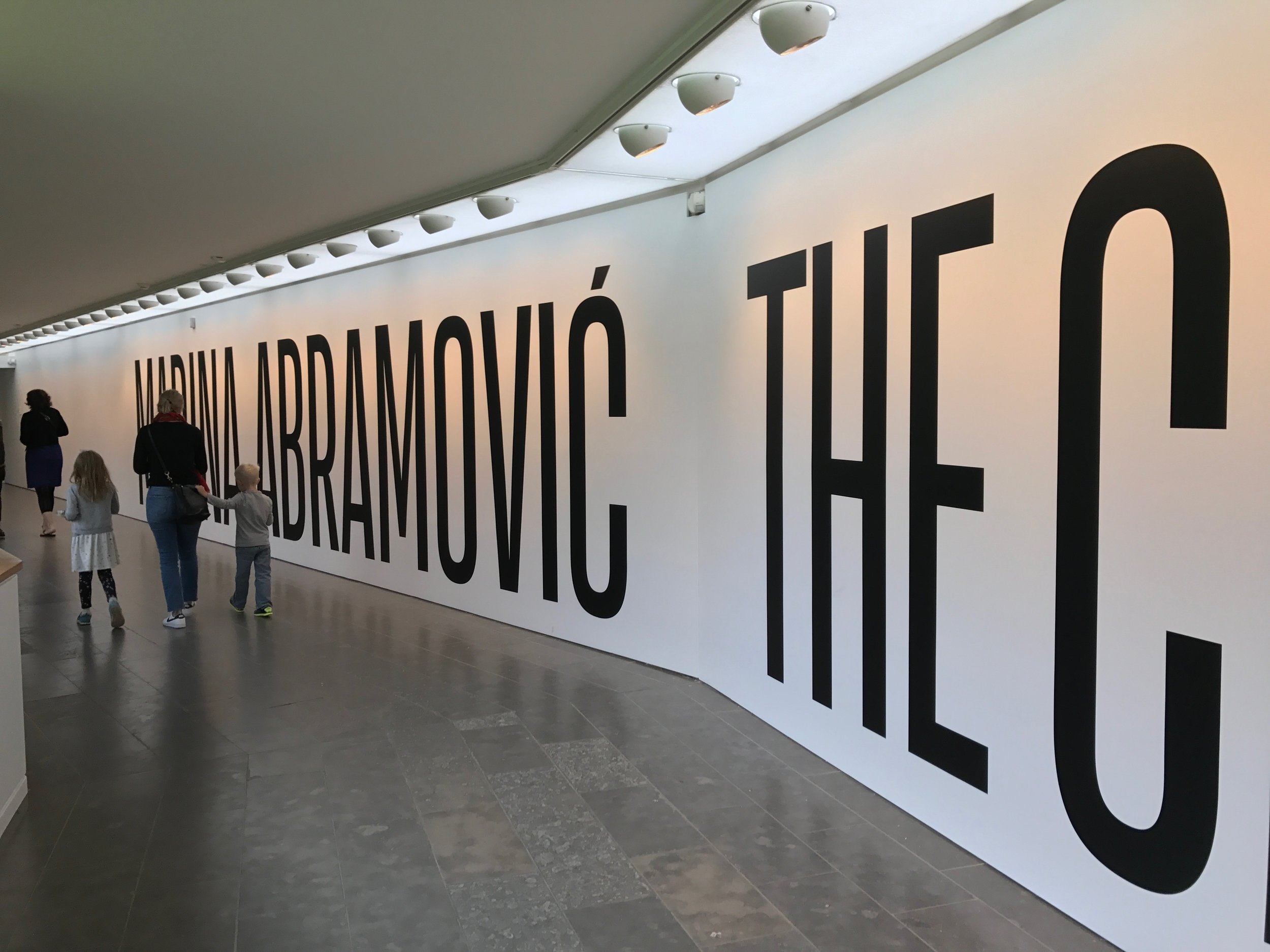
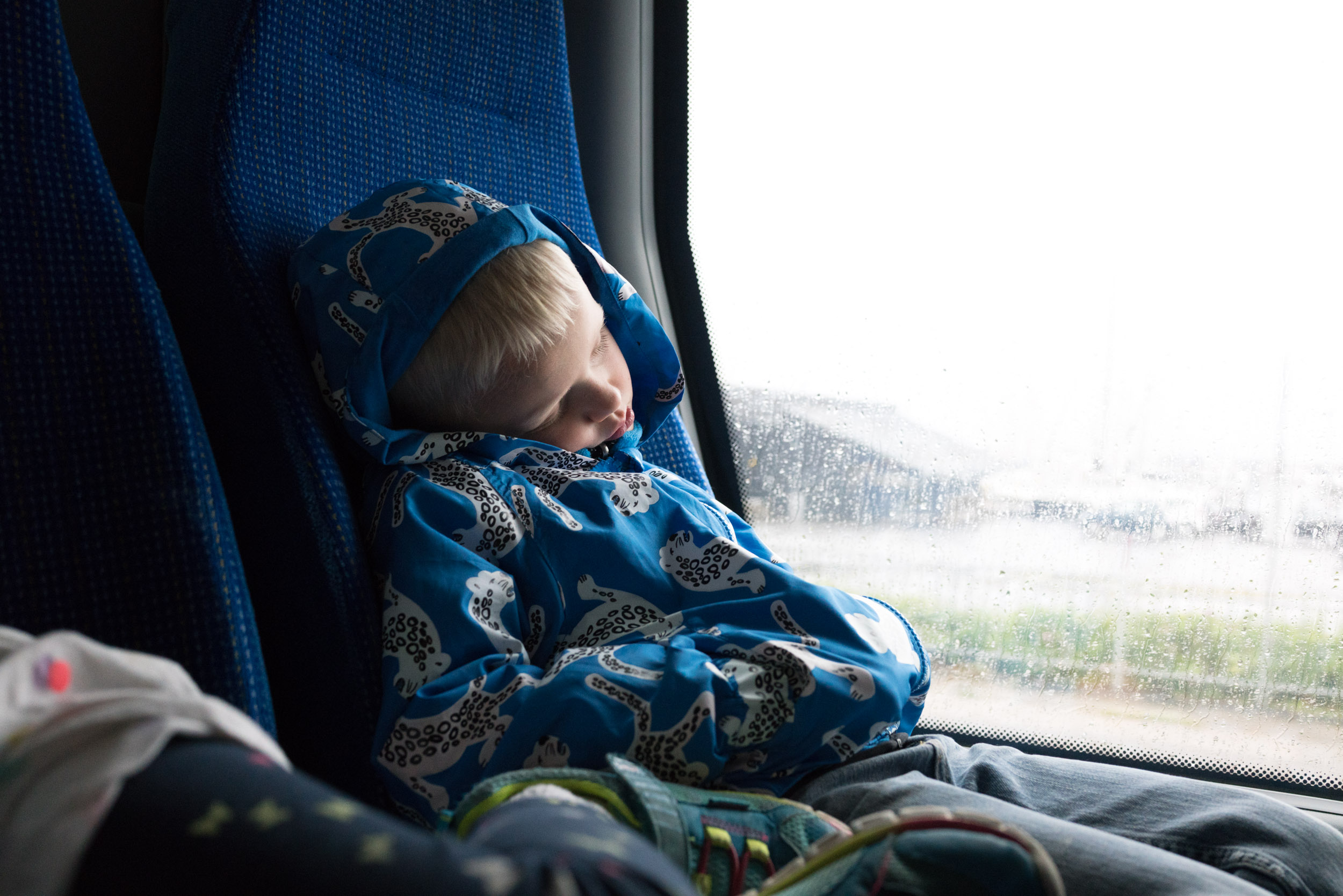
Miss Holly Chair
Yes, another favorite from Jonas Lindvall, our favorite Swedish architect. We saw this chair in small shop in Hellerup, Denmark Description of the chair from Stolab, which licensed the design and manufactures it:
Miss Holly was produced with respect for the past and a feel for what is lacking today. Jonas has gained inspiration from Windsor chairs from all over the world and has created his very own version with a two-dimensional feel. Gracious and generous at the same time. A chair that is equally attractive and functional, and whose many details testify to the designer's professional skill and love for wood as a material. Miss Holly is equally attractive alone or in a group. Its seating height is suitable for most dining tables.
Check it out on the Stolab website. We are seriously considering ordering 10 for our new dining room.
Arne Jacobsen Station Wall Clock
Arne Jacobsen's Station wall clock is an iconic Danish design dating back to 1939. As we toured Copenhagen on our family trip this summer, we couldn't help but fall in love with this clock. The Airbnb that we stayed at in Hellerup had the smallest size hung in the living room. It was the only piece of art adorning the wall—absolute perfection. We don't sell the Arne Jacobsen line but we ended up buying one of the clocks for our home directly from their main website.
Samsung Serif Television
Samsung's newest television, the Serif, opens many possibilities for integration into the modern home. A long time ago, TV's were built like furniture, and it's nice to see the pendulum of design swinging back in this direction. View more information on Samsung's website.
Peace Industry
Peace Industry began with a gift. In 1999, Dodd Raissnia bought his friend Melina, a painter and graphic designer fresh out of Chicago Art Institute, a little felt rug that he found in a craft shop in Tehran. When the pair became a couple, they wanted to build a business together. Melina, completely charmed and intrigued by this ancient craft, encouraged Dodd to take her to Iran to find more rugs. Their original idea was to import and sell them. But when they traveled to Tehran in 2001, they discovered there was not an ample supply of felt rugs available. The felting tradition, practiced by nomads for thousands of years, had almost entirely died out. Dodd and Melina decided to try to make their own rugs using Melina’s designs.

Dodd, a native of Tehran, found a local artisan who was able to produce Melina’s rug. This first piece was so well received that the couple was encouraged to go forward with their venture. Ultimately, Melina and Dodd outfitted a factory in Iran. They wanted to both expand and control the quality of the rug production. They began training local workers in the nearly lost art of producing felt rugs.
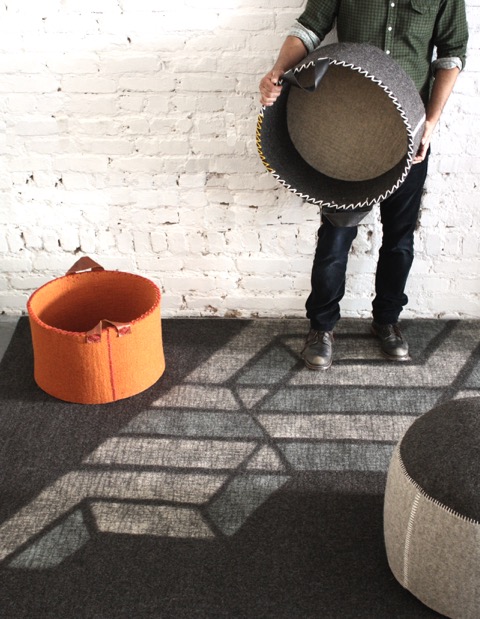
Through trial and error, constant research and innovation, Melina and Dodd arrived at a process that generated a durable, hard felt of high quality. Peace Industry rugs are made from carpet-grade lamb’s wool, which is plentiful in Iran. Dodd and Melina use a wool that is both tactilely appealing and wears well.
I spoke with Melina and Dodd in their Peace Industry showroom in San Francisco’s Mission District. Walking in, I was completely taken by the warm, engaging rugs with simple, modern designs. Melina’s shapes feel organic and natural, but also very clean. I was also taken with Melina and Dodd. Melina has wavy, dark brown hair and a big, magnetic smile. She frequently let out a deep, kind, outrageous laugh while sharing the story of Peace Industry with me. Dodd, tall and elegant, interjected and clarified periodically. They have been working and creating together for nearly twenty years and the comfort and ease between them is apparent.
AM Can you explain the felt making process?
MR In order to make a felt rug, you need a big floor with a drain and a large woven mat called the mother cloth. You arrange carded wool on top of the cloth and press it down with big, wooden forks. Then you sprinkle it with hot water. The rug keeps getting pressed down and walked on until you place another layer on top.

DR The pattern is made upside down. These women (showing me photos of felt makers from a century ago) are felting in the Turkoman region of Iran. They are rolling the rug and using the pressure of their arms to press it down.
MR That’s felting. And it’s still the same process - it’s the weight of people’s bodies.
DR The rug starts out almost twice as large and it is shrunk into the final size. But it doesn’t shrink perfectly. In order to keep the design you want, you have to constantly manipulate it, pull it, beat it, and sculpt it, so you are straightening the edge as it’s shrinking.
MR The edges of our rugs are all hand-rolled.
AM Can you talk about how the rugs are eco-friendly?
MR We don’t use any chemicals in the manufacturing process. We don’t put a backing on the rugs so you don’t need a rug pad. You just lay the rugs right on the floor. The only by-product of the process is dirty, sheepy water.
DR The sheep are raised the way they have been for thousands of years. They are mountain grazed and grass fed. We buy local wool directly from the shepherds.
MR It is all from neighboring villages within a 100-mile radius from the workshop.
AM How do you create the colors?
MR We use all the natural wool colors and we also blend them to create new colors. The fog (colorway) is white wool with a little bit of black. For the non-neutral colors, we dye the white wool.
AM Where do you get your design inspiration?
MR From my own work as a painter. I also draw inspiration from other textile designers and multidisciplinary artists. Ray Eames is a really big influence on me.
AM Can you tell me about the name Peace Industry?
MR Before we got into rugs, I had a business called Peace Flags out in Point Reyes. I was making screen printed T-shirts and peace flags with the same logo that we have now. The peace flags were a response to the Iraq war. It was a lot of fun. We also made really cute baby T-shirts and peace panties and it was paying the bills. Then we got into the rug side of our business and it just exploded. We had to change the name because we decided it’s not just peace flags anymore… it’s more than that. It’s an INDUSTRY. (Melina lets out one of her big, warm laughs.) AM Are you still working towards peace through your business?
MR Our business is normalizing the relationship between the U.S. and Iran in a very small, grassroots way. We run a workshop in Iran employing 30 people. We definitely intend to expand on that by doing collaborations with artists in Iran. That’s the best way for us to use our talents. I believe that developing personal relationships and friendships builds resilience and understanding that we all share one planet.
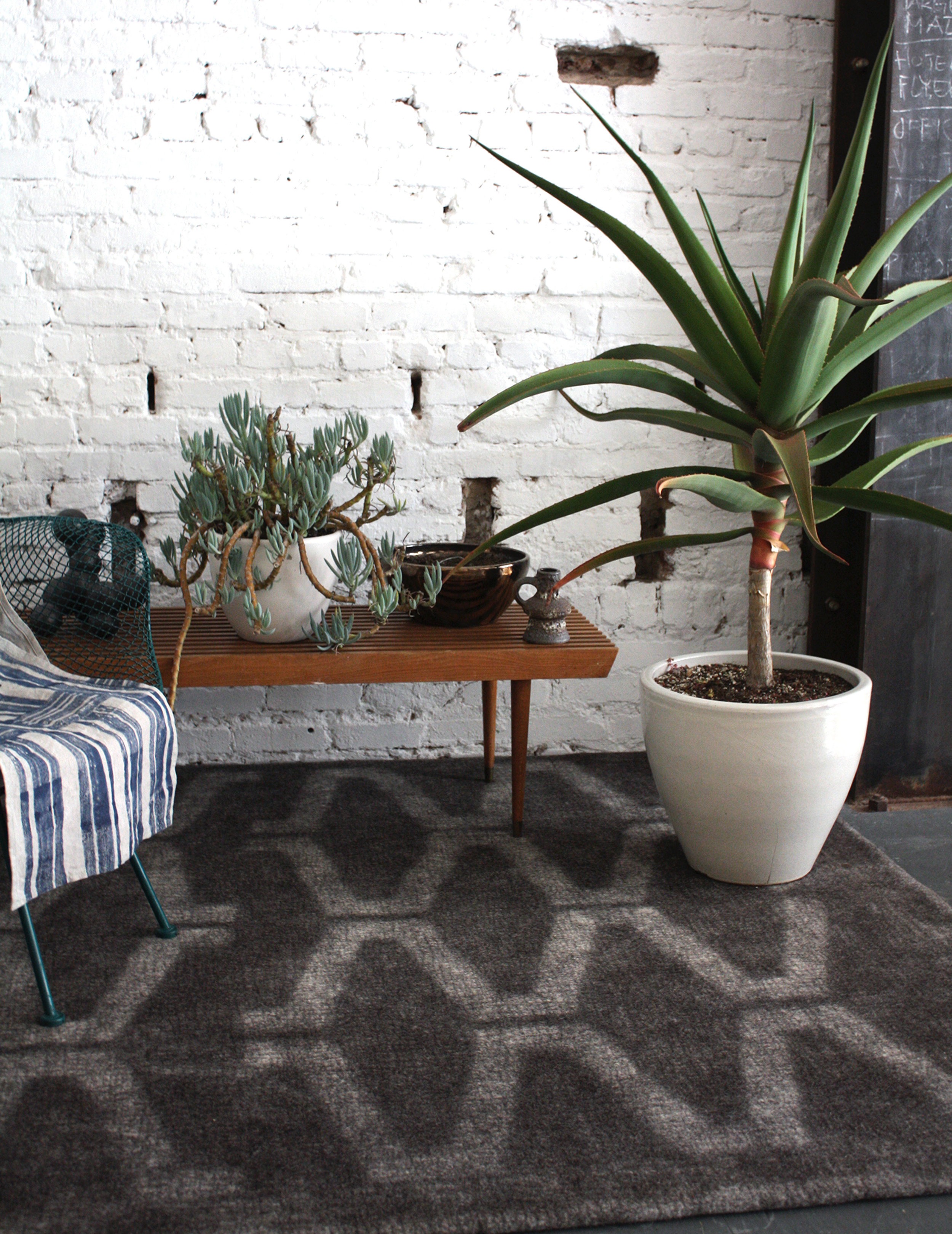
Home Accessories in Felt
So touchable! Modern pillows, baskets and rugs made from wool and other warm materials.
The archaeologists who liberated the city of Pompeii from the layers of ash preserving it made the fascinating discovery of several felt shops. The ancient Pompeiian felt merchants specialized in wearable pieces like hats, gloves, cloaks and blouses. There are murals depicting the felters at work, kneading the rolls of wool on a low table. The vats present in the work spaces indicate that they also developed a process for dying the felted wool various color ways. While these felters and their shops remain forever frozen in the moment that Mount Vesuvius erupted, felt as a textile has endured. Today, felt is available in a multitude of colors and has enjoyed special status as a favorite craft material. Used for Halloween costumes, elementary school stage sets, holiday decorations, dolly clothes and beginning sewing projects, felt has been a presence in many childhoods. Its woolly texture is tactilely engaging and elicits feelings of comfort and coziness. Felt is now being used as a fabrication for a range of home accessories that add both warmth and appeal to modern spaces.
Felted storage baskets
The following felt baskets offer a winsome means of organizing the modern home and can contain all manner of living room paraphernalia: books, magazines, blankets, extra cushions or firewood.
Muuto’s tidy, molded Restore baskets have rounded, crisp, die-cut edges.
The Korb Tote from Graf Lantz is constructed from felt flexible enough that the leather handles may be folded down for a lower profile or left upright for use as a carrier bag.
Tamar Nix of boodo creates felt storage baskets with an even, geometric cut out pattern that looks woven.
Felt accessories for cuddling up
Felt pillows and throws tucked onto a sofa encourage you to nestle in. The Pebble Cushions from Ronel Jordaan look like a collection of soft, variegated stones.
Bludot’s Duck Duck pillows come in a range of cheerful solids with refreshing, contrasted piping.
The felted cushions and blankets from Fog & Fury range from graphic striped and geometric designs to quieter, blurred compositions with raised woolen curls.
Felt in the kitchen
Felt has also made its way into the kitchen. The understated New Form Felt Bread Baskets from Menu are edged in an exposed zigzag stitch. The morning’s baked goods have never looked more tempting.
The simple Wool Felt Placemats from Graf Lantz add cozy, dimension to your table.
Felt Ball Rug Australia offer colorful, fuzzy trivets prepared to host your tea kettle or warm evening casserole.
Felt for the bath
Beyond felt, the Pompeiians of Ancient Rome were also known for their public thermal baths. How they would have enjoyed stepping out of the bathing pools onto Ronel Jordaan’s inviting felted Pebble Bath Mats.
Minimalist Pottery in the Kyoto Mountains
An intimate visit with husband-and-wife pottery artists Momoko and Tetsuya Otani at their home and studio in Japan
The Shinkansen bullet train from Tokyo to Kyoto departs not one minute late, travels almost 200 miles an hour, passes Mount Fuji on the way, and pulls into Kyoto’s vaulting modern station not one minute early. From there it’s 40 kilometers by car to Shigaraki, an industrial mountain town, where I’ve come to visit a ceramic artist whose work has transfixed me on Instagram for the past ten months.
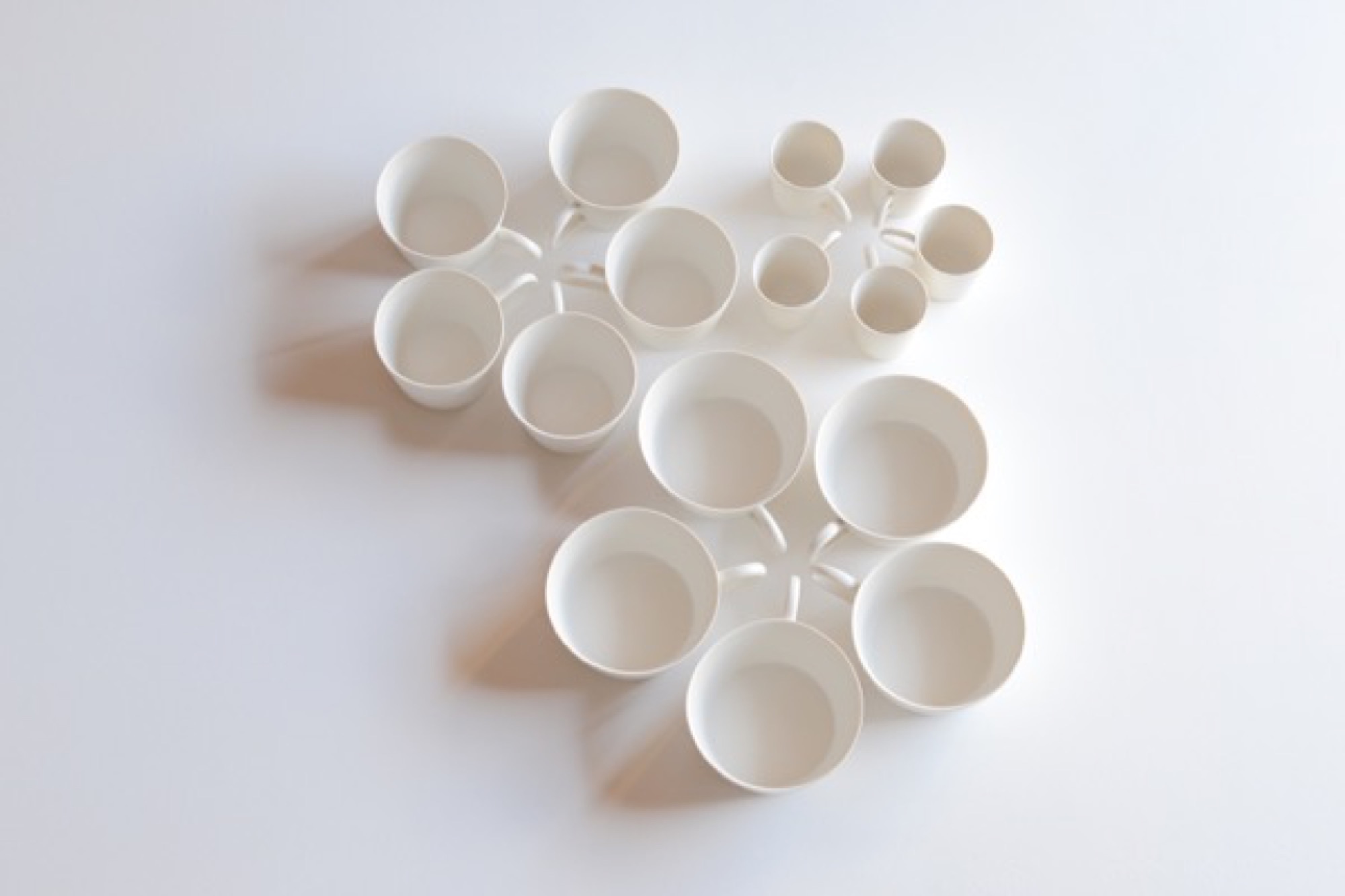
Shigaraki is home to one of Japan’s “six old kilns.” The most admired pottery here—tea bowls and sake cups made from local iron-rich clay—is often misshapen and haphazardly glazed. Much is left to the felicitous violence of earth and fire in wood-fueled kilns. These clay items, used in the exquisitely calibrated tea ceremony, are prized for their imperfections, reflecting the wabi-sabi philosophy in which earthiness, transience, roughness and decay reveal the essential nature of the world.
Such is Japan: hyper-curated, thrillingly modern, clockwork precise—then offering you a tea bowl that seems primeval.

The ceramic artist I’ve come to see, however, is Tetsuya Otani, whose work departs so thoroughly from the Shigaraki style as to seem from another world. Otani’s hand-thrown porcelain chases the precision of machine manufacture. Its skin is smooth and naked, like that of a baby. I wanted to know why he was making such beautiful but plain stuff.
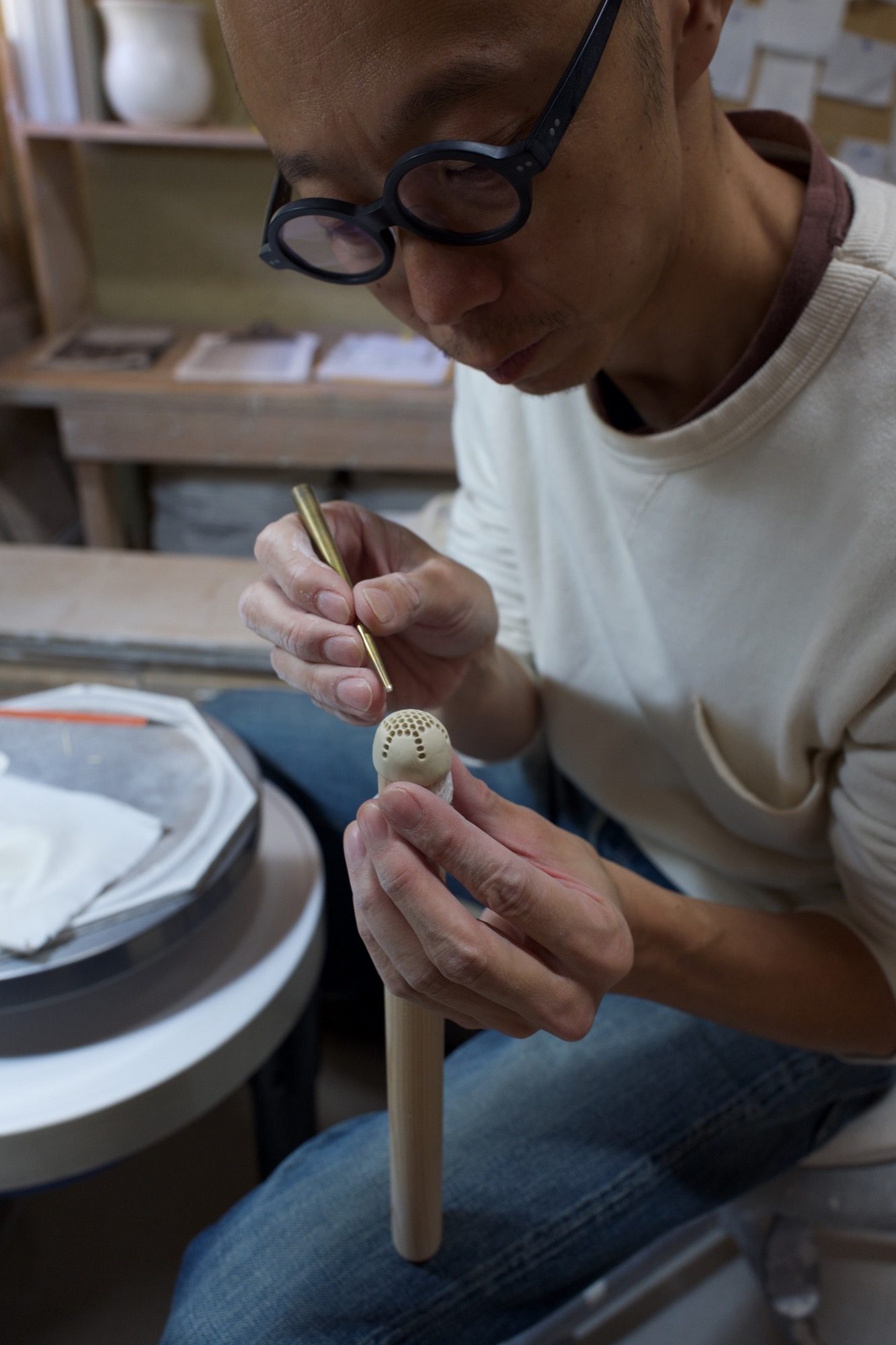
Right now, though, I have a few hours to kill, so I drive into the mountains to find the I.M. Pei-designed Miho Museum. The Miho is a kind of Japanese Getty, opened in 1997. It’s perched on a thick-forested mountain top like something a hermit might build if the hermit had several hundred million dollars. To reach it you walk through a hill via a gleaming, curving science-fiction-y pedestrian tunnel and emerge on a bridge that’s supported by a harp-string array of steel cables. The Miho was commissioned by an industrial-fortune heiress who also made time to found a sect in the 1970s, variously described as an art-centric religion and a sinister cult.
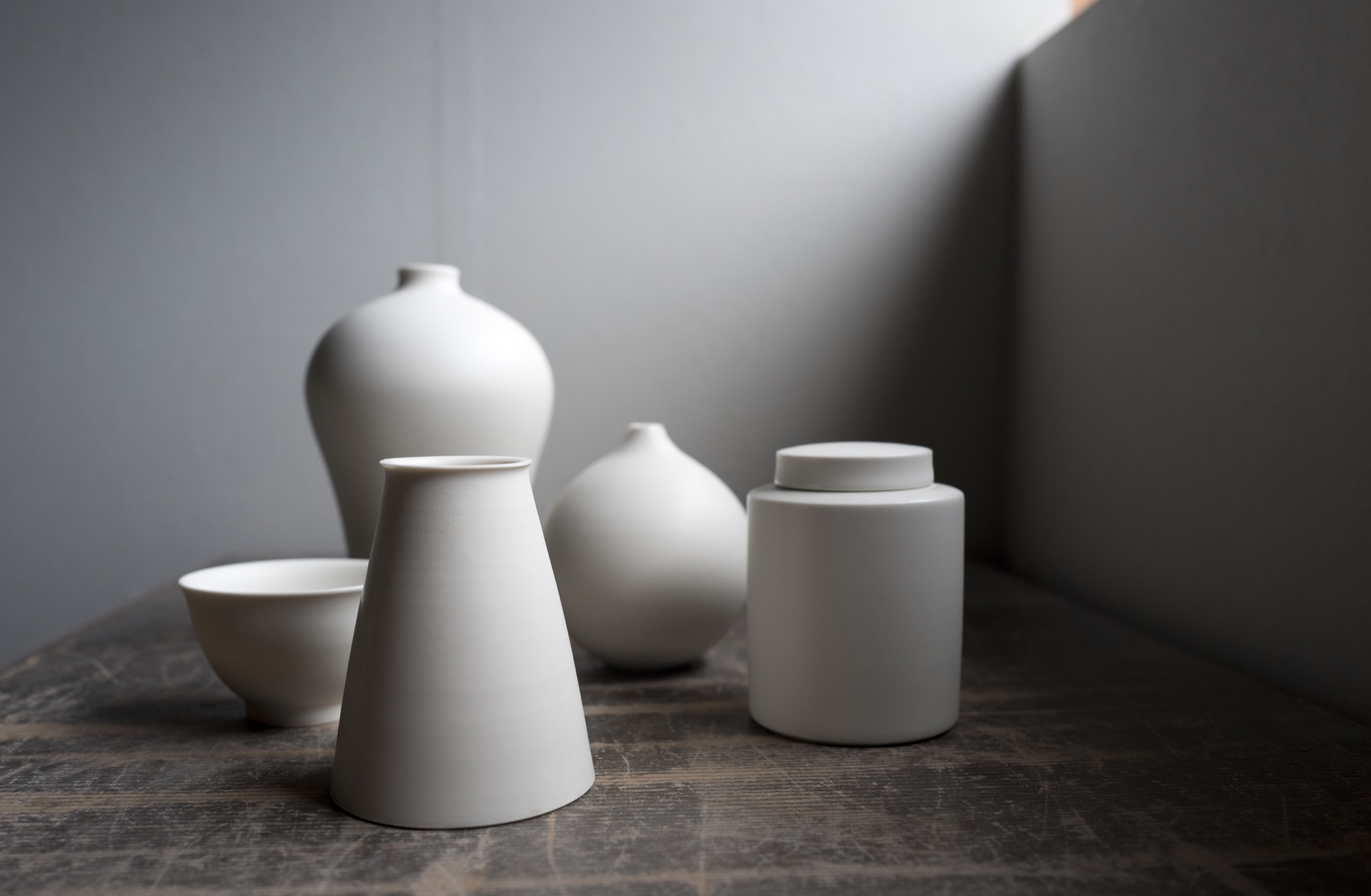
As traveler’s luck would have it, the museum is showing an astounding collection of ceramics by the 18th-century artist Ogata Kenzan, whose name means “northwest mountains.” His painted cups, bowls, and trays leave the viewer giddy, so varied and playful are they in style and form.
At home with Momoko and Tetsuya Otani
Five or so kilometers from the Miho is the home that Tetsuya Otani shares with his wife Momoko—also a gifted ceramic artist—and their three girls and a dog. It’s beautiful, with farmhouse mud walls and high wood beams that employ traditional temple joinery. Everything on the main floor revolves around the kitchen, which is far larger than usual in a Japanese house, reflecting the Otanis’ passion for communal cooking and eating with friends, many of whom also make pottery. The shelves, in the dining area and kitchen, are filled with both Tetsuya’s and Momoko’s pieces.
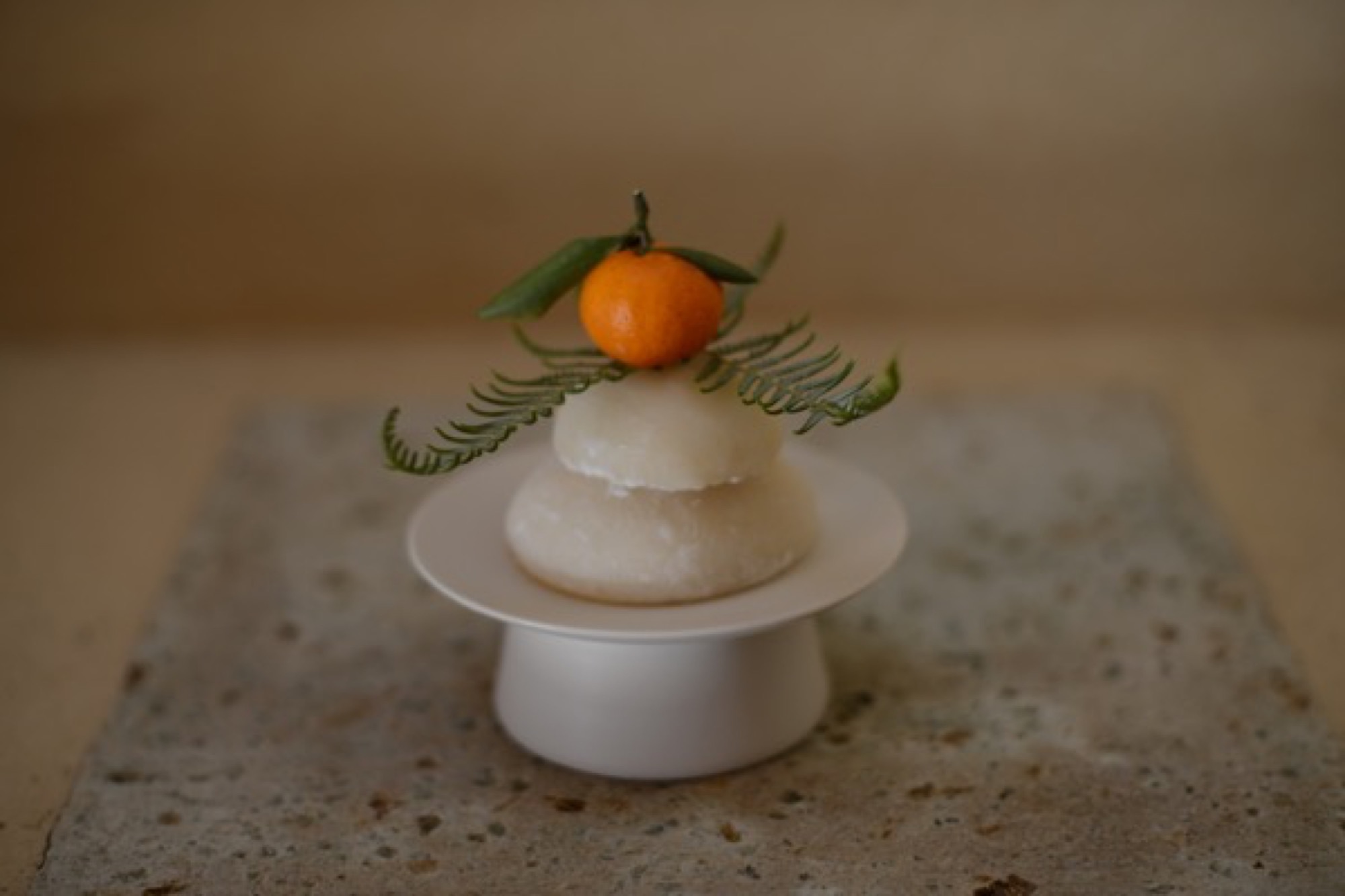
The work of Tetsuya Otani
Lately attracting attention among collectors in Beijing, Shanghai, and Taiwan, Tetsuya shuns both wabi-sabi imperfection and Kenzan decorative exuberance. Everything he makes is to be used, mostly in the kitchen or at the table: tiny matcha urns with clinking lids, curved-belly flower vases, delicately spouted teapots, tiny soy dispensers, little round boxes. The pieces are finely lipped and polished to a supple smoothness; their creamy matte glaze begs to be caressed.
Tetsuya’s pottery has thrown off all temptation toward decoration. The potter’s goal, he says, is to remove as much information as possible from his ceramics, seeking pure functional forms, because “things that work give pleasure.”
"The potter’s goal, he says, is to remove as much information as possible from his ceramics, seeking pure functional forms, because 'things that work give pleasure.' ”
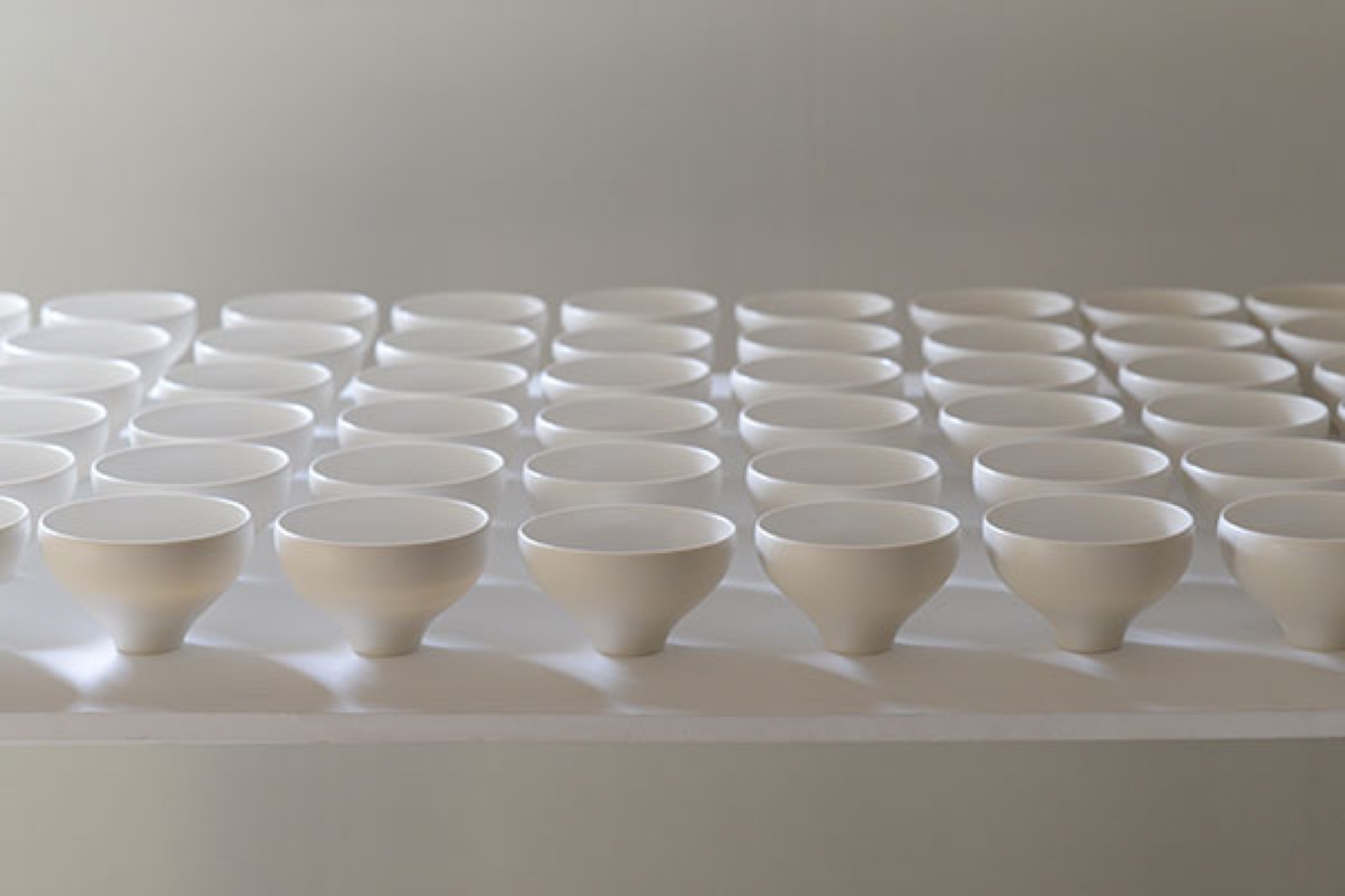
He studied in Kyoto, hoping to design cars, but when the economy skidded in the nineties, he shifted to graphics and ended up teaching product design (“how to make molds”) at the Ceramic Institute in Shigaraki, where he met Momoko and, on the side, learned throwing and glazing clay. By 2008, their house was built and he embarked on a ceramic career. He’s now in his late thirties.
I watch him work in the studio, which has wheels for him and Momoko, as he forms and pokes a bit of clay that will become a tiny strainer inside a teapot. A few feet away, a large machine mixes clay while sucking air from it, then extrudes large, irresistibly smooth noodles of the stuff. The machine is close to the same color as the clay. Tetsuya grins and admits he had it custom-painted to obliterate the standard industrial green. A clue to his fastidious brain.

The pure cup and the pure bowl
Later, we sit at the long kitchen table and look at bowls and cups and teapots and plates and discuss this idea of removing information from one’s work.
“The pure cup,” Tetsuya says, through Momoko’s translating, “and the pure bowl: They can accept anything, become a vessel for anything. Cultural information is eliminated. And then the cup or bowl can be applied to any culture.”
“The pure cup and the pure bowl: They can accept anything, become a vessel for anything. Cultural information is eliminated. And then the cup or bowl can be applied to any culture.”
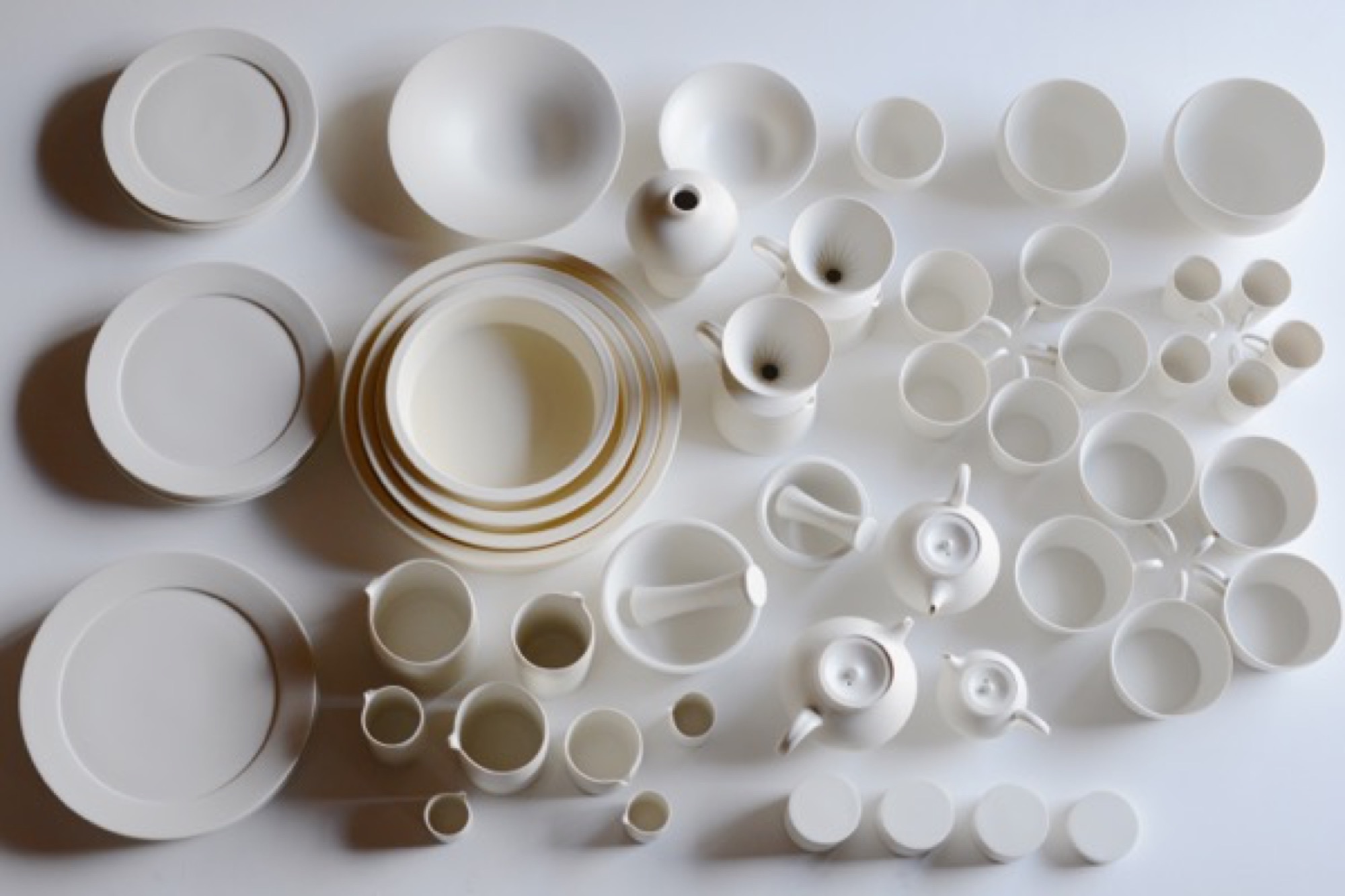
One may begin with the form of a traditional Japanese offering bowl. Decorative motifs are removed until it approaches neutrality. Eventually you “come down to the point where we can use it on our table, not for the gods’ offerings.”
Momoko adds: “Tetsuya strips the bowl of the divine.” He produces smooth dinner plates as blank canvasses for food—altars, really. They’re used in fancy Osaka and Kyoto restaurants to showcase chef art. His works are unsigned, unmarked.
“Tetsuya strips the bowl of the divine.”
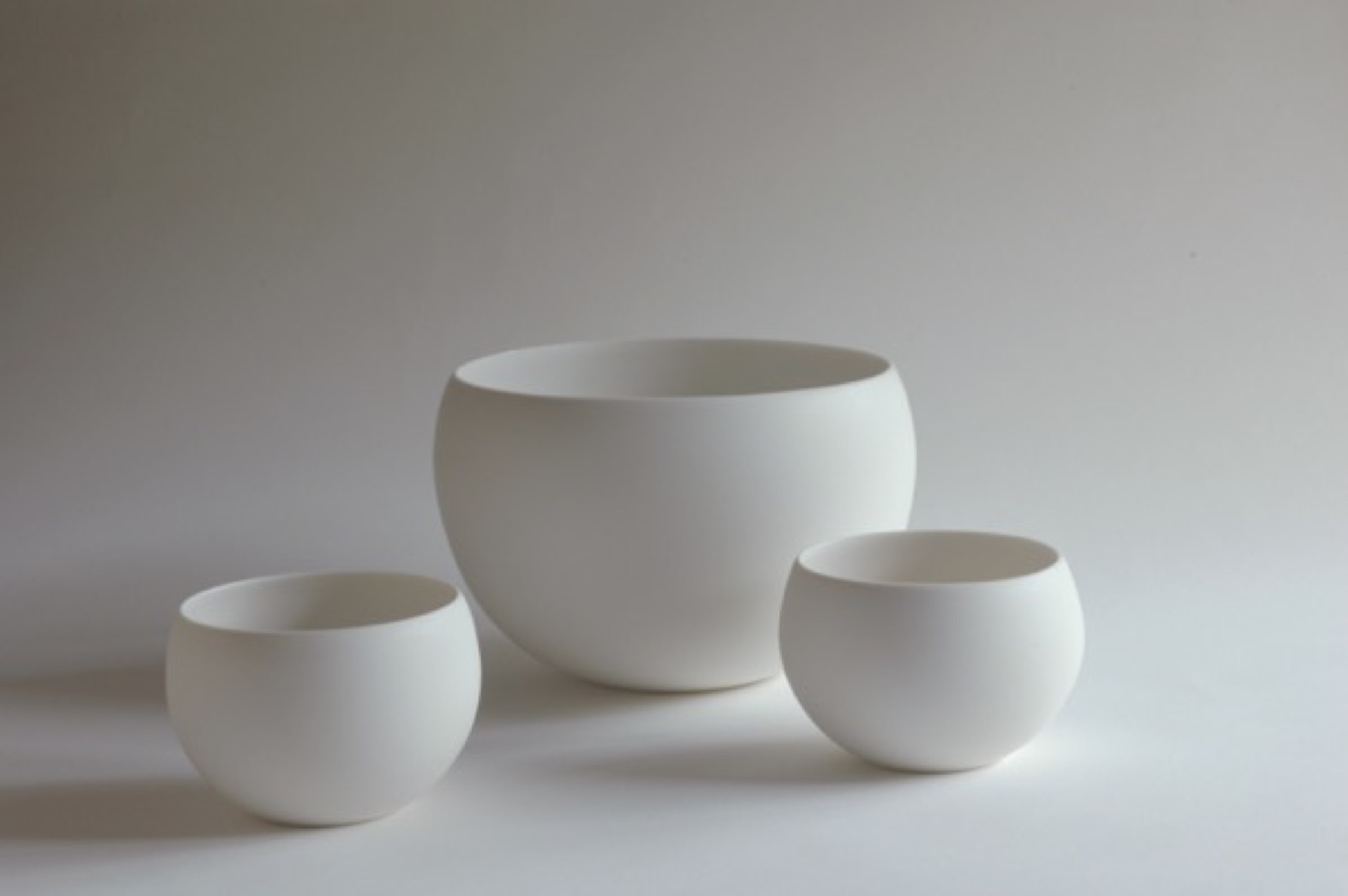
But cultural negation negates a specific culture, and Tetsuya says he has lately realized, when showing his works in China, that they are in some way indelibly, irreducibly Japanese. “I now feel that,” he says, “but I don’t have the answer yet about why I feel that way.”
The potter approaches, but never finds, ideal functionality. Tetsuya tweaks the ancient teacup form a wee bit from batch to batch, always seeking the right feel of cup in hand, the right curve of handle against thumb and finger. This lonely, incremental search for ideal form, endlessly repeated, is itself very Japanese.
The motivation is pleasure, however, not denial. Tetsuya and Momoko are exuberant foodies, and have found that their table-centric philosophy resonates globally through their gorgeous Instagram feeds, @otntty and @otnmmk, with more than 20,000 followers between the two for their pictures of utensils and food.
Tetsuya is also funny. He calls the clay mixing machine Mr. Hiroshira, “my only employee.” What about the beautiful industrial kiln in the next room, I ask? “No,” he says, “I work for it.”
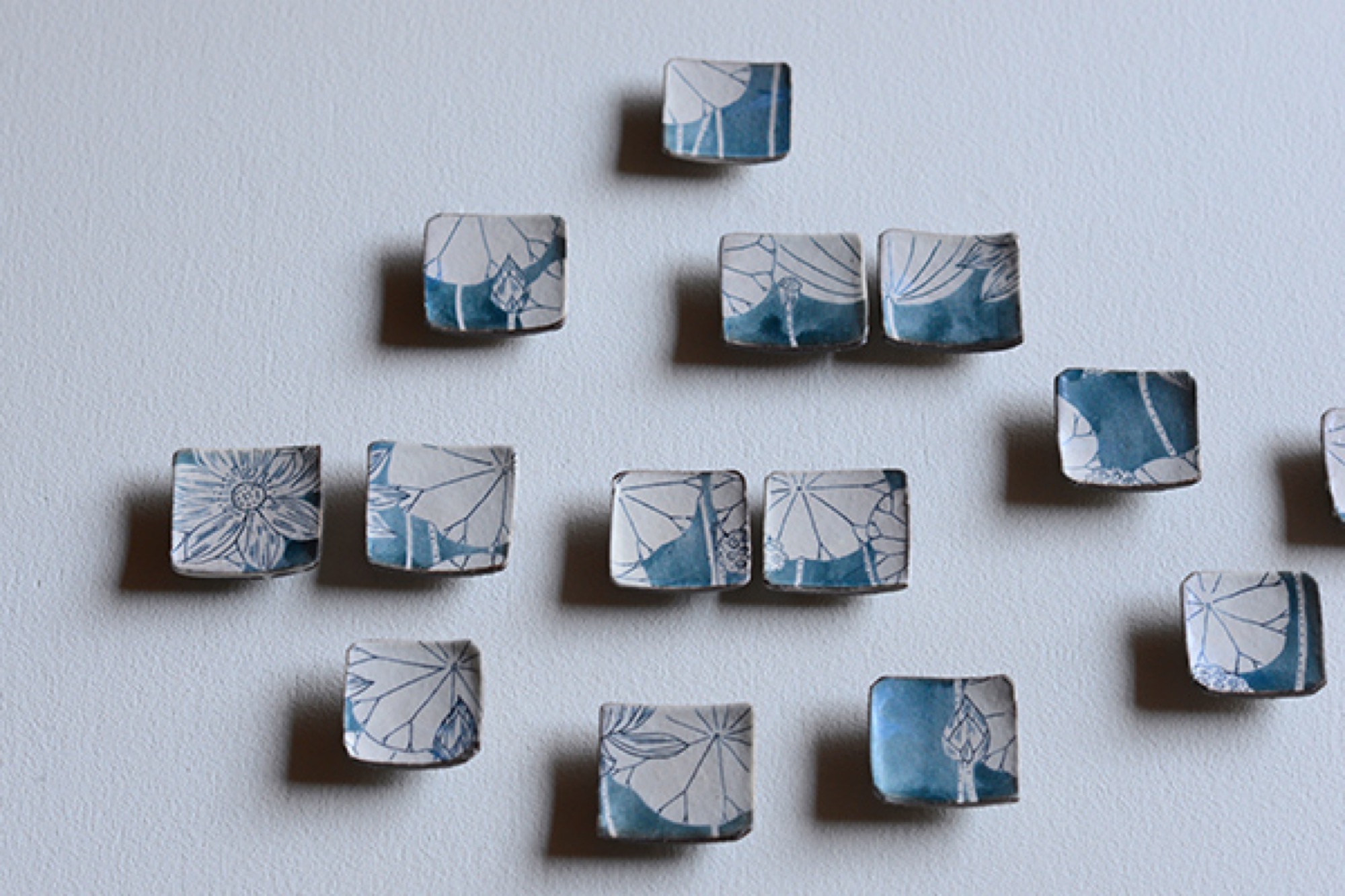
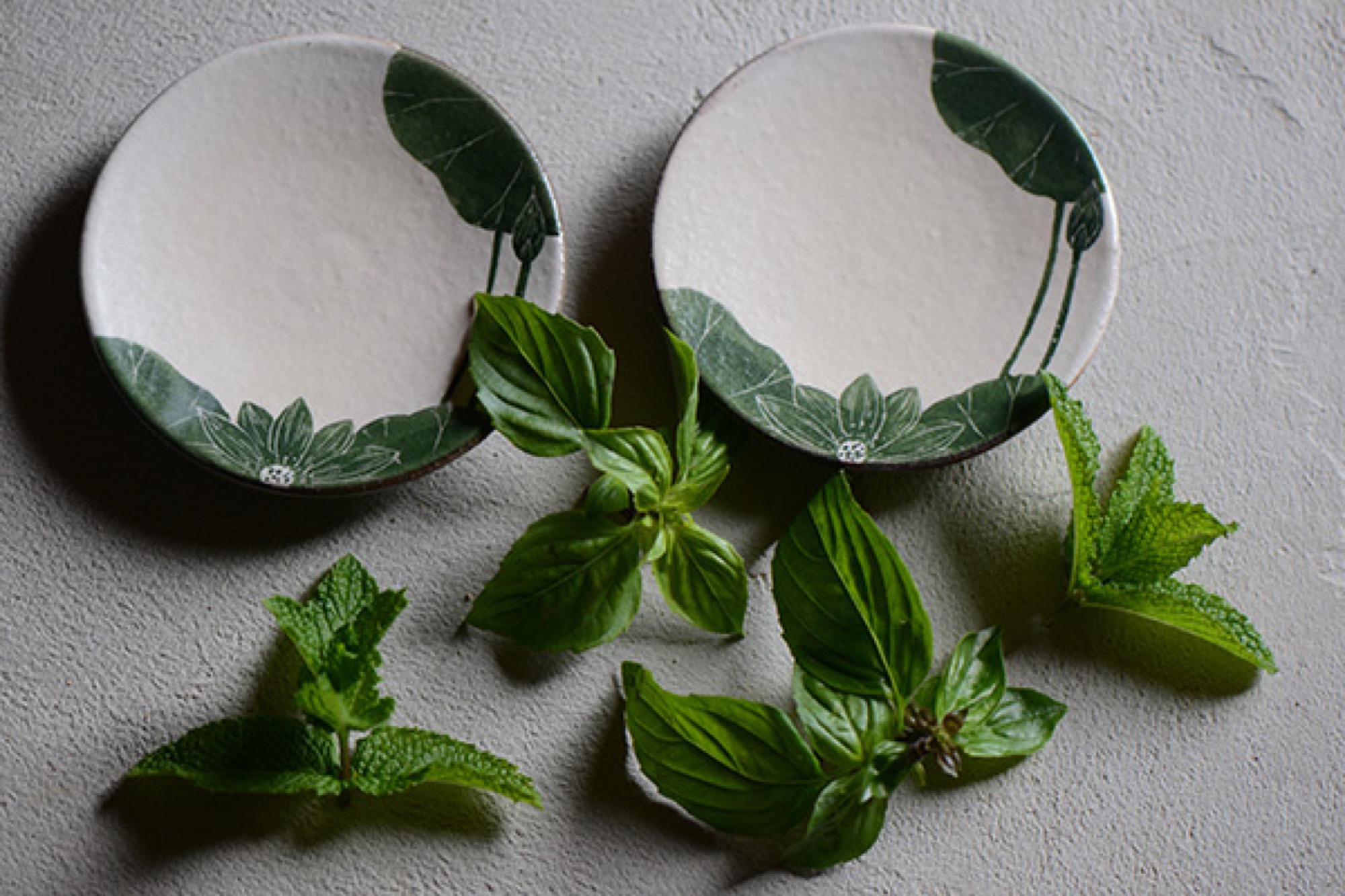
Return to Kyoto
A few nights later, in Kyoto, my wife and I visit a little chocolatier and bakery called Assemblages Kakimoto, near the Imperial Palace. In the minimalist showroom up front I buy a box of orange biscuits enrobed in dark chocolate, each biscuit not much bigger than a postage stamp. Beyond the front space is a narrow, pretty room with a half-dozen seats or so against a counter, facing a tiny kitchen. We order chocolates and cakes and glasses of thirty-year-old palo cortado sherry. Two women to our right—the only other customers in the café—have come for the chef’s omakase dinner. With each course they look gobsmacked, enraptured by the treats placed in front of them. It’s beautiful food, for that is the Kyoto style. Each composition sits on the pale canvass of an Otani plate.
The entanglement of much fuss and no fuss that lies at the heart of many things Japanese is hard to describe, but when I palm one of the Otani pieces that we brought back from Japan, it seems to embody that contradiction. My favorite is a little round vase, the size of a tennis ball, whose satin smooth sides curve up to a sharp-lipped hole that’s big enough to accommodate the stem of a single bud. In weight and delicacy and touch and every other aspect the vase seems, to me, as close to perfect as it can get. It holds a lot of information about Japan. △
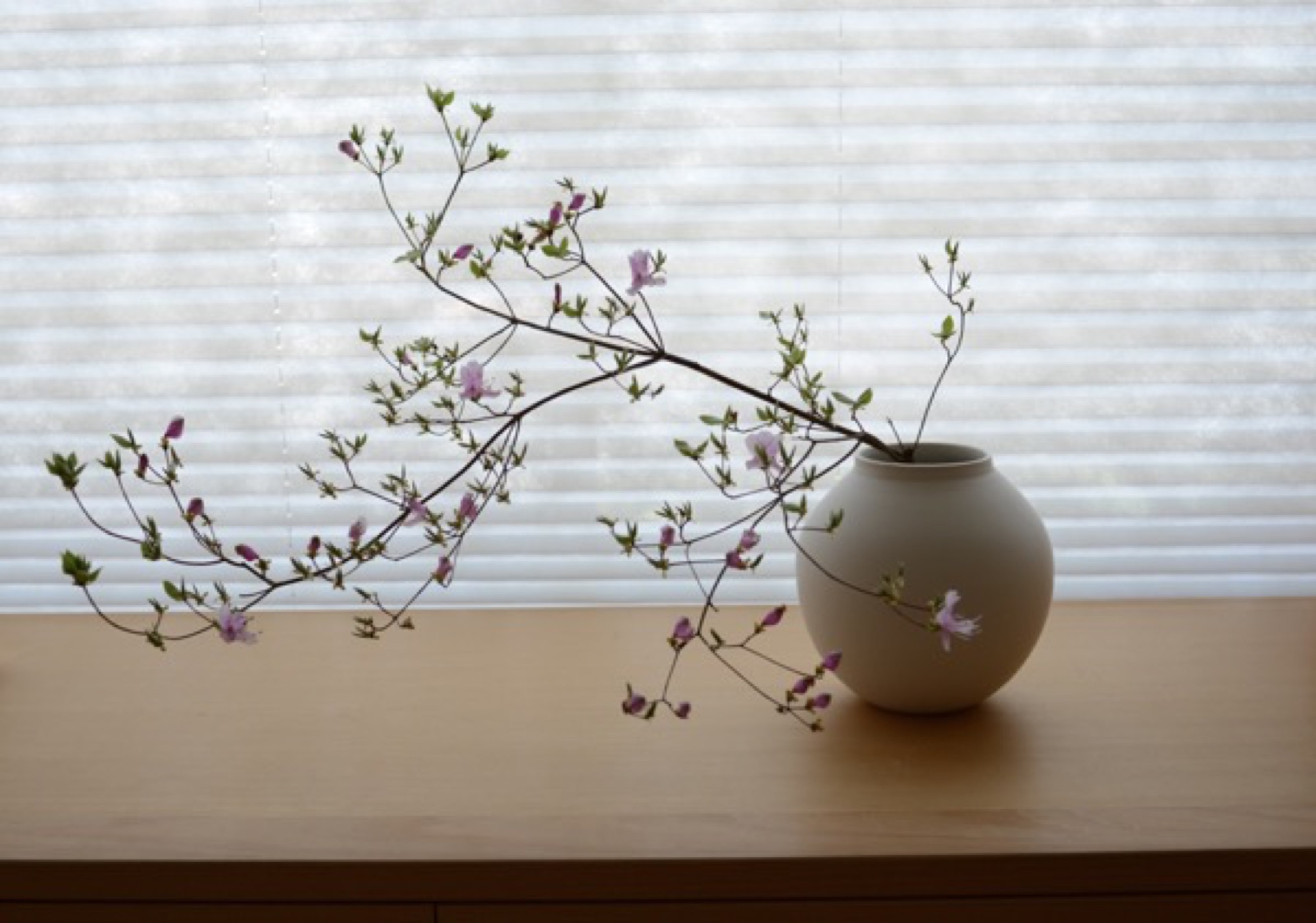
The Line between Everyday and Heirloom
A Visit to the Lake Tahoe Home of the Owners of Heath Ceramics
“In the winter, everything is dead, and in the spring, everything comes to life,” says Catherine Bailey as she looks out the window of the Tahoe home she shares with her husband, Robin Petravic, and son, Jasper.

Bailey and Petravic are the driving forces behind a reinvigorated Heath Ceramics, the Sausalito, California-based company that was started in midcentury by Edith Heath and given a dose of new energy by the couple in 2004.
When taking the tour of the Heath facility, the guide explains that, at its essence, the company aims “to straddle that line between the everyday and heirloom,” words that perfectly describe the experience of Bailey and Petravic’s Tahoe home in California’s Sierra Nevada.
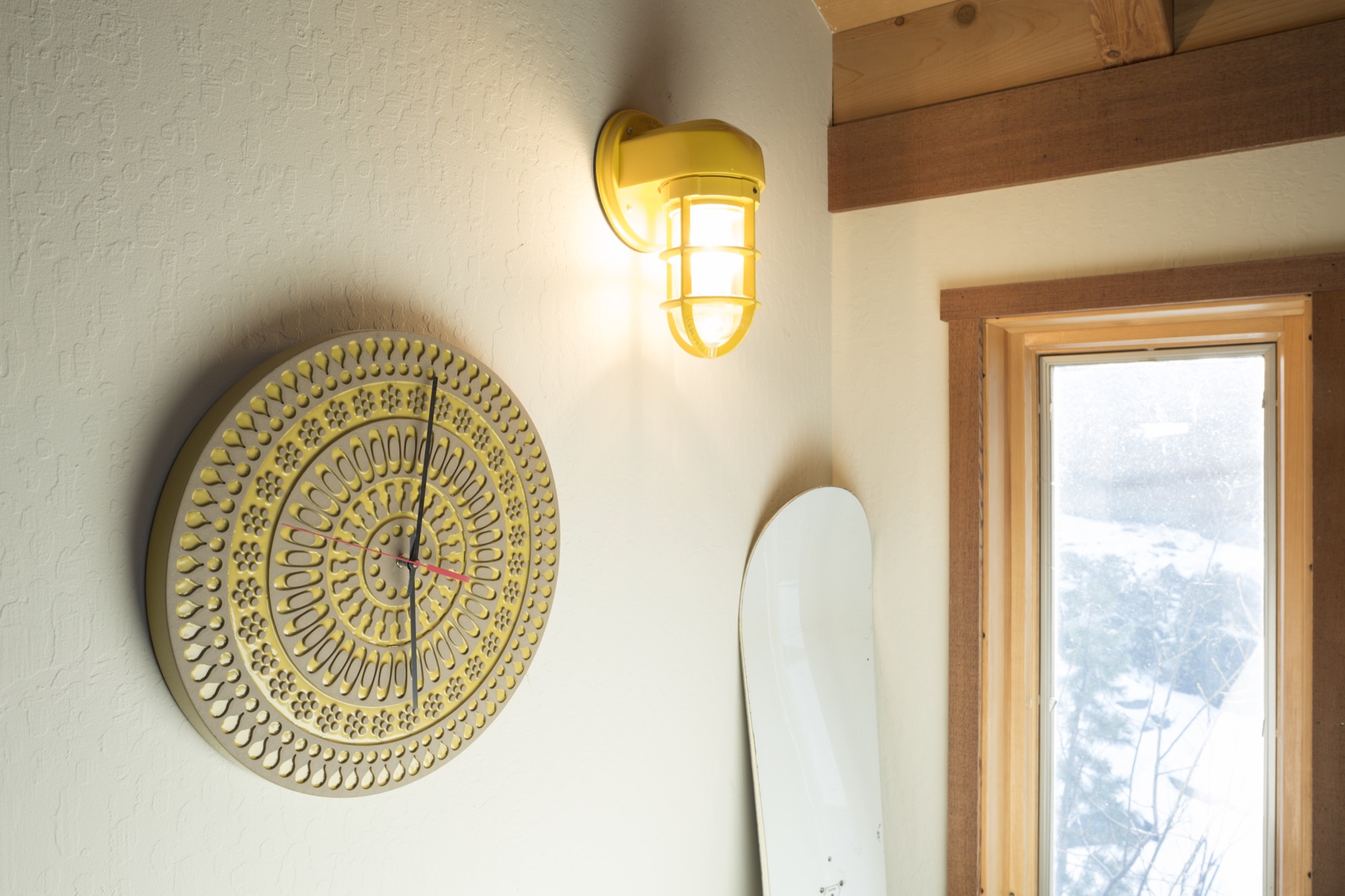
Finding the house (or being found by the house)
The couple are avid winter sports enthusiasts—Bailey had consulted for many years as a product designer for a large snowboard manufacturer—and had been looking for a weekend escape for some time when their real estate agent called about a listing in their desired area of Alpine Village. They were so excited about its location and the fact that they could walk to the slopes of Alpine Meadows Ski Resort that they made an offer on the house sight unseen.
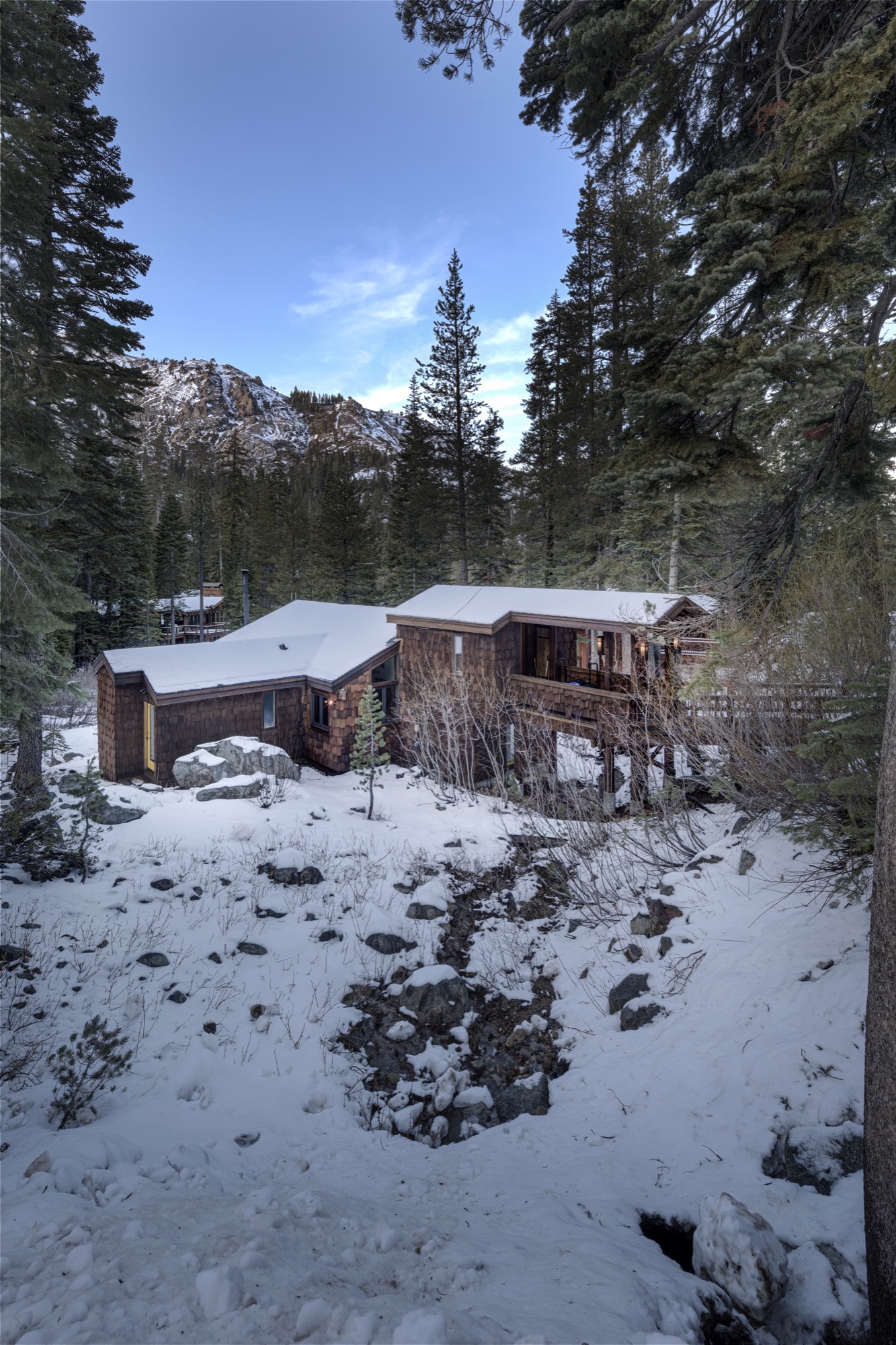
When they did finally see the house, they were immediately taken by its placement on the lot, how it cascaded down the hill to the creek below and was framed by the dramatic mountain peaks behind it.
At the same time, they were underwhelmed by some unfortunate interior decorating choices. “Everything was green—green carpeting, green cabinets, and green linoleum,” a design aesthetic Bailey laughs about. “I guess the former owners thought, ‘We’re in the mountains, so we should make things the colors of trees.’ ”
The couple was able to look beyond the green, however, and fell in love with the bones of the house, especially its beamed wooden ceilings and reclaimed wood doors.
Making it modern
After purchasing the home in 2012, they embarked on what Bailey calls “a low-hanging-fruit” remodel. Her method was to “always look back to 1974, when the house was built, and not mask that, but make it feel nice for today. The brown of the wood beams and doors with bits of orange, yellow, and red resonate with the mood of that period,” she says. “The interior feels fresh and bright without having to paint everything white.”

It’s easy to draw a comparison between the house remodel and what Bailey has done with Heath as creative director. “We didn’t find it very interesting to just have a nostalgic company where you are just trying to recreate the past,” she says.
Instead, the past becomes inspiration for moving forward. “Our philosophy has been to look back to where you’ve been and what you’ve done and don’t ever run away from it, but to learn from it.”
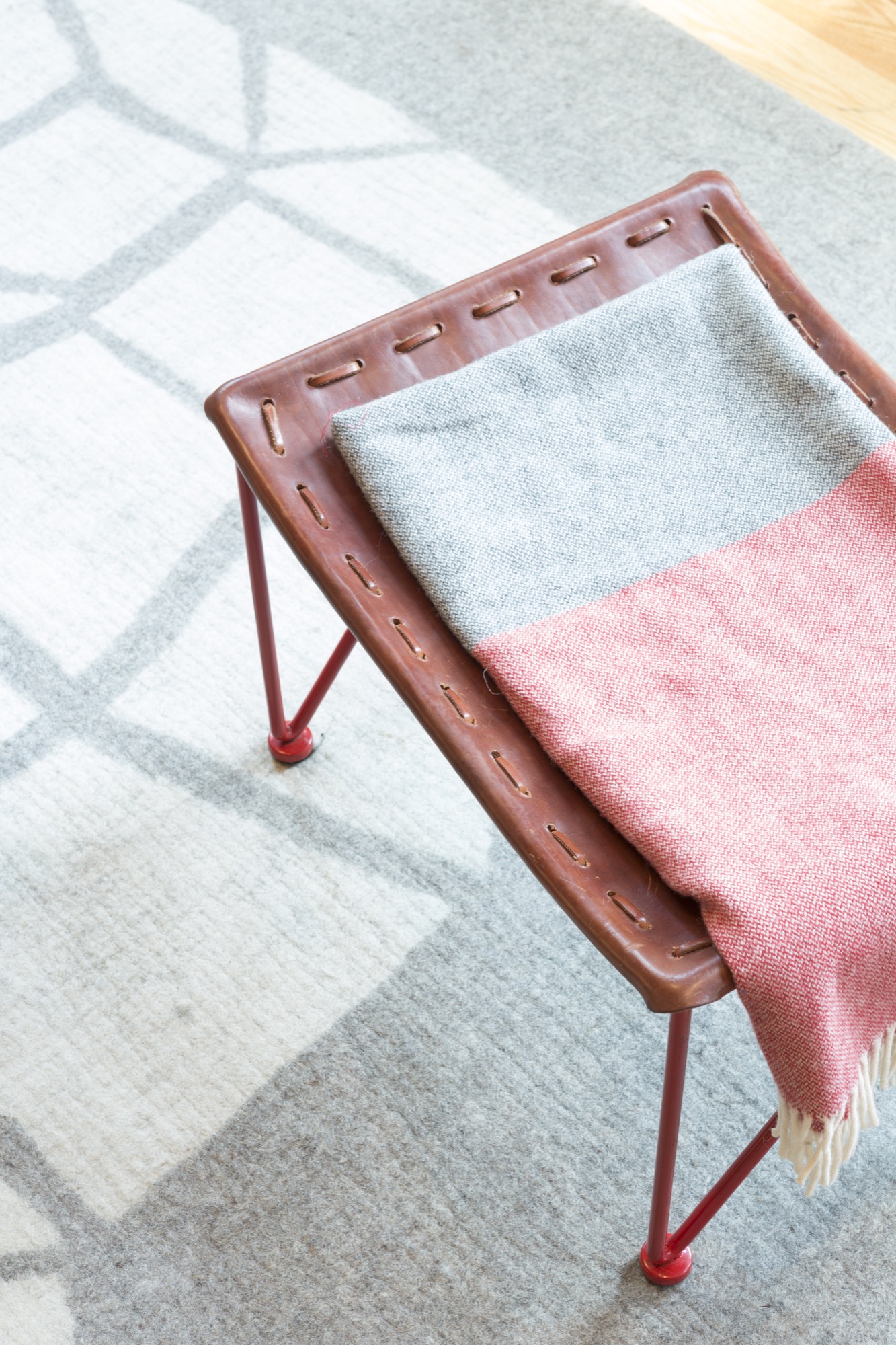
“Our philosophy has been to look back to where you’ve been and what you’ve done and don’t ever run away from it, but to learn from it.”
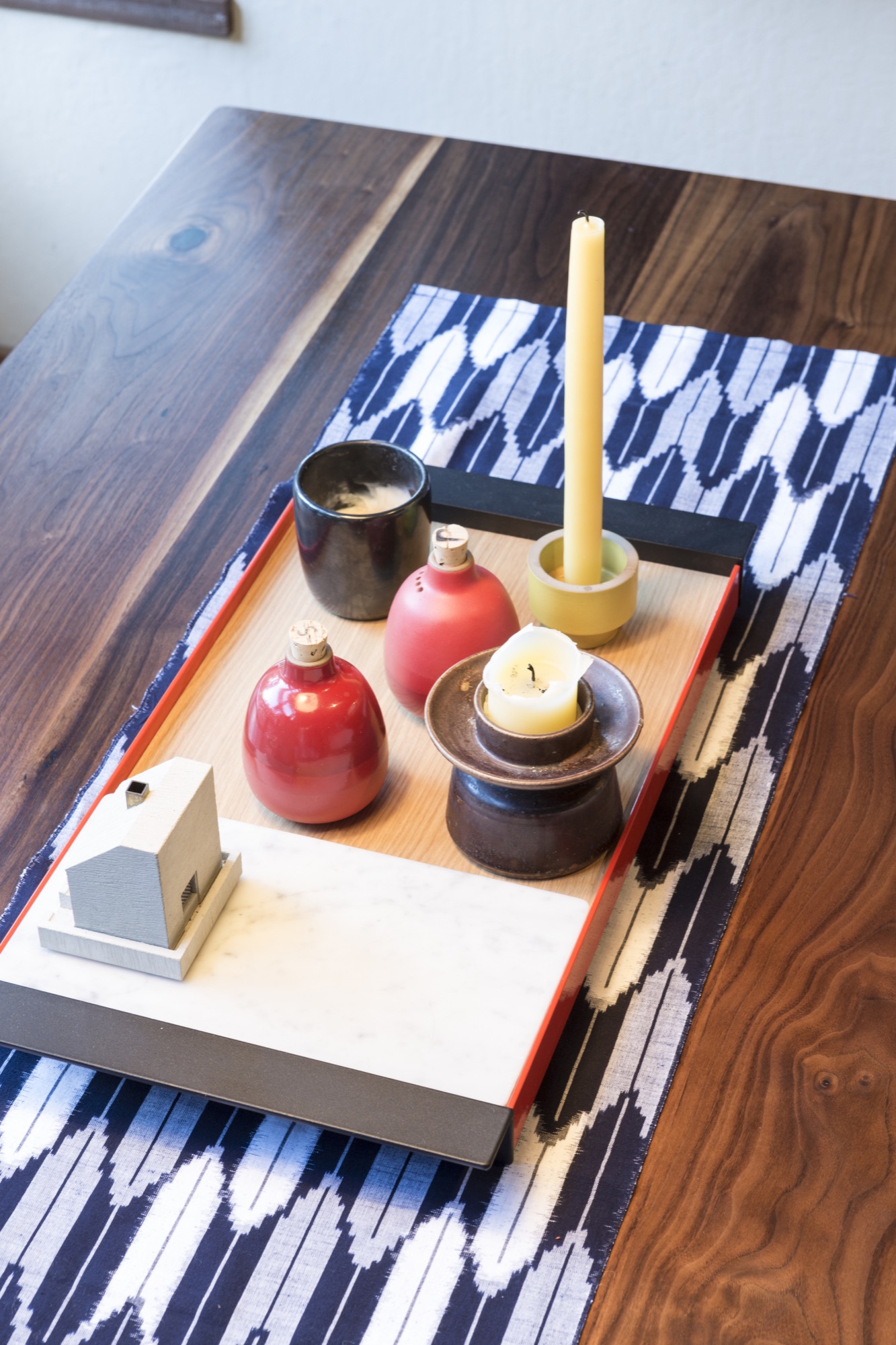
Heath ceramics
Heath was founded in 1948 by Edith and Brian Heath and is famous for its handcrafted stoneware and distinctive glazes. Under Bailey and Petravic, it continues to produce and design midcentury tableware and tile in its California factories, but the couple have expanded the company with a business model driven by “design-led manufacturing principles, and in the belief that responsible business practices lead to long-term viability.” Since purchasing the company, they have added new colors, opened a new tile manufacturing factory and showroom in San Francisco, and started up a Los Angeles studio and showroom. Most importantly, they have expanded the brand through successful collaboration with designers and ceramic artists from around the world.
“We are always looking for the next creative opportunity that fits with what we love to do: the materials we love to explore and the people we want to work with,” Bailey explains. Those successful collaborations run the gamut from the prolific Fresno-based ceramic artist Stan Bitters and the well-known type designers at House Industries to the Mexican artist and designer Carla Fernández.
Tahoe sleepover
This spirit of openness is also reflected in the Tahoe house.
At 1,450 square feet (135 square meters), it’s a relatively small house with one big living area. But the couple was committed to finding a way to sleep a lot of people and their kids. Every bedroom has a loft with an additional place to sleep, so you can fit a family of three in each room. “We also turned the laundry room into a bedroom,” says Bailey. At times, there are three families staying at the house all at once. “That’s why we come here,” she says, “to spend time with people we want to spend time with. You don’t normally get to have your friends over to sleep at your house for the weekend.”

The couple also uses the house as a refuge and escape from the demands of running a hectic Bay Area business. The breathtaking living-room views of the Squaw Valley peaks provide the seclusion and isolation that they love. “You’re in a wonderful gem in the big outdoors—it’s kind of big out there—and there’s not a lot coming at you. That’s what makes it inspiring and special,” Bailey says.
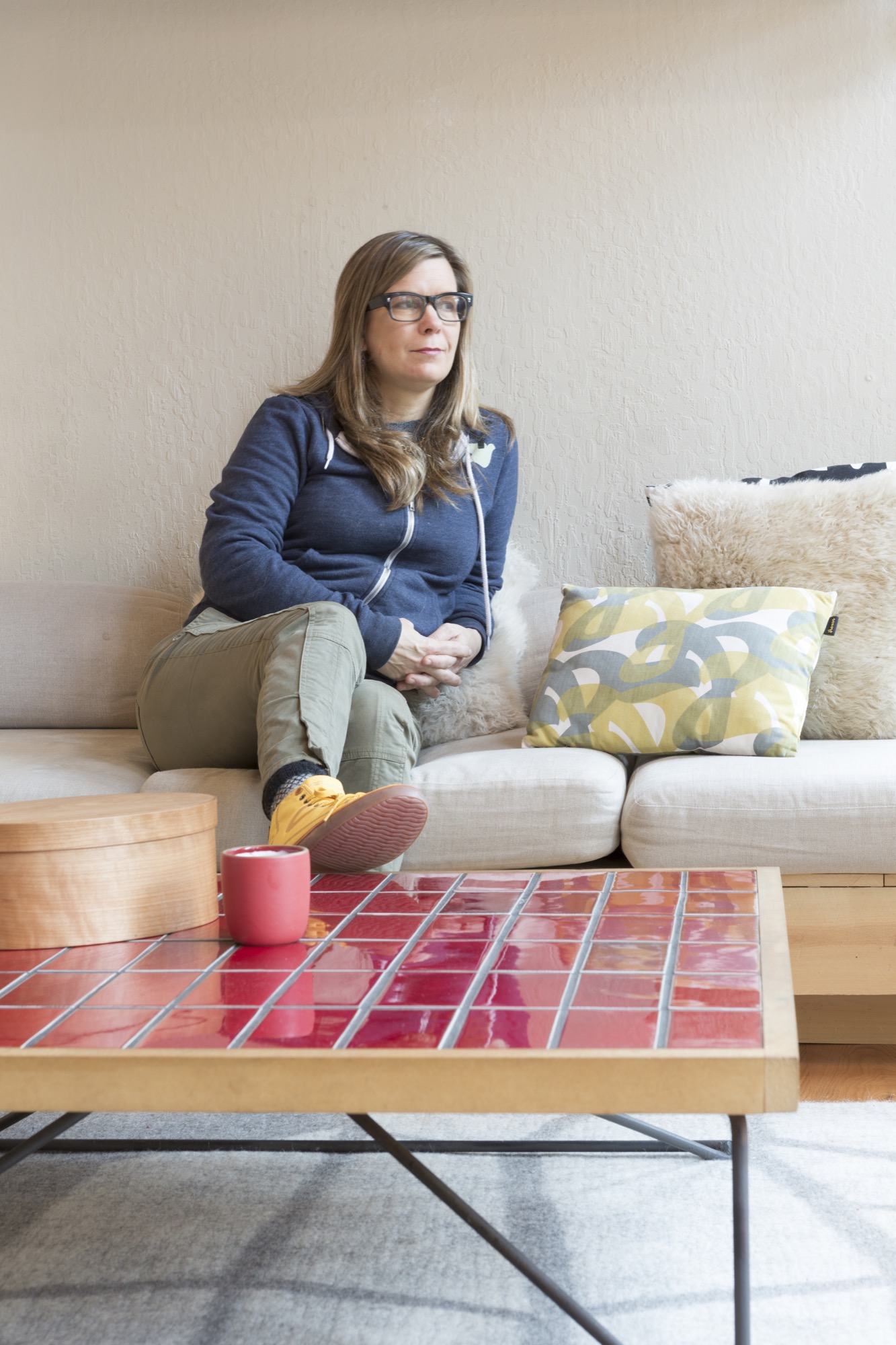
Her seat of inspiration in the house is the couch. The expansive view opens up from there. “In the afternoon the light comes in across the fireplace, and it really gives you this great sense of time of day because there is no direct light until late afternoon.” At that moment “you think, ‘Is my day going like it should have?’ It’s your last chance to get out and take a walk and make the most of your day. It’s like an alarm clock, and it’s the sun, and I’m reminded that I want to get outside.”
“That’s why we come here, to spend time with people we want to spend time with. You don’t normally get to have your friends over to sleep at your house for the weekend.”
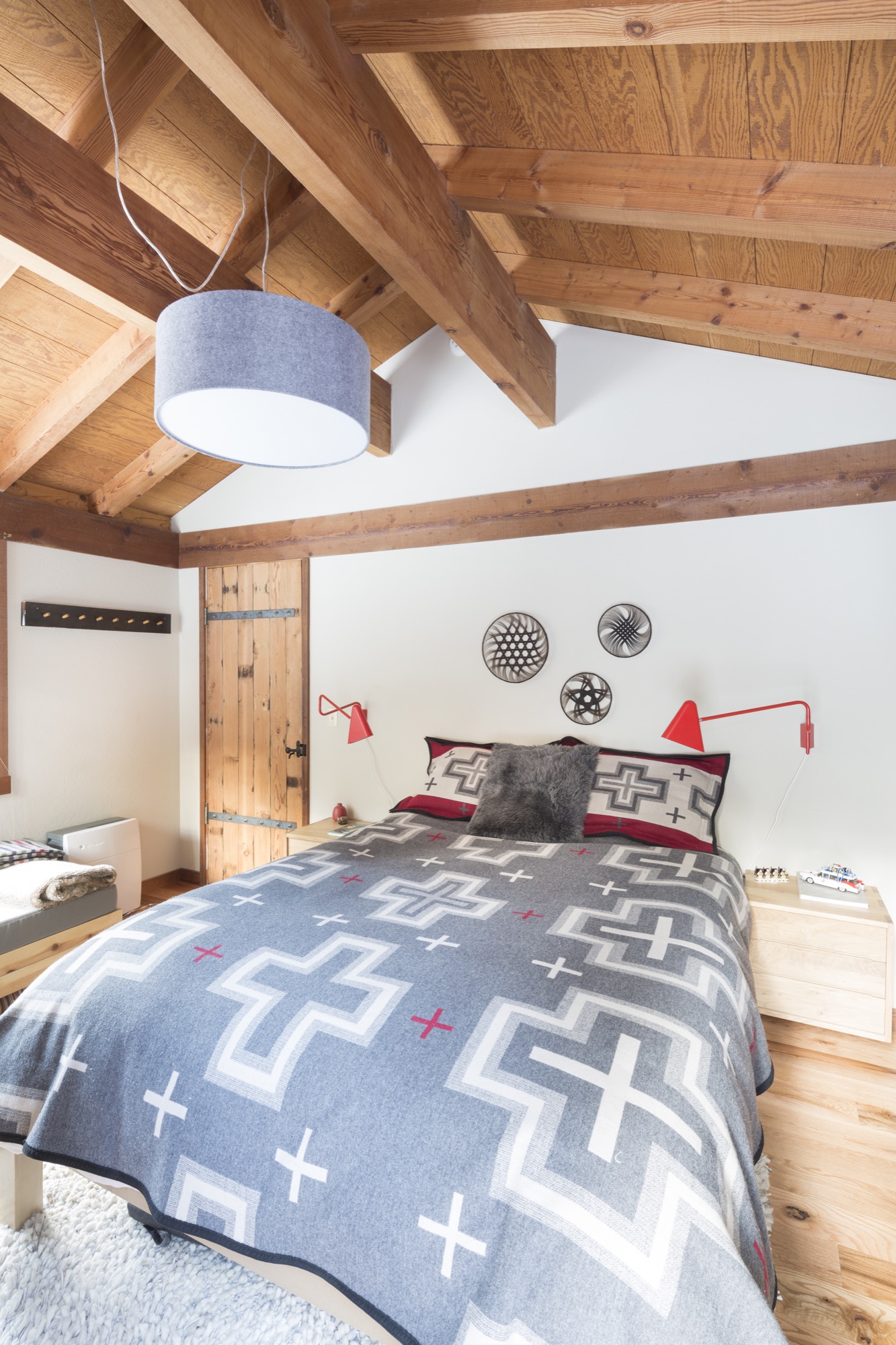
A place of inspiration
This sense of place—Tahoe, the outdoors, the sun, the mountains, the sky, the colors—serves as creative inspiration for Bailey. “When you are in that environment, there are all these base colors that ground you—make you feel the whole place, and then there are little points of vibrancy.” It’s an environment that is not bright colors all the time. “It’s subtle,” she says, “and the granite of the mountains is part of that, at least where we are. Granite grounds it colorwise. We are not on the lake, which is that crazy vibrant blue color.”
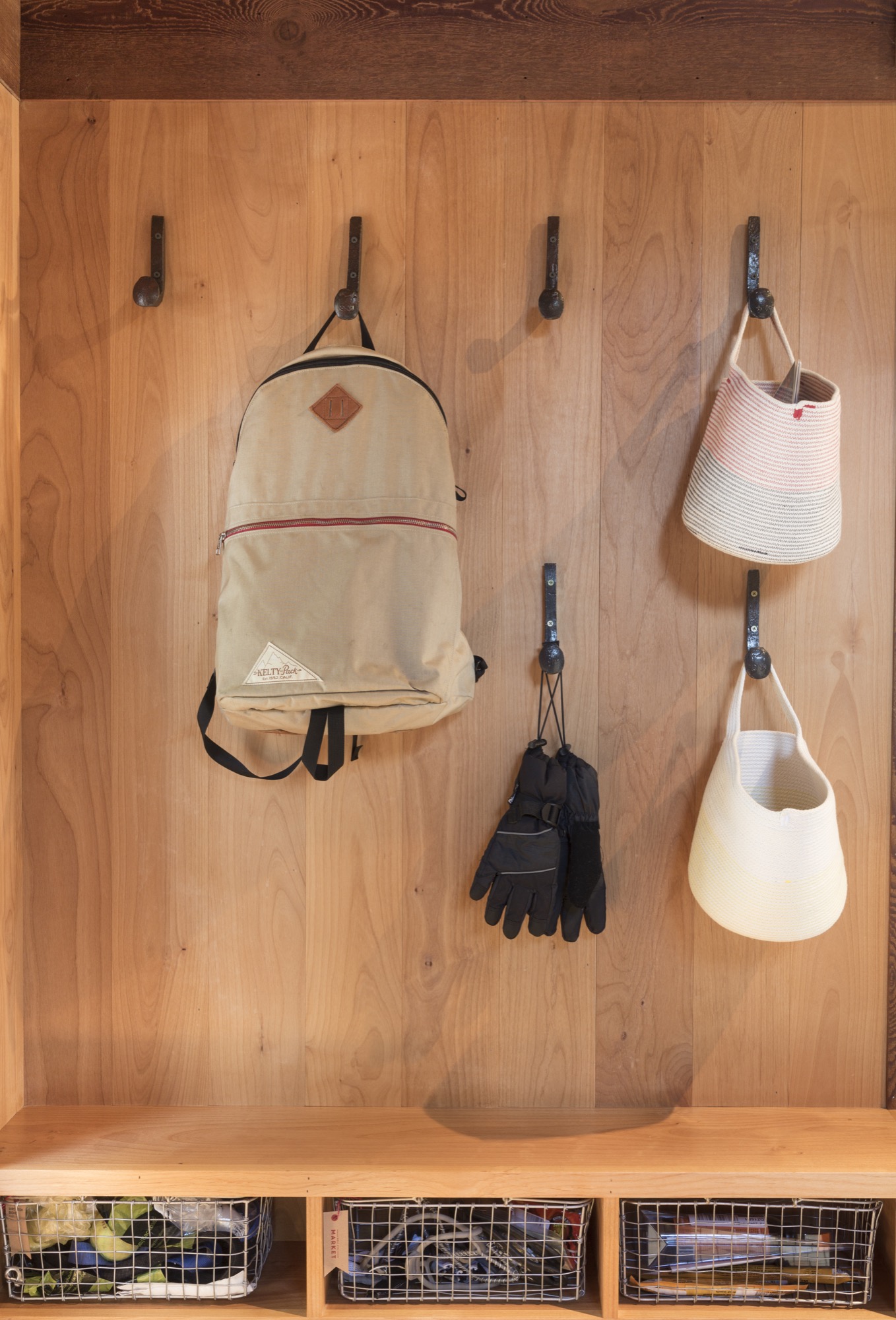
This play between vibrancy and calm, between old and new, between everyday and heirloom, is of particular interest to Bailey. “When I’m thinking of myself as a designer,” she says, “I think it’s important to create balance, and that can apply to everything. You’re trying to create a balance between a lot of different things—to make sure it’s making the right statement, the balance between doing something interesting and standing the test of time. Balancing utility with beauty—all those things you are trying to get right in the middle of, and if you do, then it does stand the test of time and meet its needs.” At the same time, “It is beautiful. To me, good design is taking all those things and striking the right balance.” △
Rugs and Furniture in Felt
A warm and fuzzy curation by Boulder interior designer Jennifer Rhode
Felt has a longer history than people may know. It is considered to be the oldest known woolen textile. The Sumerians have myths about its origins, and several felt shops were discovered in ancient Pompeii. Today, felt is being revived as a construction material for modern furniture and accessories that are inherently warm.
Rugs handmade in Iran
The felt of ancient Pompeii was created by matting and compressing wool fibers, and today’s felted rugs are produced in much the same way. The area rugs of Peace Industry are handmade in a workshop in Iran. The rugs are traditional in their time-honored production process, but the simple, geometric designs are thoroughly modern.
Braid pattern rug
The braided felt rugs of Angelo Rugs’ Highland Collection also celebrate heritage with the classical braid design, but the square, die-cut strand execution is crisp and fresh.
Colorful felt ball rugs
The felt ball rugs of Nepal resemble woolly marbles in a kaleidoscope of colors, stitched together. These whimsical rugs invite you to remove your shoes and engage.
Industrial felt rugs
Jim Zivic puts an industrial twist on both of his felt wool rug collections. For one, he attaches multiple colored felt panels with steel hinges, melding soft and mechanical. Zivic’s newest line features rugs created with felt strips linked together in random color ways, making each leather bound rug unique.
Die-cut bench
Felt is also being used to construct seating. The die-cut felt Joseph bench by Chris Ferebee is elegant in its simplicity, but exudes earnestness and warmth with its stacked, striped, woolen texture.
Felted chairs
The Felt Chairs by Ligne Roset are campy and sweet in their bright bubble gum colors, complemented by the clean, pared lines of the chair frame.
Coiled felt pouf
South African designer Ronel Jordaan’s Ndebele Chair is a circular, flexible seat created by stitching together a long felted wool coil. The serpentine design entices you to relax right into the center.
Felt stones
Stephanie Marin’s Living Stones are an unexpected contrast of soft, appealing textile and shape, depicting a natural element that is typically cold and hard. The stones beckon you to cuddle up and participate.
Felt Wall Art
The anodized, acoustic felt wall sculptures of Submaterial are creative collections of felt pieces arranged in colorful striped or geometric compositions—warm and modern.
Felted lamp shades
Outofstock’s pendant Stamp lamp and Tom Dixon’s Felt Floor Lamp surprise by using a thin layer of felt on their shades, providing both light and cozy comfort. Surely, the Sumerians would have appreciated such illumination when stamping out cuneiform on their clay tablets in the evening. △
Mountain Minimalism—The Next Level
Emerging Boulder artist and graphic designer Adam Sinda contemplates what’s next in Colorado’s art and design scene
Emerging Boulder artist and graphic designer Adam Sinda spends his days working at Made Movement, an ad agency in town. But the Colorado native also loves to paint in his free time and has created original art for two Alpine Modern t-shirts—which he personally modeled for us during a photoshoot set in our own alpine backyard. When he’s not designing or painting, the twenty-four year old loves to get out on the trails and run, alone.

We caught up with Sinda at the Alpine Modern Café to talk about Denver and Boulder’s art and design scene and how Alpine Modern is pushing the envelope on what defines Colorado.
A conversation with trail-running designer Adam Sinda
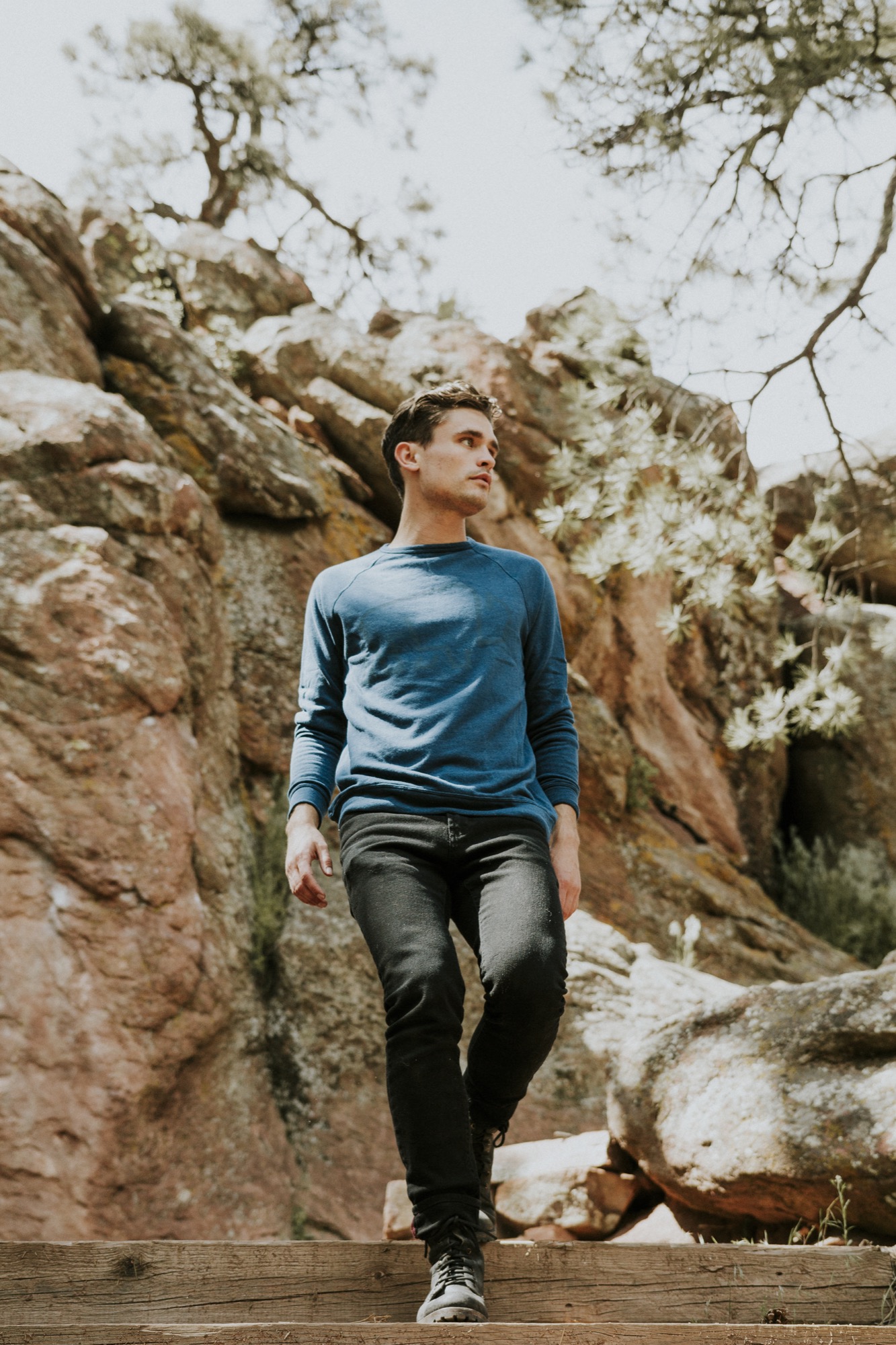
AM What’s your creative process?
AS Typically, I photograph outdoors; landscapes or anything I am inspired by. Then I bring it back to my room and try to simplify the form as much as possible—and add color. I’ve been working with color, lately.
AM What was your path to becoming a graphic designer?
AS I got a graphic design degree from Western State Colorado University in Gunnison, but I loved to take oil painting classes. That was probably my favorite art class. Design to me is so restricting, sometimes. And walking into an oil painting studio, you can just be yourself and experiment and play and get dirty. Most of my world is making stuff that’s going to be sold, and when I am painting, it’s for me.
AM Meanwhile, you are a graphic designer at Made Movement...
AS Yes, it’s an agency, and we work with brands like Lyft. Typically, we do everything from apps to web banners to illustration.
AM But you also do your own designs, and you have created art for Alpine Modern...
AS When I find a brand I can relate to and I want to be a part of, I jump in, anytime. I really feel Alpine Modern meets my ethics and aesthetics. I was working with photographer Garrett King, and we were just getting out there and going for hikes, just living in the moment.
AM You have designed two t-shirts for Alpine Modern. What makes that medium interesting to you?
AS The fact that other people are going to be wearing it and expressing themselves with it. Though they may never know who made that t-shirt.
AM What inspired those two particular designs?
AS For the Circular tee, what was inspiring me at the time was Alpine Modern’s Instagram. The motif is an abstract pulled from a photograph, and I started sketching and minimizing what I saw, just keeping it clean, simple, modern.
The second tee was the Typography t-shirt. It’s always fun to organize type in a particular way. I traded a mood board with the Alpine Modern team, and that shirt evolved from there.
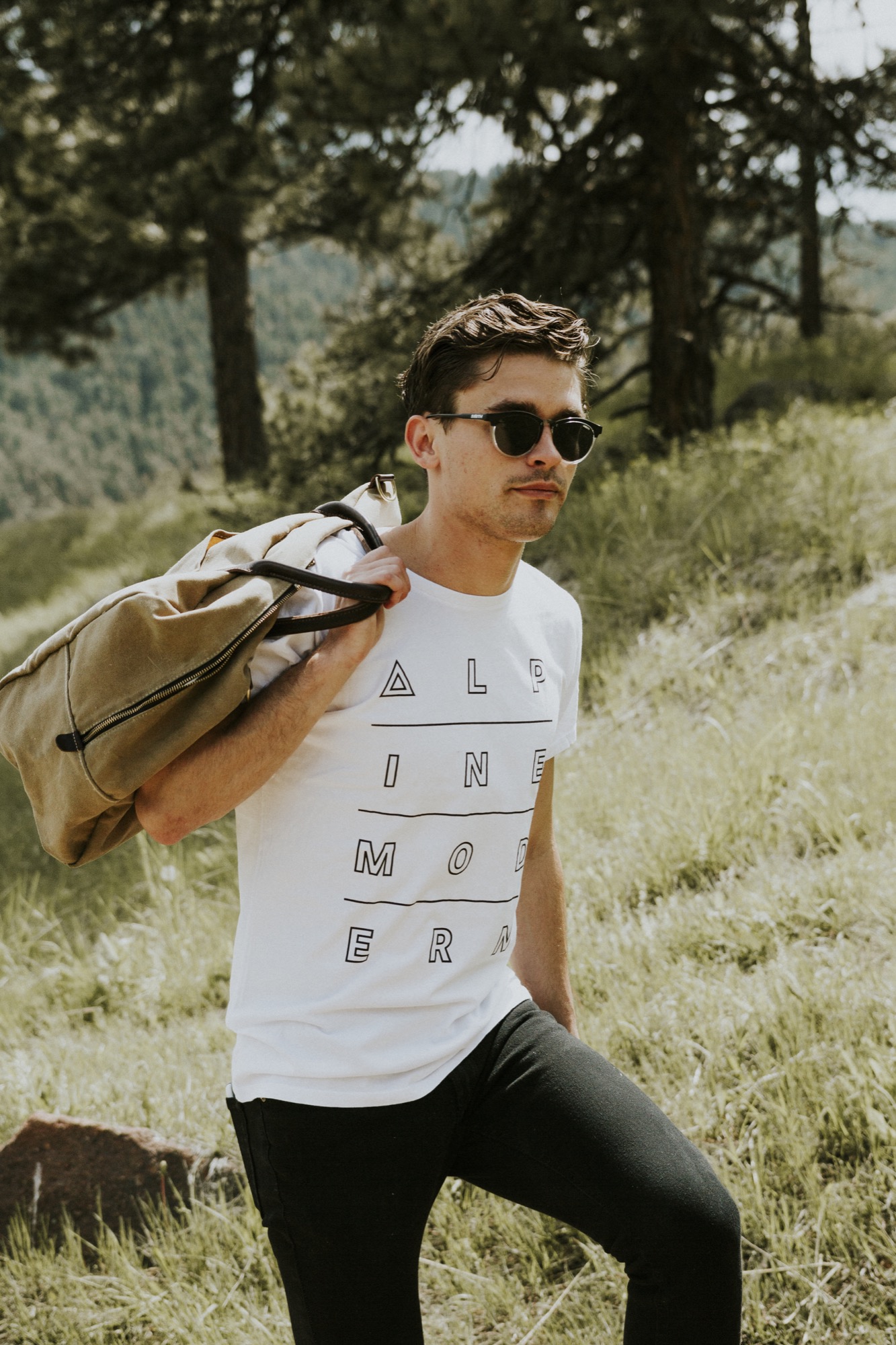
AM What does it feel like to now see your shirts at the Alpine Modern Shop on Pearl Street?
AS It makes me feel good, happy. Mainly, it makes me feel like I am part of a culture that’s growing right now. A shirt is a simple thing. People build buildings, and people build houses. But sometimes it takes t-shirts and art to make you feel part of a culture. When you’re a developing artist, what you strive for every day is just to be heard, whatever medium it is.
“A shirt is a simple thing. People build buildings, and people build houses. But sometimes it takes t-shirts and art to make you feel part of a culture.”
AM What’s your message you want to be heard?
AS Wherever you are, when you are in a very attractive scenery in the mountains or in a landscape, you’re backpacking somewhere in the woods, take advantage of that moment and remember it because when times get rough, it is nice to pull from those images, and that’s what I would like to say, live in the moment when you feel it’s right. Take a mental photograph.
AM You say your Alpine Modern t-shirts makes you feel you are part of an emerging culture...
AS Right now you can see Denver developing this art culture. But to be honest, I think it is still refining what it wants to be. And Boulder has a huge opportunity to be a part of what downtown Denver is doing right now. And I think Alpine Modern can play into that world and really push the envelope on what Colorado is seen as. It’s cool to see Alpine Modern developing that image right now and really altering what artists are doing today.
AM Describe the Colorado art and design scene for someone from perhaps Berlin or Japan, who has never been here.
AS Art and design here is currently very minimal, very clean, but there are sparks of an identity evolving, and I think we are going to see a shift here. Clean and simple is fun, but what is the next level? What’s after that? Do we start developing some play with color or abstract forms? What’s that next shift? Because if everyone starts doing minimalism in Colorado, you will start seeing it get stale. I think in Colorado in general, we want to create a better culture, we need to spark something a little bit stronger, but I think we are still figuring out what that is.
AM Where will your next spark come from, building on that clean mountain minimalism?
AS Im really inspired by the 3D world right now. It’s fun to take these minimal objects and shapes and use 3D software programs to see behind them and see around them. A lot of designers these days just use Illustrator and very flat design. If you can design and know what’s behind objects, you start to see different light and that’s really interesting to me right now, so I’ve been experimenting with those programs.
AM What is the connection here to being in real landscapes and real nature? Hiking in the mountains is this quintessential three-dimensional experience because you do go behind the trees and behind the mountains and behind the next bend...
AS You’re spot on. When you’re out there with your friends, you’re moving towards an object and you’re reaching a goal. You are achieving something while you are hiking, going from A to B. And it’s fun to see how our designs are going to change with time. We have these VR headsets come out, and it’s gonna be fun to see how 3D plays into Colorado’s art culture. Colorado is such a good place to be right now as a graphic designer and an artist in general, and it’s just going to be even better.
AM What do you do when you are in the mountains?
AS I’m a huge runner. I used to compete in college, in the steeplechase. It has always been my escape. You just put on your running shoes and short shorts and get out the door and run. I love hiking, don’t get me wrong, but there is something cool about just going out and going for a jog by yourself for an hour and then come back and feel refreshed and ready to go. The cool thing about Boulder is you are really never that far away from a really sweet trail.
AM How has your love for the mountains influenced your design work?
AS Greatly. Growing up here and having lived here my whole life, seeing the mountains is comforting. And I think the they say a lot. △

Sense of Place: Clean as in Whistler
Chad Falkenberg of Vancouver-based Falken Reynolds talks about modern interiors in Whistler's mountain homes and cabins
In the fourth and last installment of our "Sense of Place" series, we are talking with interior designer Chad Falkenberg of the Vancouver-based interior design studio Falken Reynolds about brining Whistler style home, no matter where you live. Whistler is rich in cedar and granite. So its natural that traditional mountain homes use a lot of both. While the wood in older homes may have a raw finish, you won’t see many log cabins in the mountains of British Columbia. The trees here are simply too massive. The granite boulders are enormous, too. People incorporate them into the structure of the house. Natural stones, in fact, are a classic element of both traditional and modern homes in the Canadian resort town.
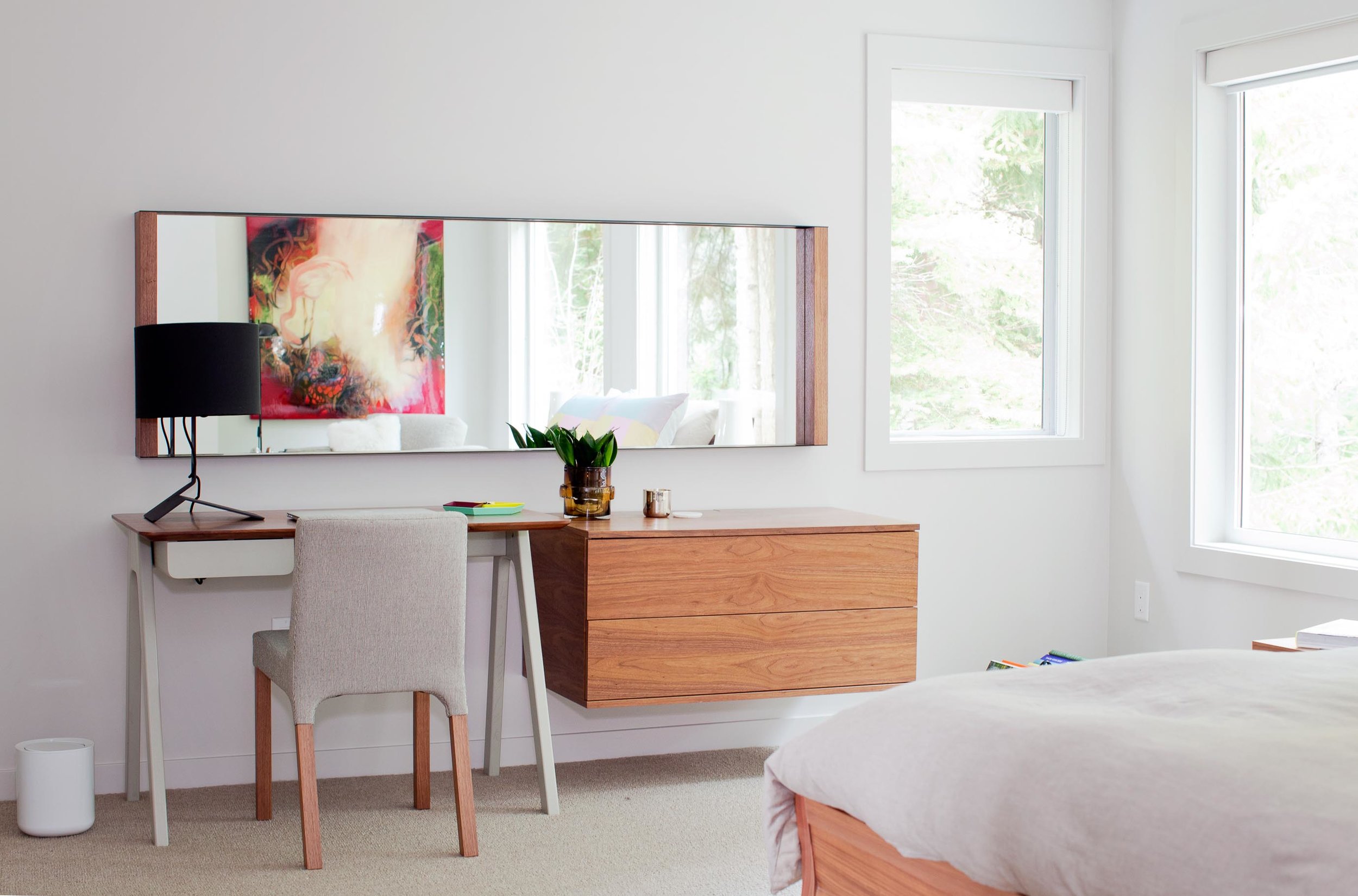
“We try to use a lot of natural materials when we are working in Whistler,” says Chad Falkenberg, one half of Falken Reynolds, a Vancouver-based interior design studio. “It feels more authentic, closer to the earth and to the outside, which is why people go up there, to get away from the city.”
Some of his projects involve sand-blasted Douglas fir to achieve very clean lines but give the wood extra texture. “The idea with all of this is that it patinas well,” says Falkenberg. “If the wood gets hit by a tree or by skis, it’s OK.”
The studio’s work in Whistler is particularly minimalistic and sophisticated yet still achieves the cozy feel of a mountain retreat. Hard textures are mixed with softer, textile surfaces. “In the bedroom of the Aspen Drive house, we used wood furniture, but we also used wool carpet, so the whole floor feels like a sweater,” Falkenberg tells about a recent project. “When you get out of bed, you shouldn’t have to put socks on.”
The designer, who draws inspiration from years of working and traveling in Scandinavia and Southern Europe, often relies on the visual warmth of the materials. “One of the easiest tricks is to mix grays and warm colors,” to achieve the clean-lined yet warm look and feel of some of the Whistler homes he has designed. Combine a warm natural wood with a gray countertop or fabric, for example. “The two things are almost juxtaposing each other,” Falkenberg says. “It’s almost like a wood next to the cool gray looks even warmer.”
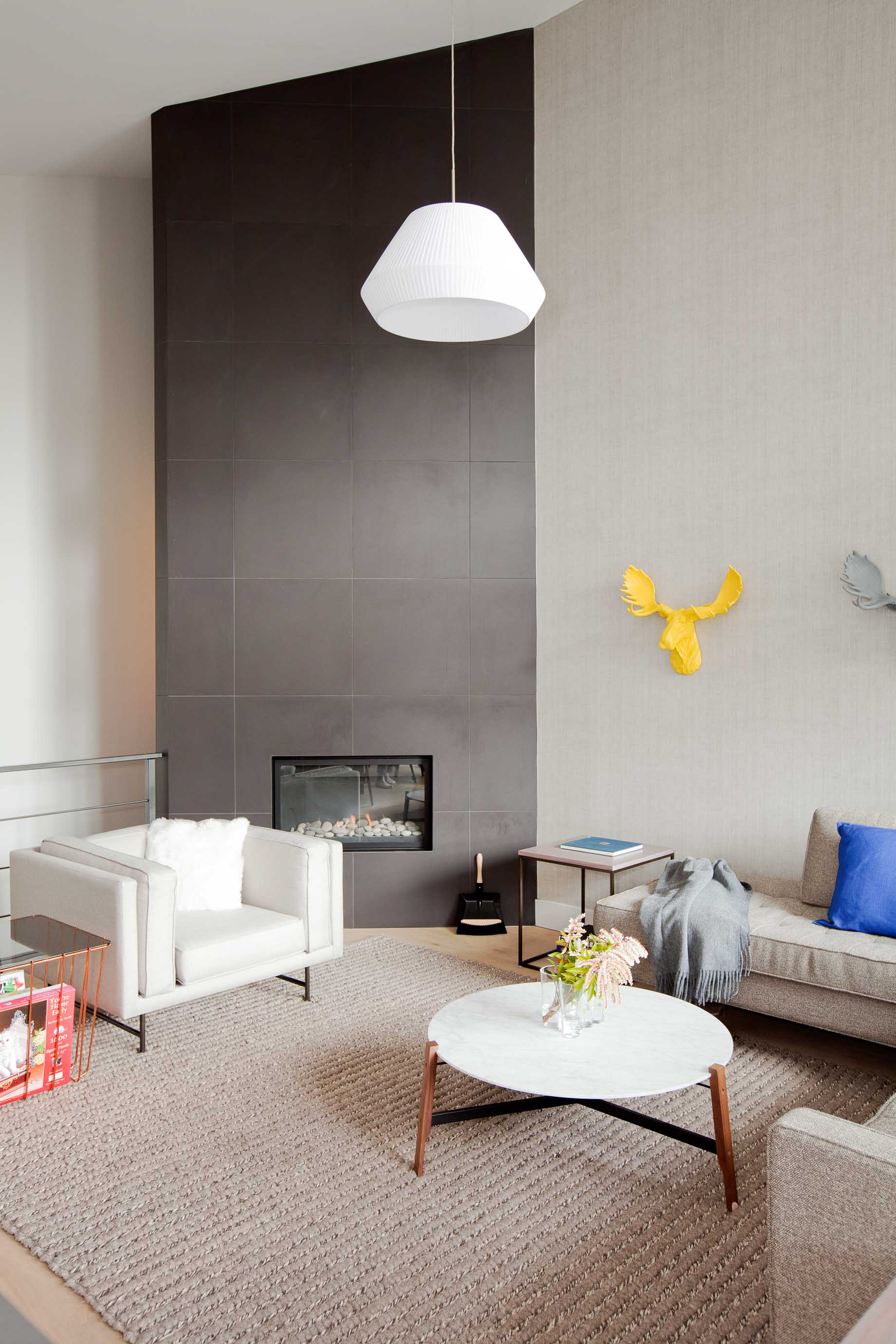
To accessorize your Whistler-inspired winter interior, go for copper and terra-cotta pots. The designer’s favorite textures are anything that feels like a sweater—the loop of a rug, wool blankets, pillows covered in chunky knits. A rougher texture, even on a hard surface like a co ee cup, also feels warmer. Leather is another great material that feels warm to the touch. It has a history to it. “Anything that evokes the natural world,” says Falkenberg.
He likes to keep things casual in a mountain retreat, as he expresses by using a wire taxidermy sculpture or resin moose heads on the wall. “I love anything that reminds me, OK I’m in a cabin, and I’m not supposed to take everything so serious.” △
The Weavers of Lapua
More than a hundred years ago, the great-grandfather of Jaana Hjelt’s husband, Esko, opened a wool and felt boot factory in Lankilankoski, Finland, where the Ostrobothnian winters are freezing cold.
More than a hundred years ago, the great-grandfather of Jaana Hjelt’s husband, Esko, opened a wool and felt boot factory in Lankilankoski, Finland, where the Ostrobothnian winters are freezing cold.
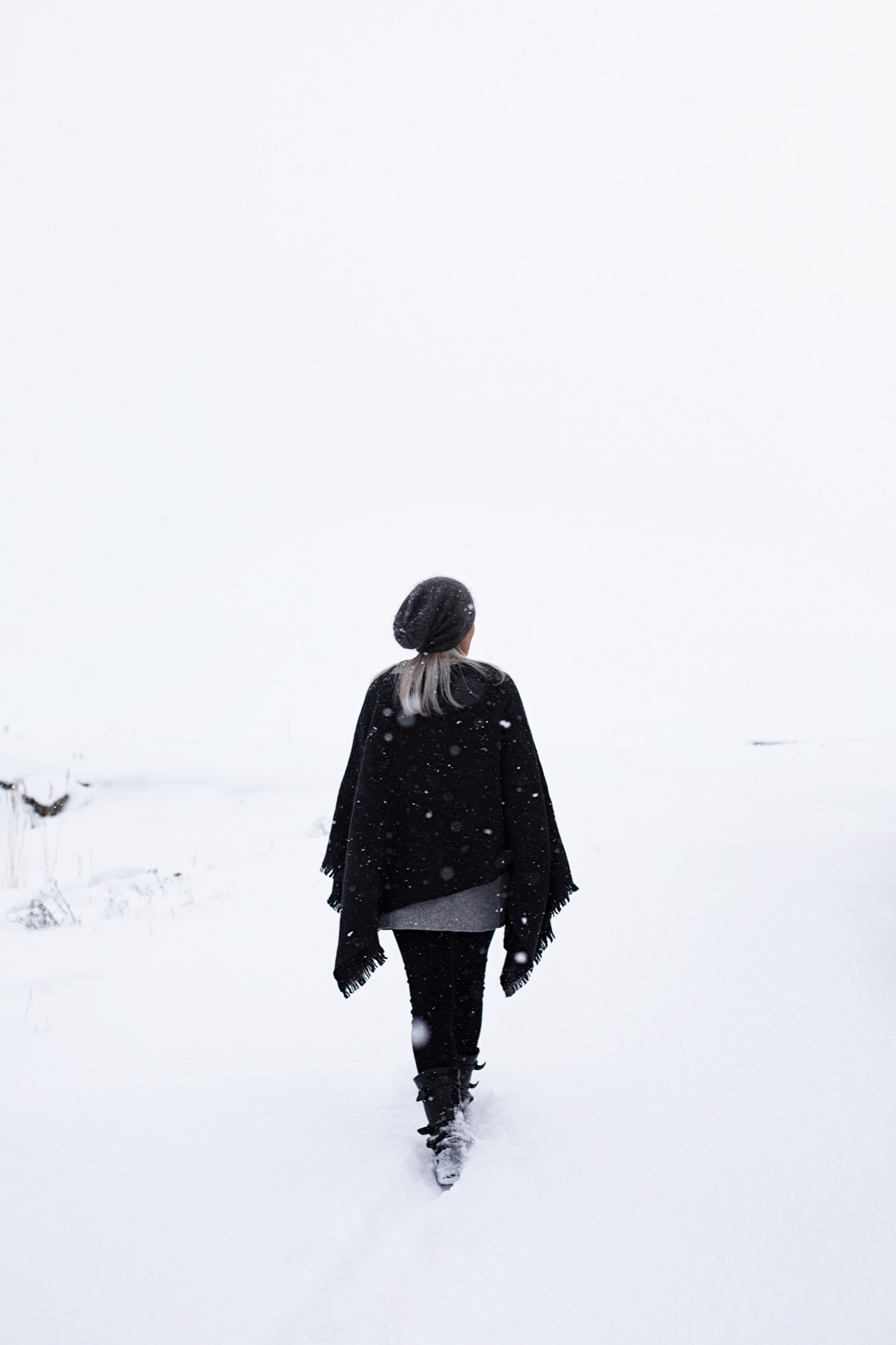
Still in family hands, Lapuan Kankurit today values responsible and environment-friendly processes and pure natural materials. Multifunctionality of their products is important to owners and forth-generation weavers Jaana and Esko Hjelt. In their book, blankets can also be tablecloths or space dividers. Their high-quality textiles are made to bring beauty and happiness into a family's everyday life for generations.

Lapuan Kankurit's fine wool products weave together the story of Finnish handicraft traditions, innovative techniques, and the artwork of top Scandinavian designers. And so the legend continues.
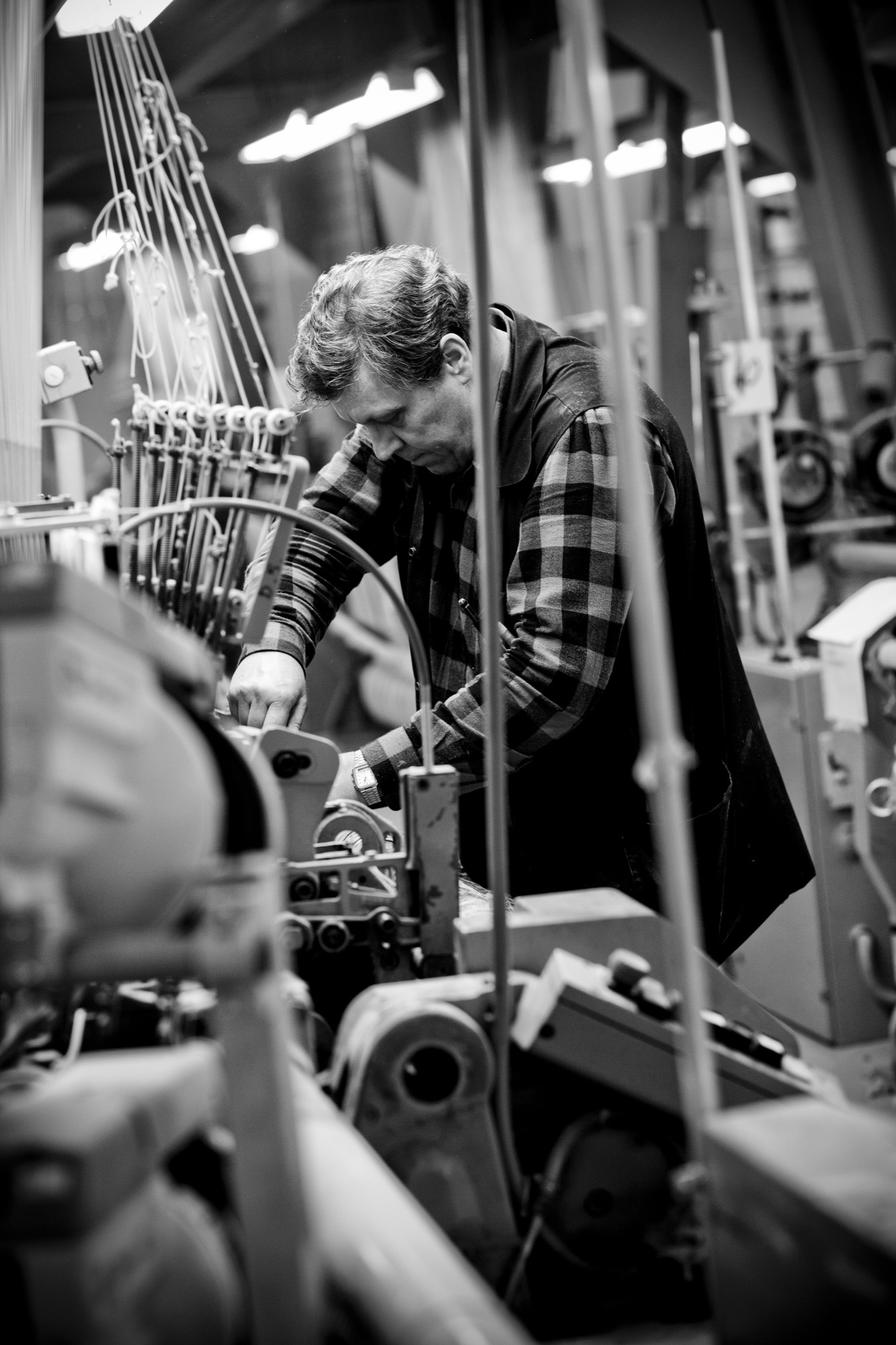
A Conversation with Jaana Hjelt
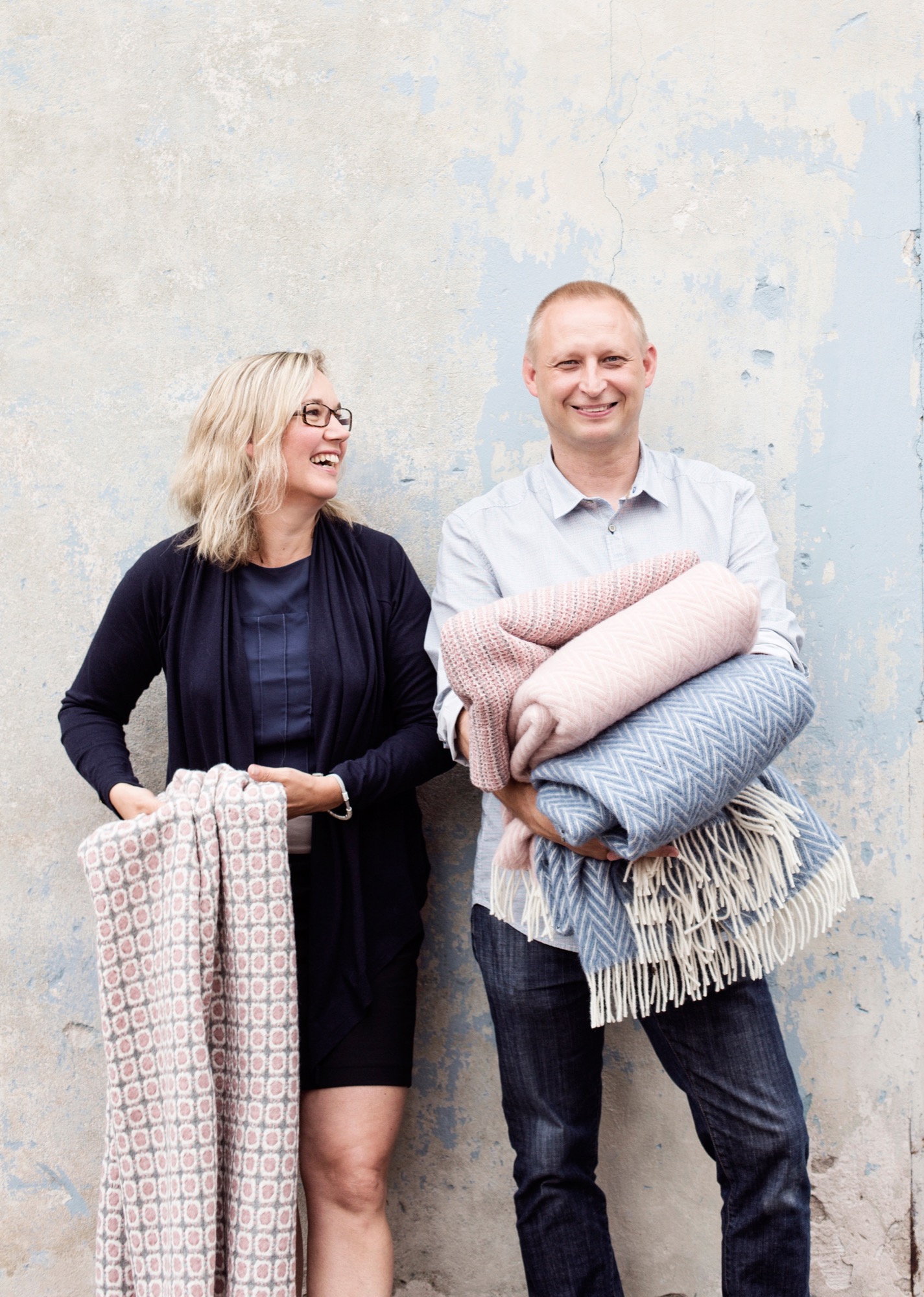
Born: 1968 in Lapua, Finland.
Lives: After studying and working in other cities for ten years, I came back to Lapua.
Work: I do what I love. I run a weaving mill—Lapuan Kankurit (“Weavers of Lapua”)—with my husband, Esko.
Fun: I love to just stay at home with the children, to spend time without any timetables. But we all also love to travel and meet new people. That’s what I do for fun and for work!
Working on right now: Now it’s the “exhibition season,” which means traveling around Europe and attending fairs. It’s great to show our latest collection and hear the feedback.
Favorite place in the world: Home. This may sound boring, but because of my busy life as an entrepreneur, weekends at home are the best. Saturday evenings at home with family: good food, sauna, sitting, and talking with the kids about all the joys and sorrows of the past week.
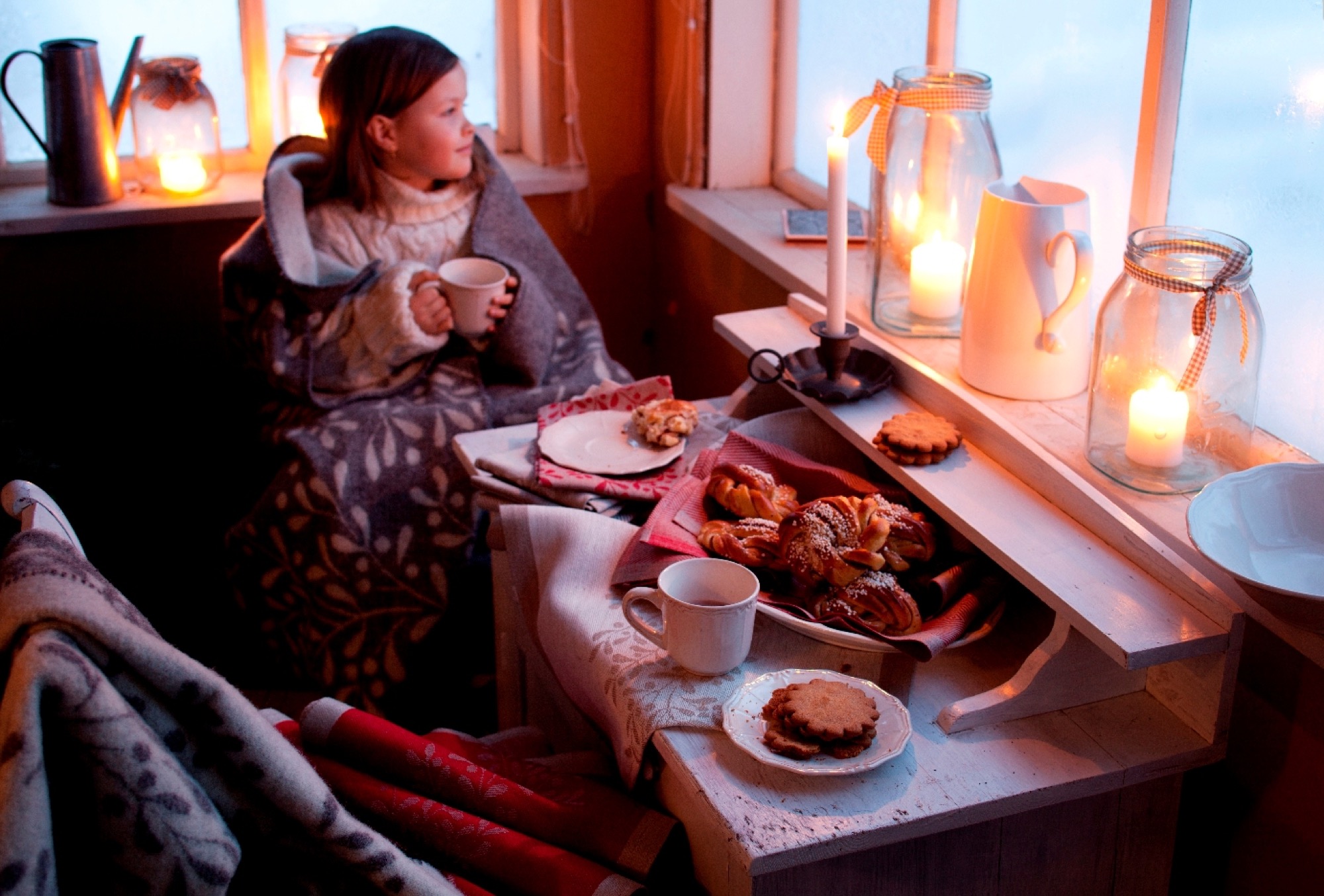

Motto: Now it’s a perfect moment.
Inspiration: My husband, Esko. It’s great to have someone next to you who is seeking innovations. He always gets ideas for textiles, and we share the same passion to create something new and beautiful for homes. Together with our designers, we make a great team.
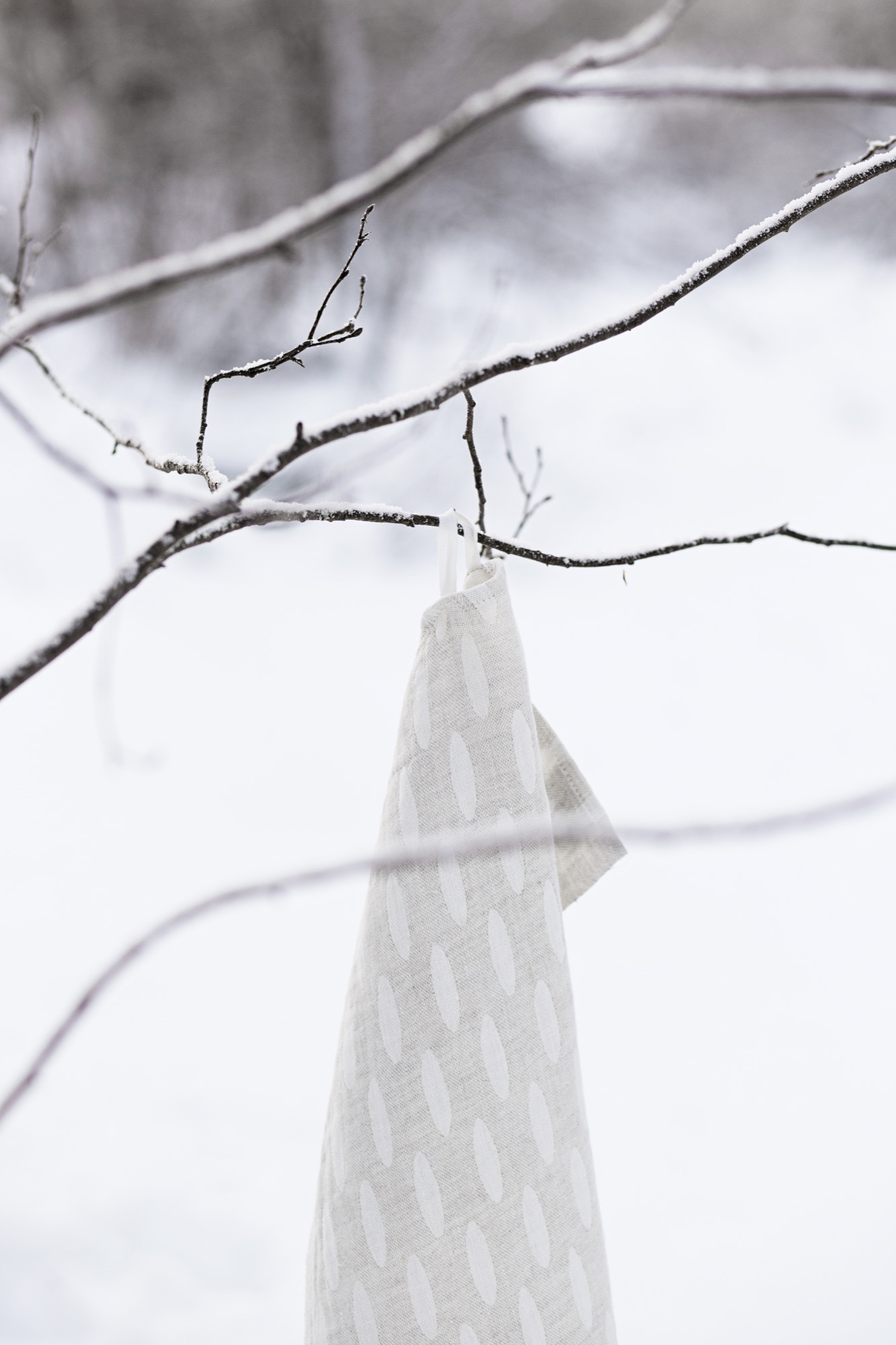
Treasured possession: My grandmother’s handcrafted textiles.
Never leaves the house without: A smile. What else do you need?
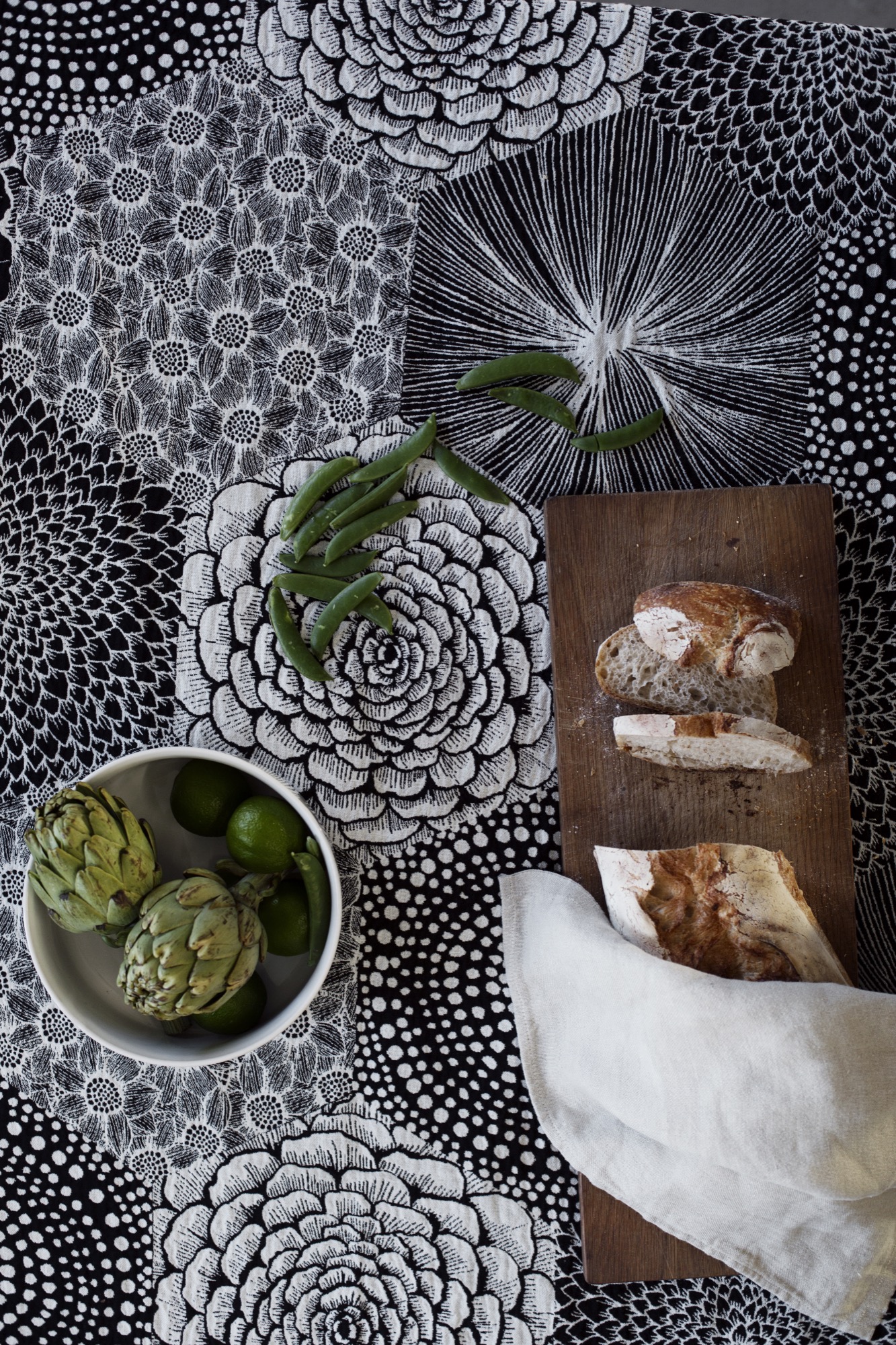
What’s next for Lapuan Kankurit: We also would like to expand a bit more from home textiles towards apparel . . . Our designers have already made some great bags. I just love them and can’t wait for production to start.
See the beautiful products Jaana and Esko Hjelt are weaving at lapuankankurit.fi. We also sell select Lapuan Kankurit products online and at the Alpine Modern Shop on Pearl Street in Boulder. △
Cozy and Knit
Winter interiors: Bring warmth into your home with tufted or knit accessories and furniture
Coziness and chunky textures are not just for your grandma’s homemade afghans anymore. These tufted or knit accessories and furniture options have all the warmth of a storybook cottage, but they couldn’t be more modern.
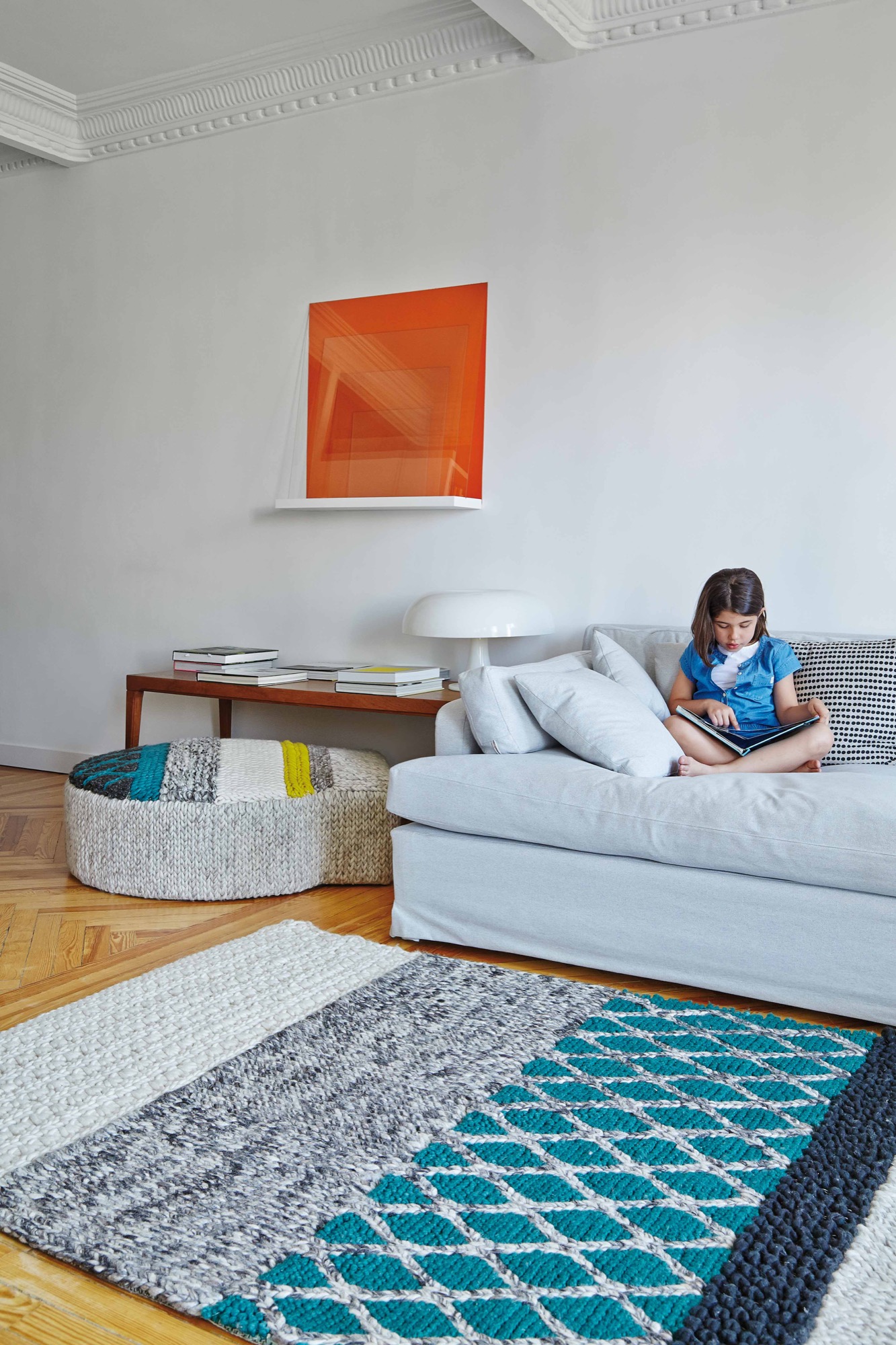
Sculptural skein seats
Claire Anne O’Brien’s stools, poufs and chairs are knit into giant skeins and then woven into a variety of loops, donut shapes and traditional patterns. The resulting seats are both whimsical and chic, surprising in their reinvented use of knitting.
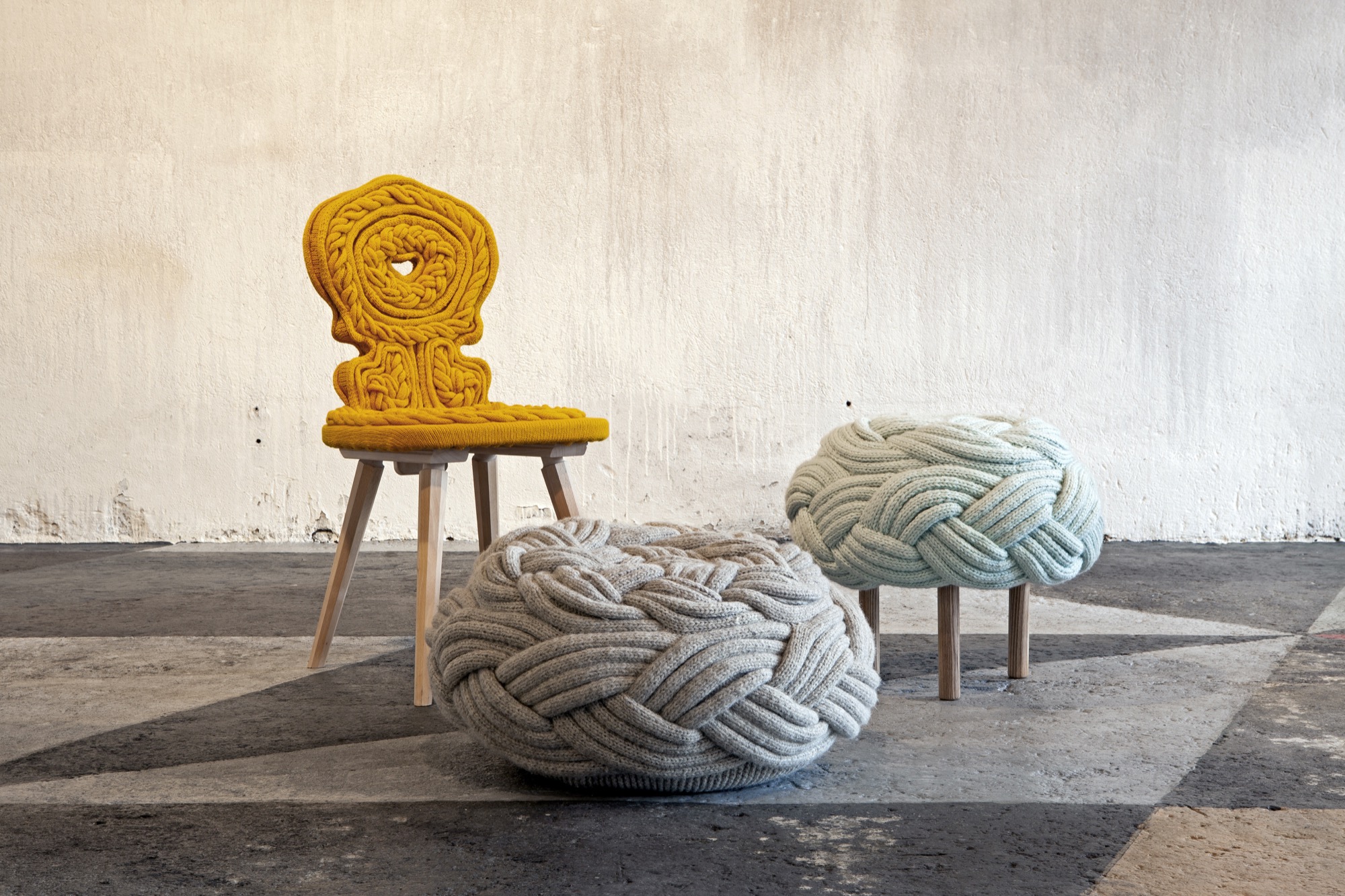
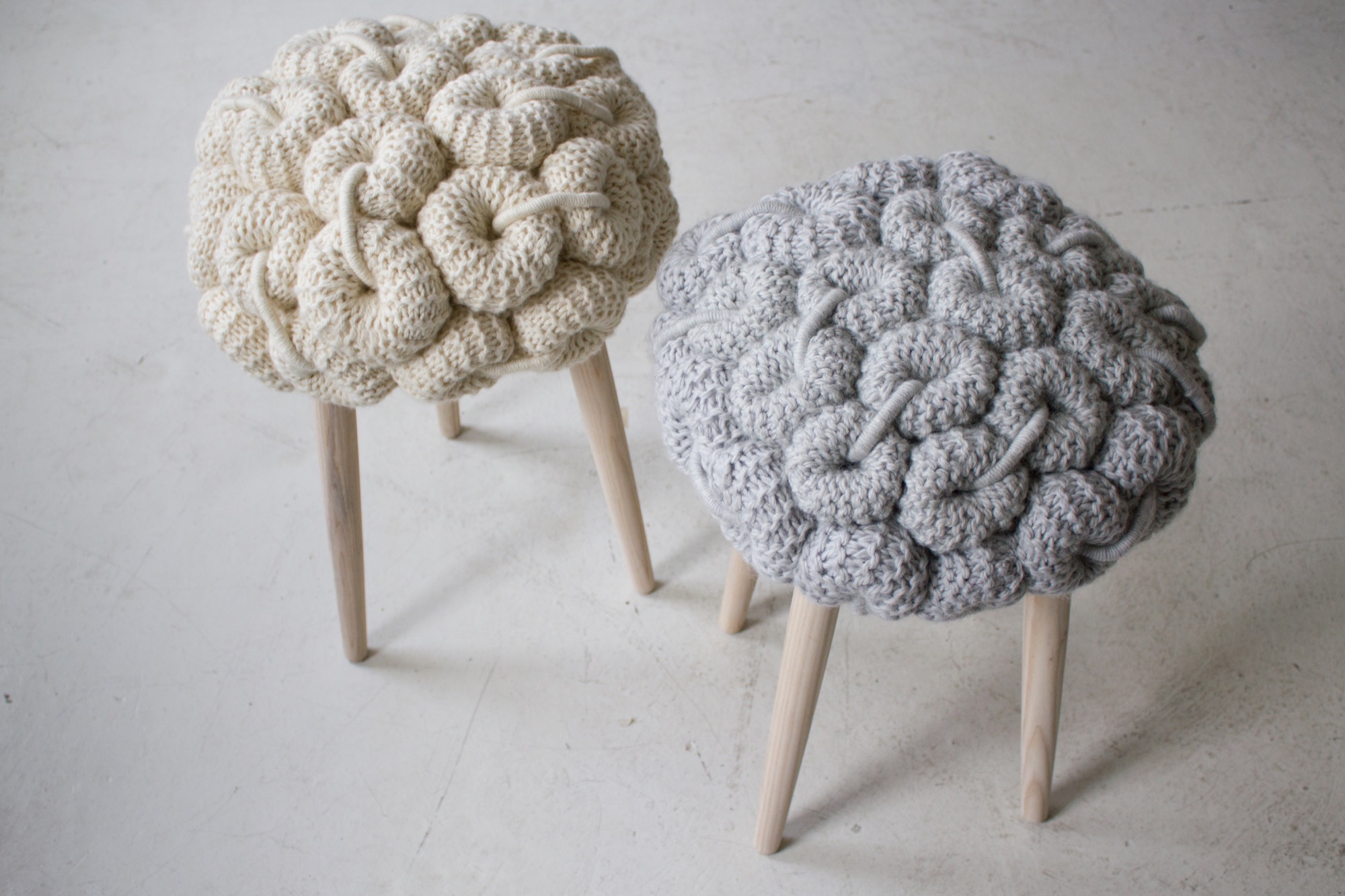
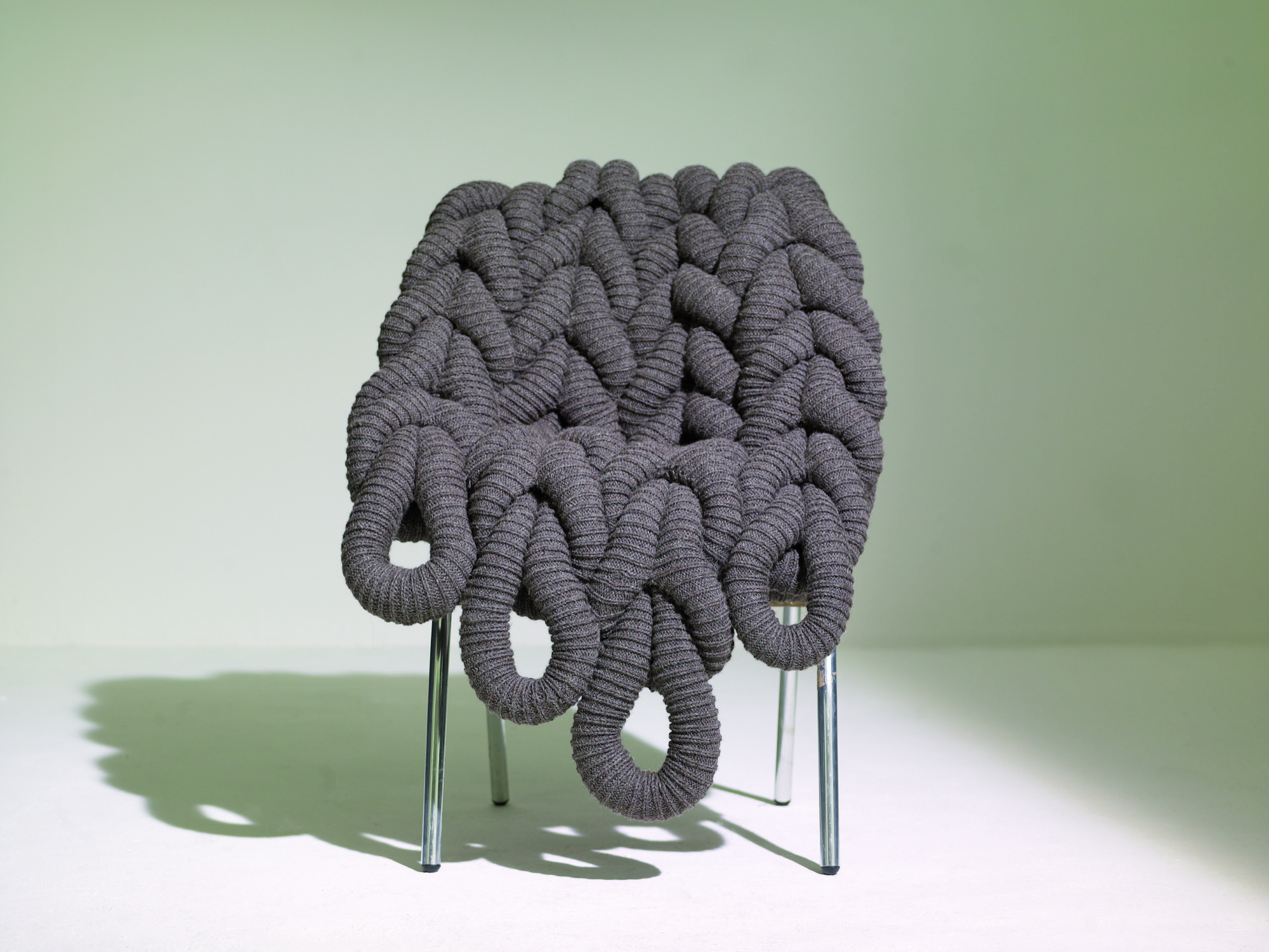
Ruched beds and seating
Ligne Roset’s Ruché Collection features beds and seating covered in an even, square, ruched design, with spare wooden frames. The soft, quilted fabric complements the simple legs, melding a traditional sewing pattern with modern structure.
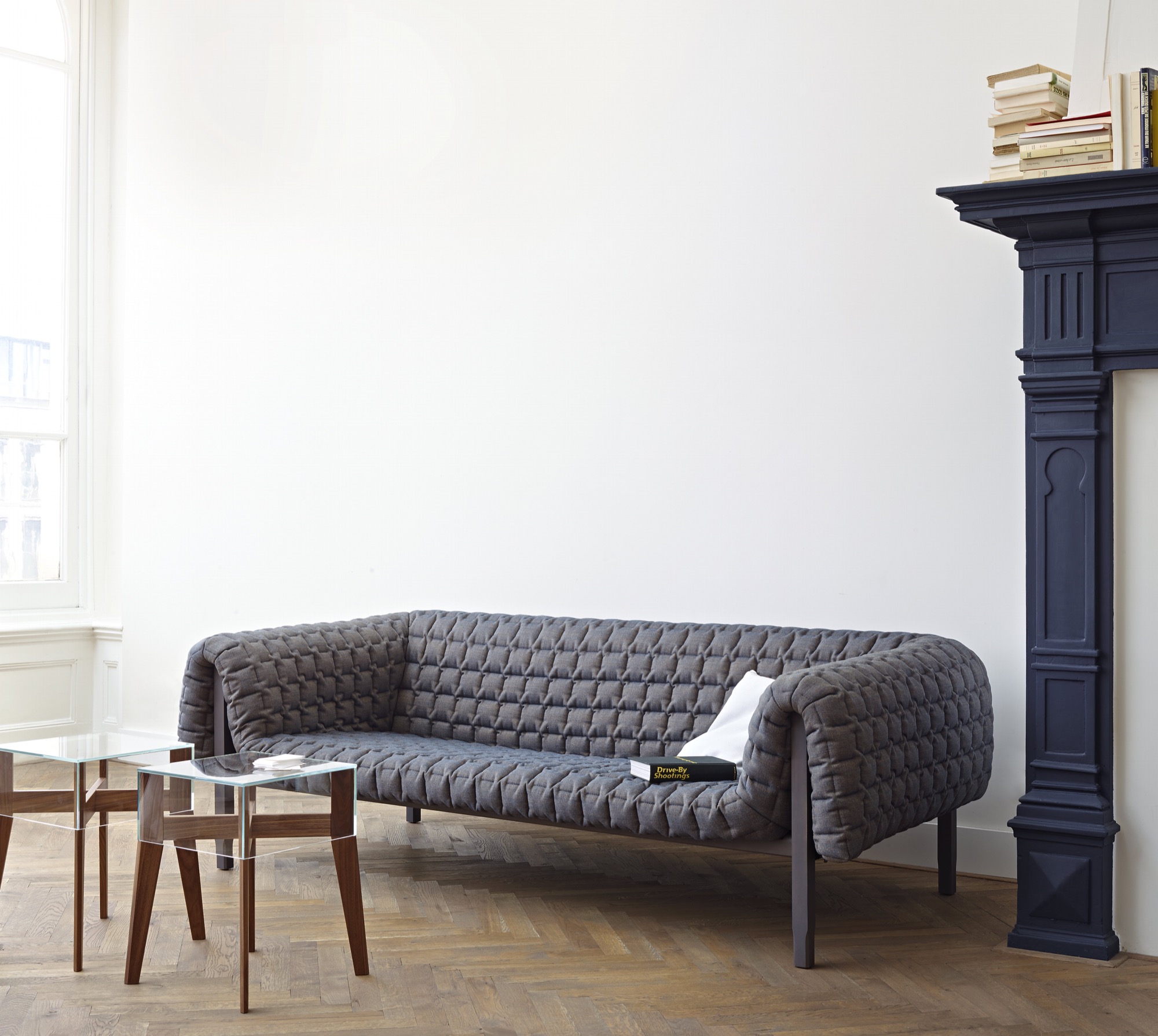
Giant hot-water-bottle shapes
Playing with size and intention in the following rugs and poufs add both warmth and whimsy to modern spaces. The unexpected hot-water-bottle shapes of the Mangas Collection from GAN brings together heritage and modernity.
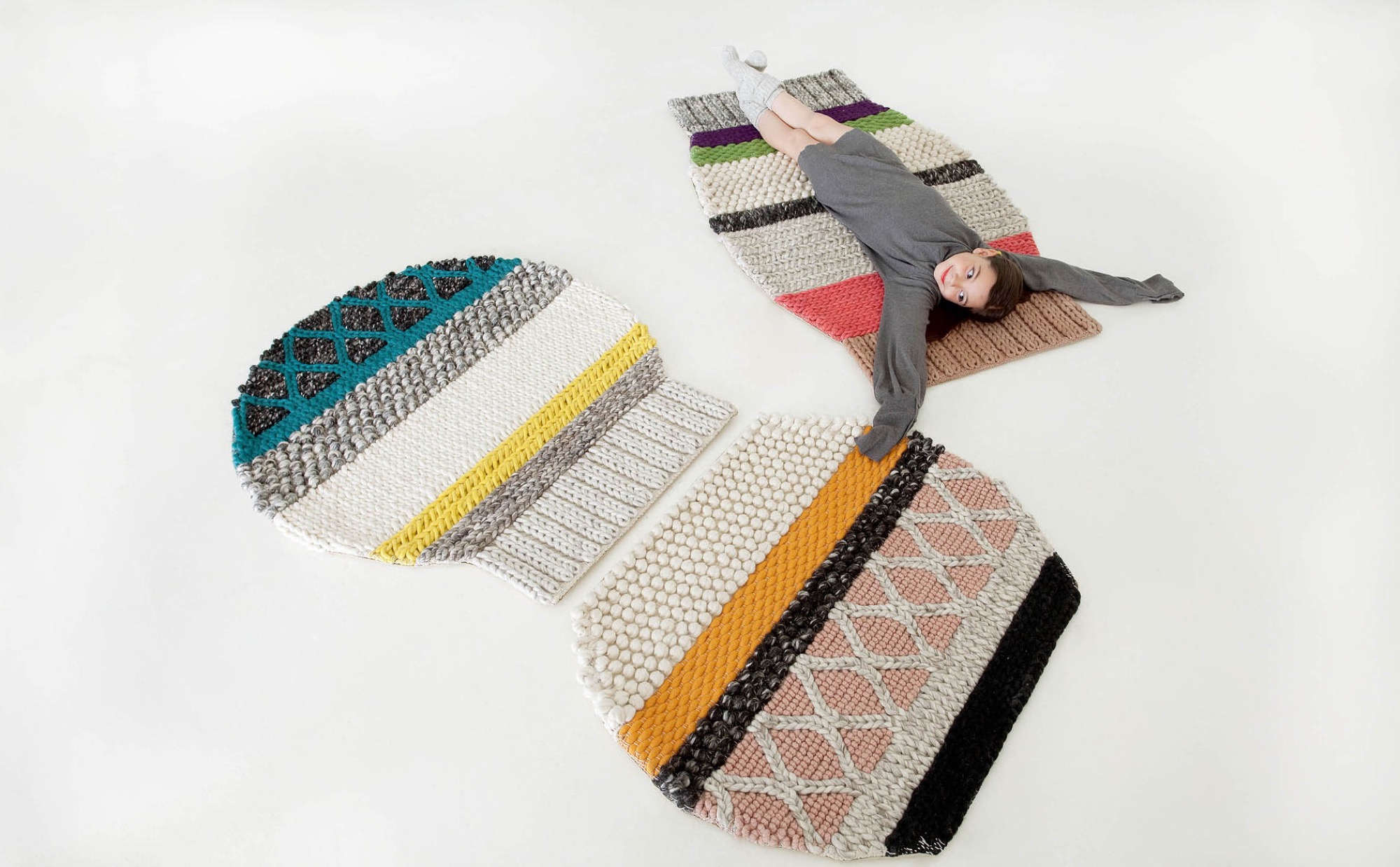
Knit bean bags
Zilalila’s Nest knitted bean bags are just that… a cozy nest to cuddle into. The knitted construction evokes another era, but the shape and feeling are wholly new and sophisticated—enriching the modern living room.
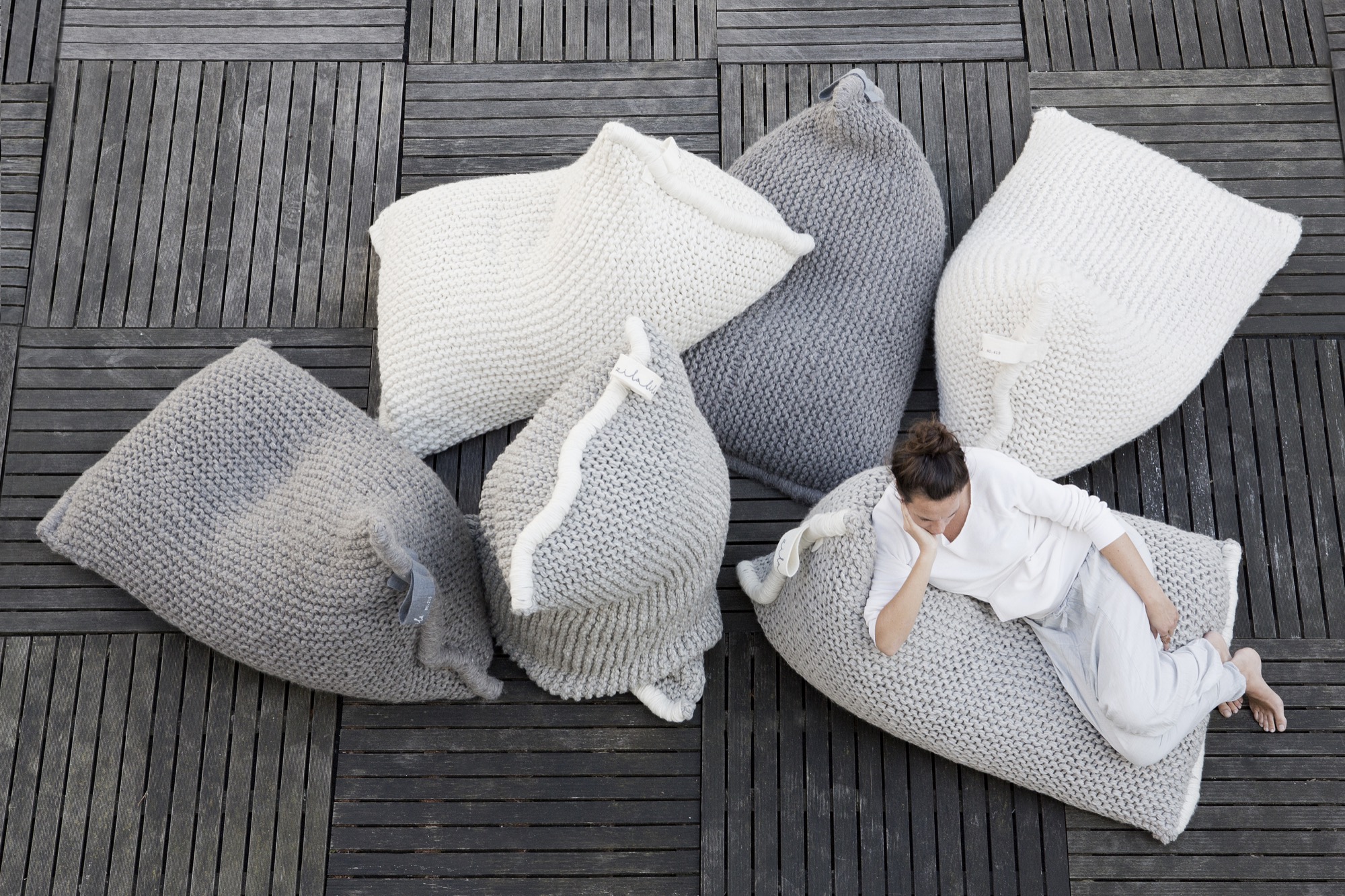
Doily rugs
Hooked Design’s doily rugs surprise by transforming something typically seen on an armrest and enlarging it for the floor.
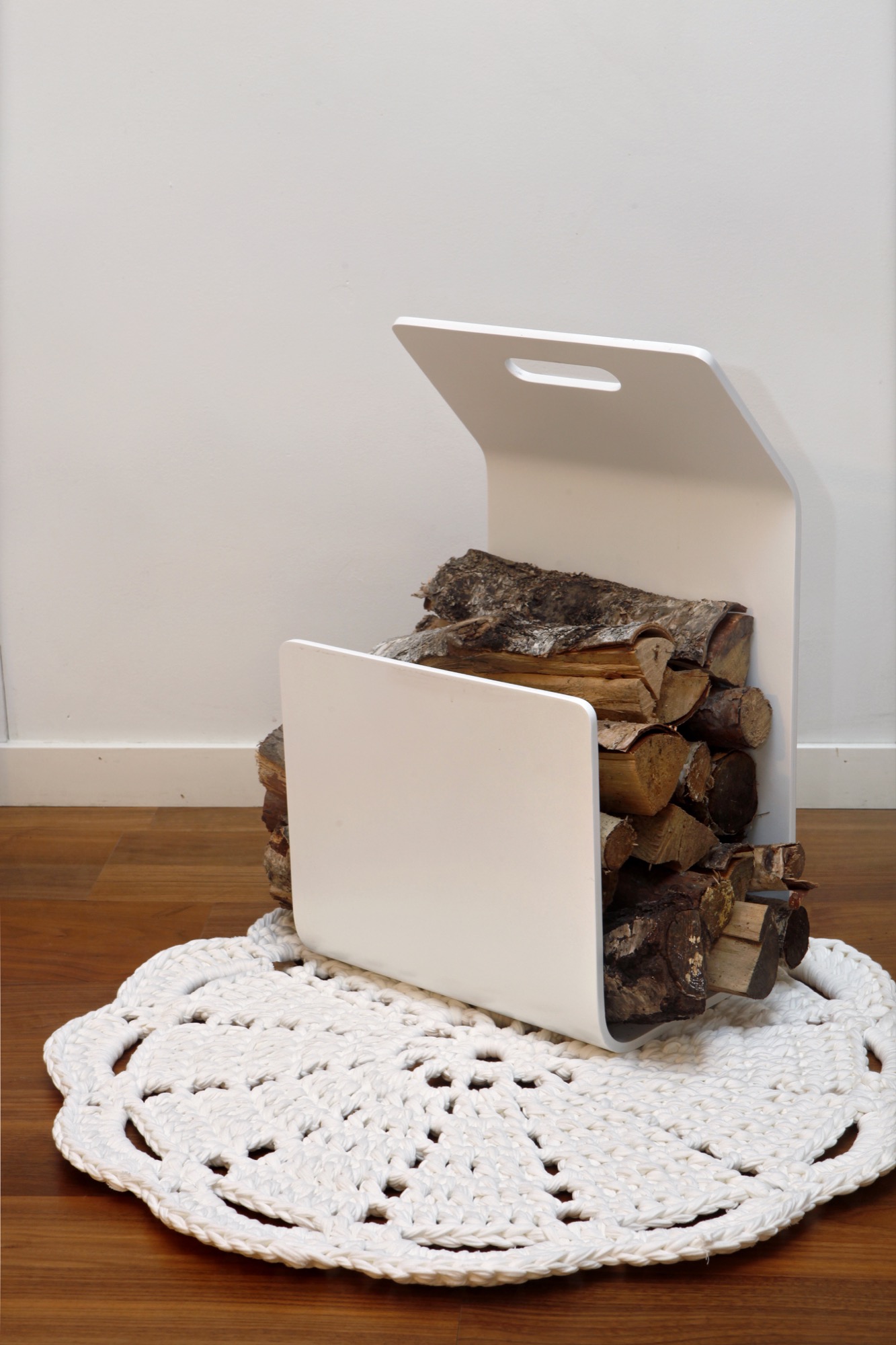
Sweater-sleeve rugs
Christien Meindertsma’s Aran rug is like an oversized sleeve of your favorite fisherman sweater, inviting you to relax right into the cables.
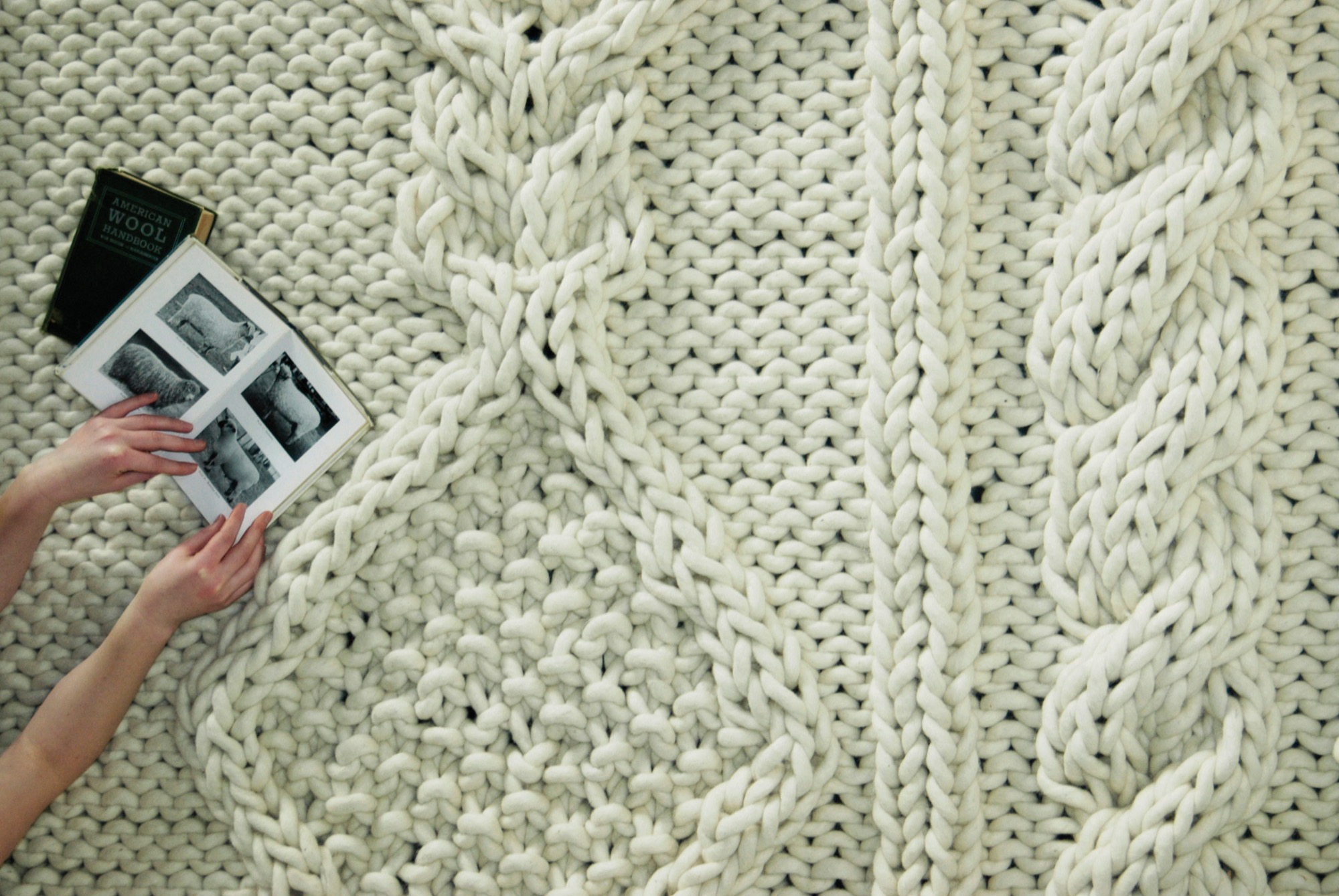
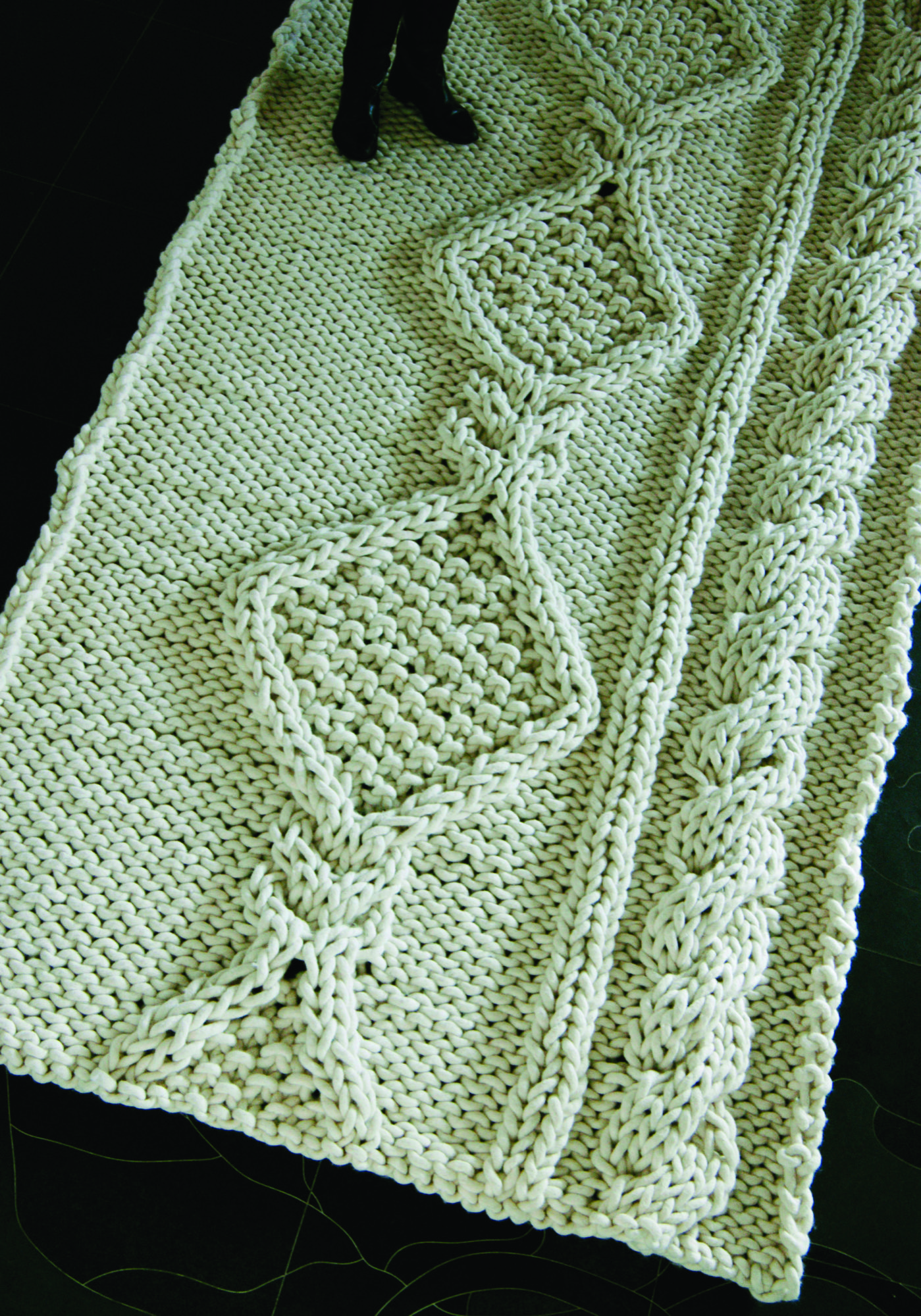
Stories with Granny under the throw
Finally, the knitted Granny Pendant of Casamania… the ideal light to sit under, while reading your favorite book, cuddled up under Serena and Lily’s Henley Wool Throw, the modern version of your grandma’s afghan. △
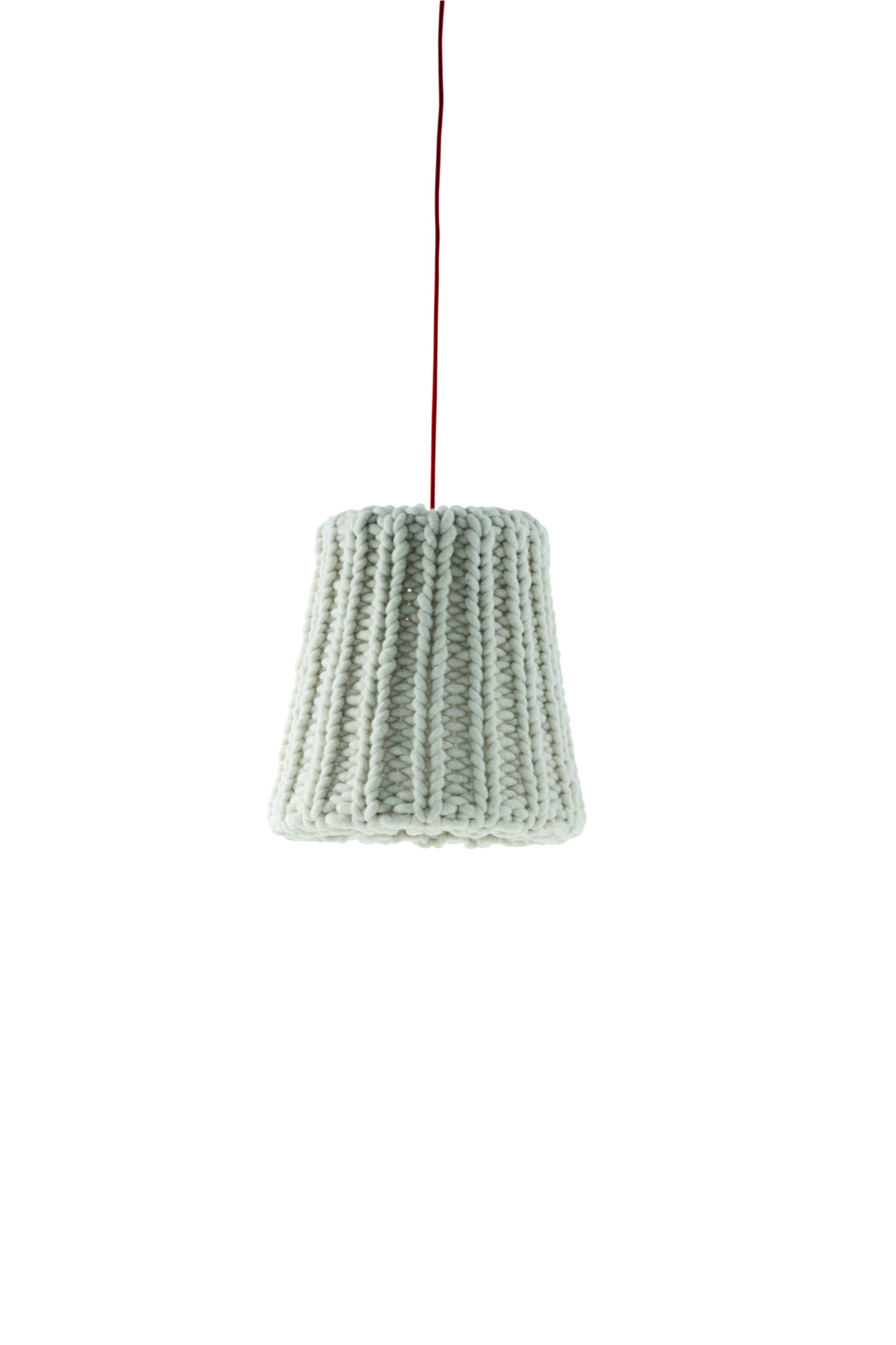
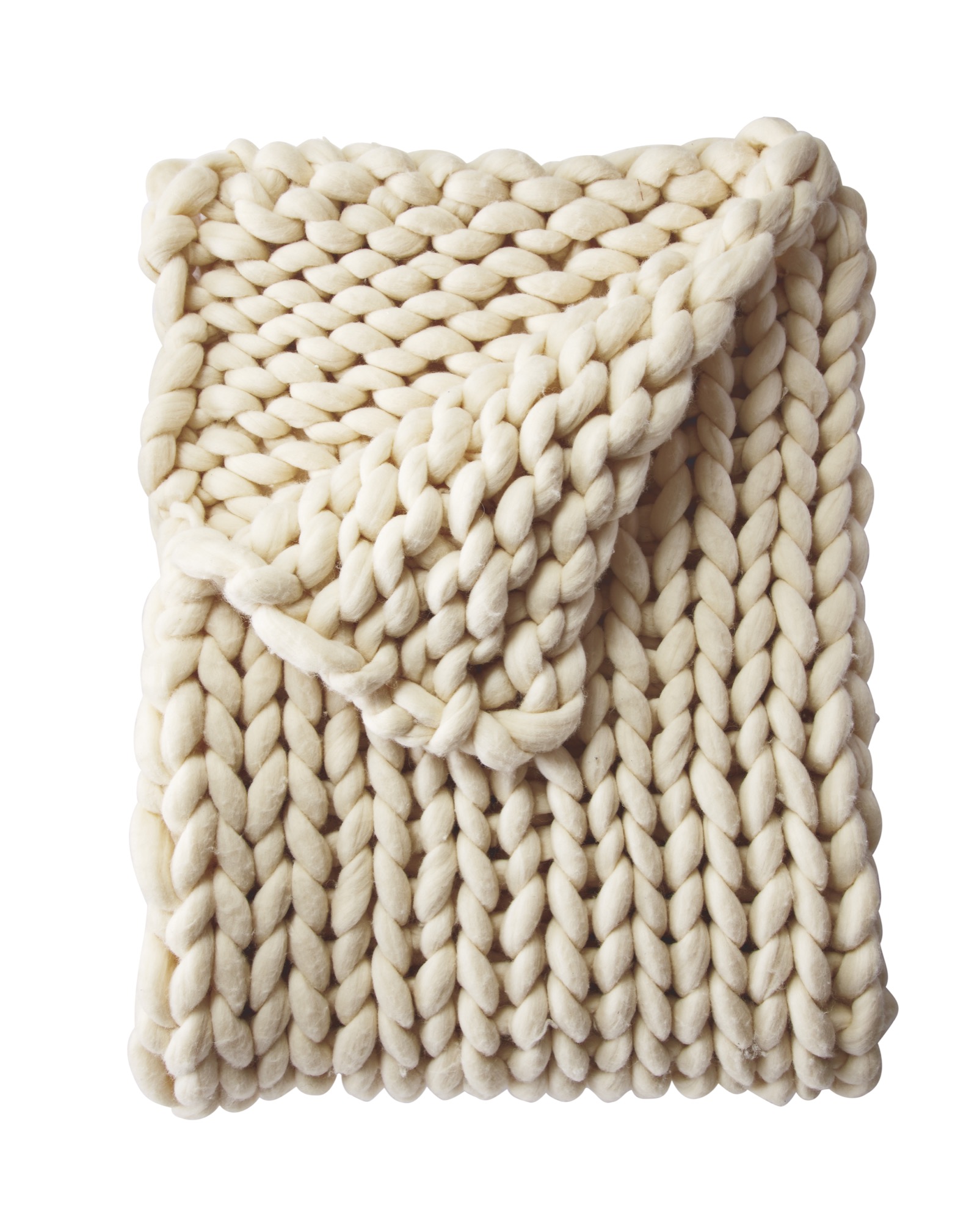
This snuggly roundup is curated by our interior design contributor Jennifer Rhode. Meet the Boulder interior designer and contributor.
Introducing Jennifer Rhode
Our new interior design contributor will share her insights on creating an alpine-modern home
Meet Jennifer Rhode, a fresh voice on Alpine Modern Editorial. Based in Boulder, Colorado, the cosmopolitan interior designer and writer will regularly share her insights on making your home alpine modern through considered, quiet design. Her thoughtful narratives and approachable decorating tips will inspire you to move past the idea of “more” and focus on creating beautiful spaces with less. The California native will curate elevated styles and objects from the international world of design that embody functionality and quality craftsmanship.
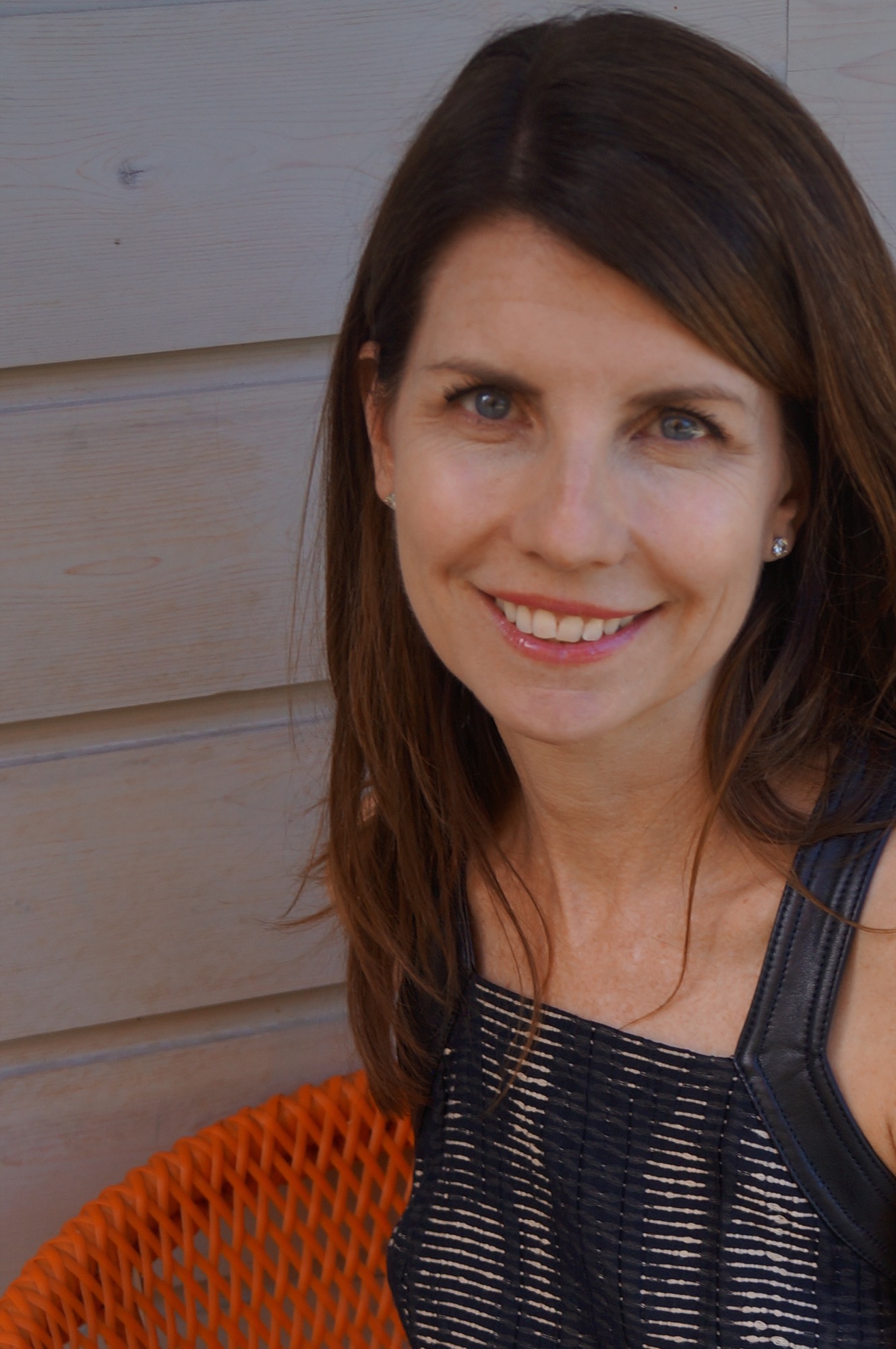
At home with Jennifer
One sunny afternoon this fall, Jennifer invited me into her bright, modern home in North Boulder. We instantly bonded over raising fifth-graders and missing life in Europe. The petite brunette exudes a warm intelligence that at once makes you trustfully open your mind to what she has to show and tell you. The self-proclaimed “nester” surprised me with a delightful spread of fruit and cheese... and a dining table covered in notes and visuals on inspiring ideas for upcoming interior design stories and roundups, which we can’t wait to share with you—beginning next week with a collection of chunkily knitted home goods that are equally cozy and modern.
Jennifer Rhode’s design background
Jennifer began her career in fashion and wardrobe styling, working on television commercials and shows in New York City and then moving into window design in San Francisco. The mother of two has spent the last ten years working on interior spaces in San Francisco, Amsterdam, and Boulder. The designer draws inspiration from the many cities and environments she has lived in. She loves the dichotomy of mixing antique and modern, blank areas with pops of color, simple structures with a striking piece. And she always loves some whimsy thrown in. △
Title image: Interior design by Jennifer Rhode / Photo by Bob Carmichael
The Building Friendship
Friends since preschool and sharing a love for design and the mountains, the founders of MTN Lab, an experimental furniture and art studio in Colorado, have always been building things together
Harris Hine and Rudy Unrau have been best friends since preschool. Now both 27 years old, they have founded MTN Lab, an experimental furniture and art studio in Colorado. Growing up in Boulder, Colorado, the lifelong friends have been building things together since they can remember—skis, bikes, random projects. But it wasn’t until spring 2015 that the idea for MTN Lab was born. Both back in Boulder, Hine and Unrau began showing sculptures at Studio Como in Denver’s RiNo art district at the time. “Getting in there is what really materialized the company,” Unrau recalls. “That’s when we came up with our name and went from just building stuff to actually focusing on a business.”
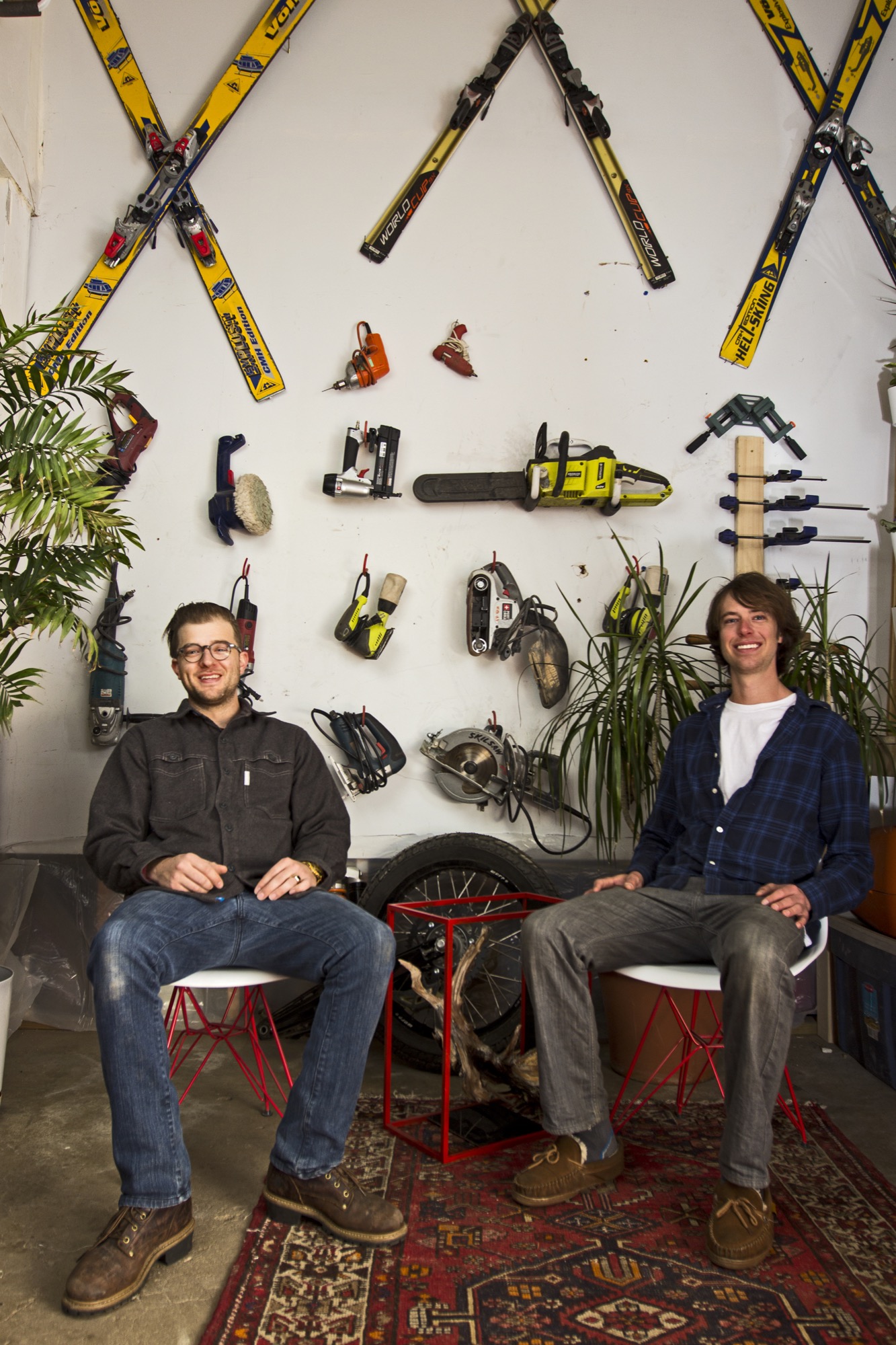
The two men, both quiet and reflective, share an ardent love for design and the mountains. Yet, they come together at MTN Lab—at the intersection of art and adventure—from opposite directions: Hine a trained designer and woodworker, Unrau a former professional mountain biker turned woodsman fighting wildfires for the Forest Service.
Harris Hine
Harris Hine grew up profoundly influenced by his father, Vienna-born modernist architect Harvey Hine, who founded HMH Architecture + Interiors in Boulder.
“I’ve always been torn between the design side of my personality and just wanting to be in the woods,” Hine shares. He went to school for design at Pratt Institute in Brooklyn before moving from New York City to Portland, Oregon, where he worked as industrial designer. “I didn’t find any fulfillment doing other people’s projects, and I didn’t really like the mass production side of product design,” he admits.
All those years, Hine pined for the woods, where his old friend was.
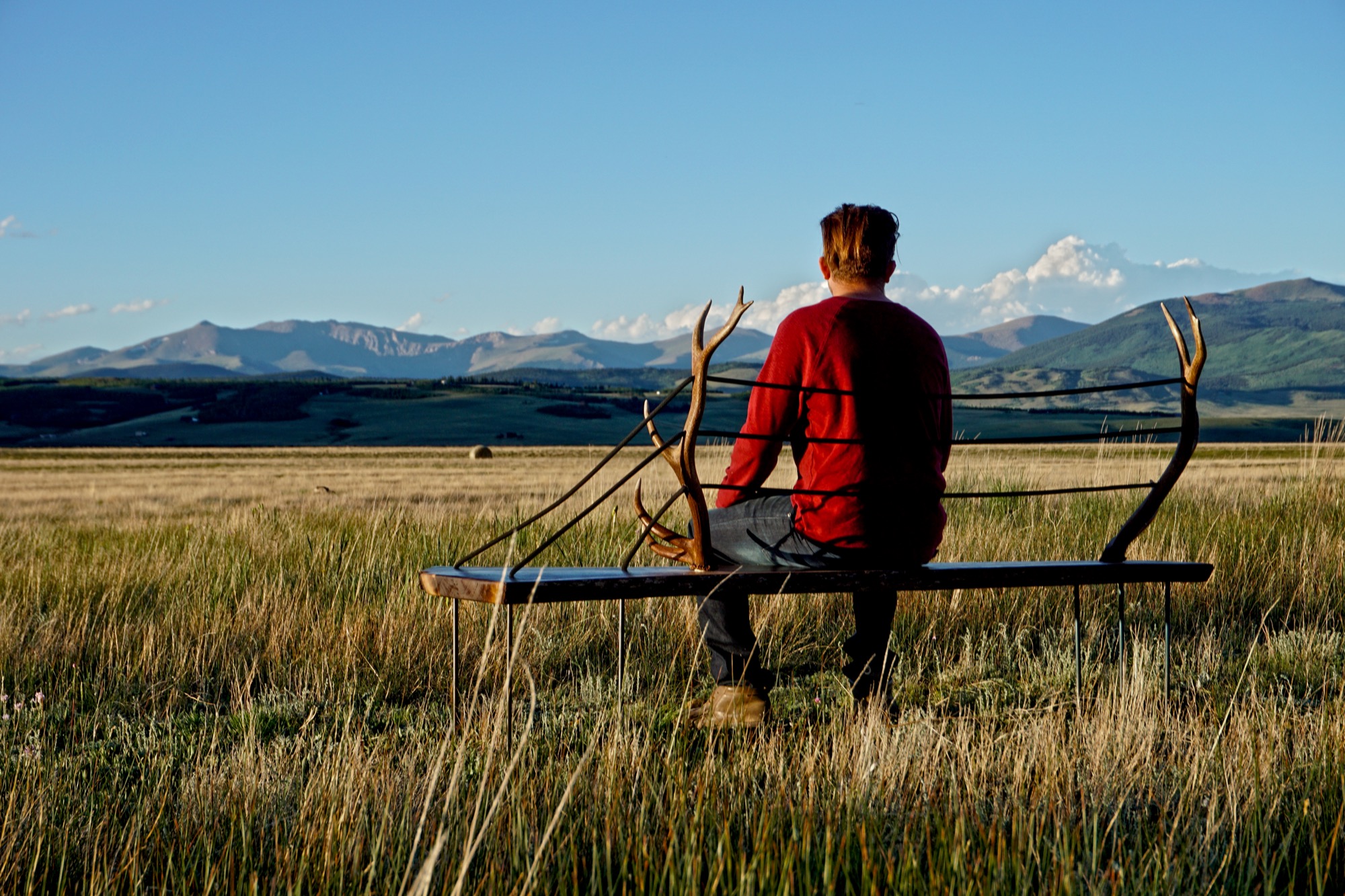
Rudy Unrau
Unrau, while attending college in Western Colorado, signed on with the United States Forest Service. “I was on track to becoming a smoke jumper, working for a helicopter crew down in Durango,” the long and lanky woodworker recounts. “It was a great setup because you work a ton in the summer, and then you get winter free to do whatever you want, like ski and move to Canada.”
Throughout those years, Unrau had been harboring the desire to return to making art. “Seeing the things you see when you get to fly around and travel the US and go to all of the mountain ranges... I had ideas emerge to work with the trees that had been burnt or partially burnt in fires because they get so twisted and cool.”
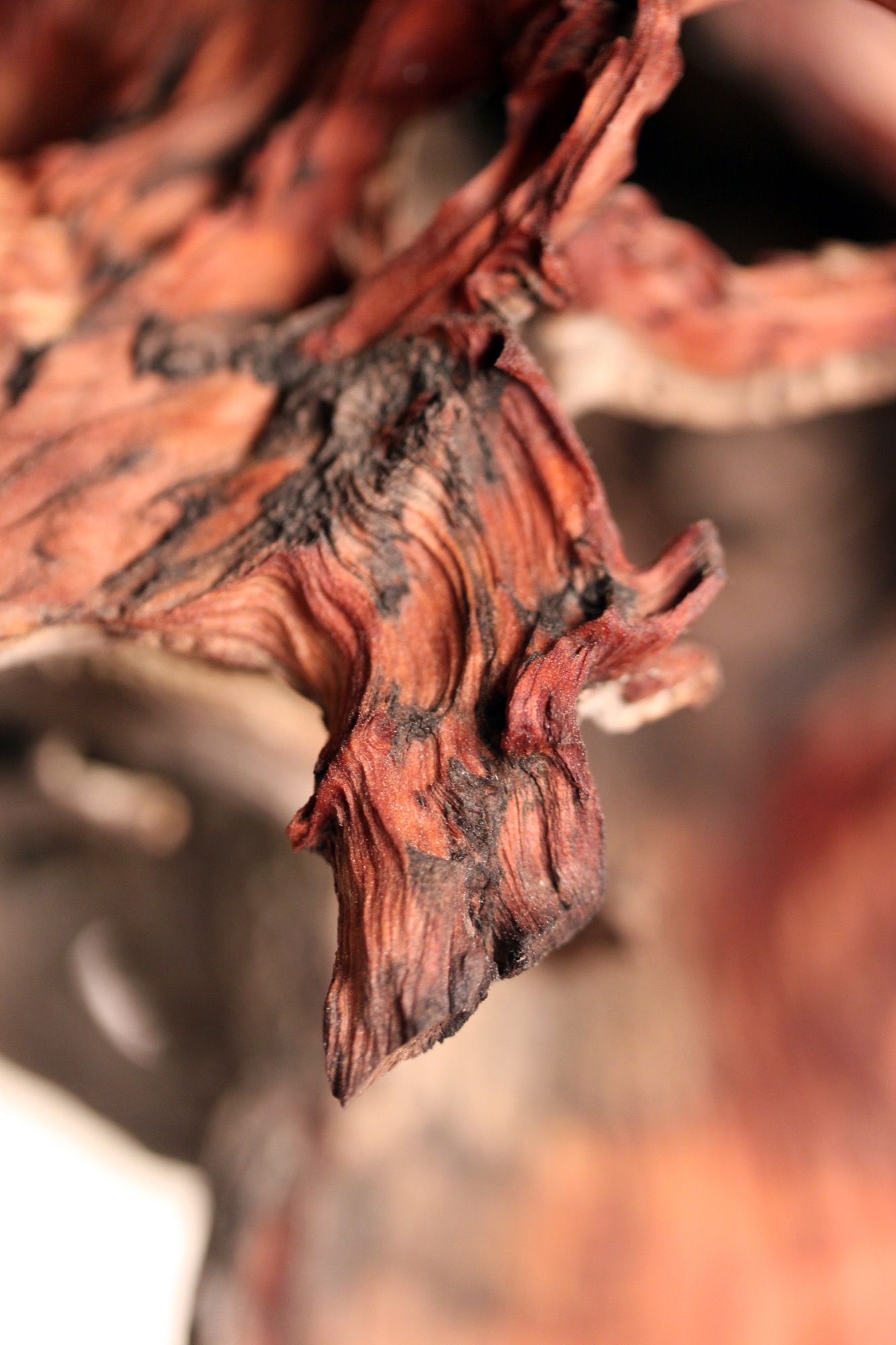
"I had ideas emerge to work with the trees that had been burnt or partially burnt in fires because they get so twisted and cool.”
Joint adventure up north
At last, one pivotal winter Hine and Unrau moved to British Columbia together to ski. Their close friendship and mutual influence would impact each man’s path. “Rudy was all in the woods,” Hine remembers, “Living together pulled him back into the design world and brought me back into the woods.”
Unrau agrees: “I’ve always been at home in the woods. Growing up, I really wanted to pursue mountain biking, so I raced mountain bikes professionally for quite a few years.” After the athlete got “a little bit tired” of mountain bike racing in world cups, he focused on skiing.
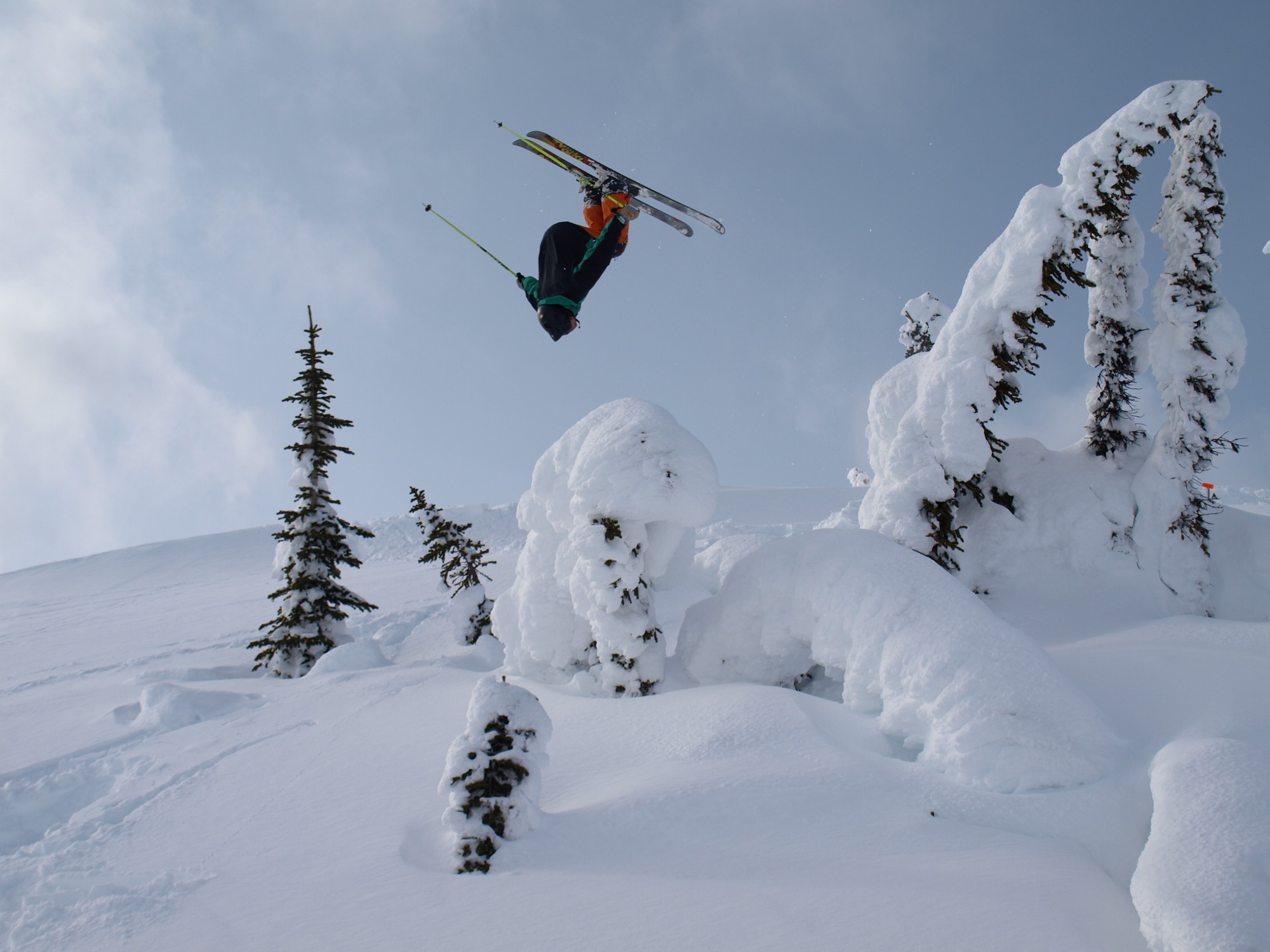
Skiing in Canada was good fun. Winter gone, however, Unrau planned to work another fire season. The outdoorsman envisioned himself carrying on that seasonal rhythm of demanding service and wild adventures in the snow for years until he had and his friend had their fill of youth and independence. “And... I crashed paragliding,” he tells, falling solemn all of a sudden. “I broke my back and almost died and spent half a year recovering.”
His loyal friend by his side, Unrau needed to reevaluate his future. “I realized, I wouldn’t be able to do fire again,” he says. “And then it was pretty natural the way MTN Lab came together—us getting our shop set up to where we could build.”
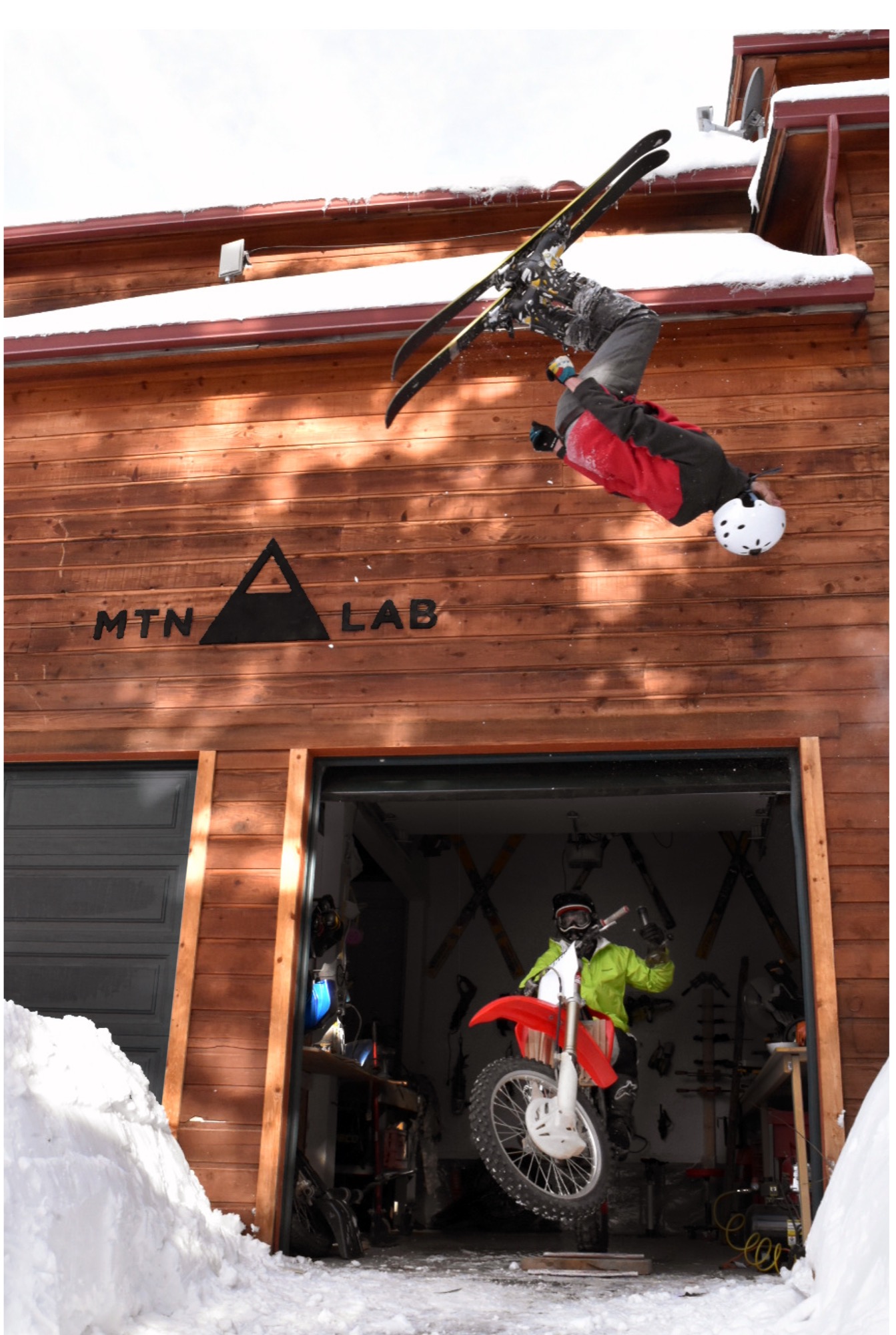
The MTN Lab process
Starting with sculptures, the duo soon began venturing into furniture. Their vision is to grow the Conifer studio into an art collective, with more creatives joining them. They are even planning to build a tiny house to accommodate visiting artists and designers.
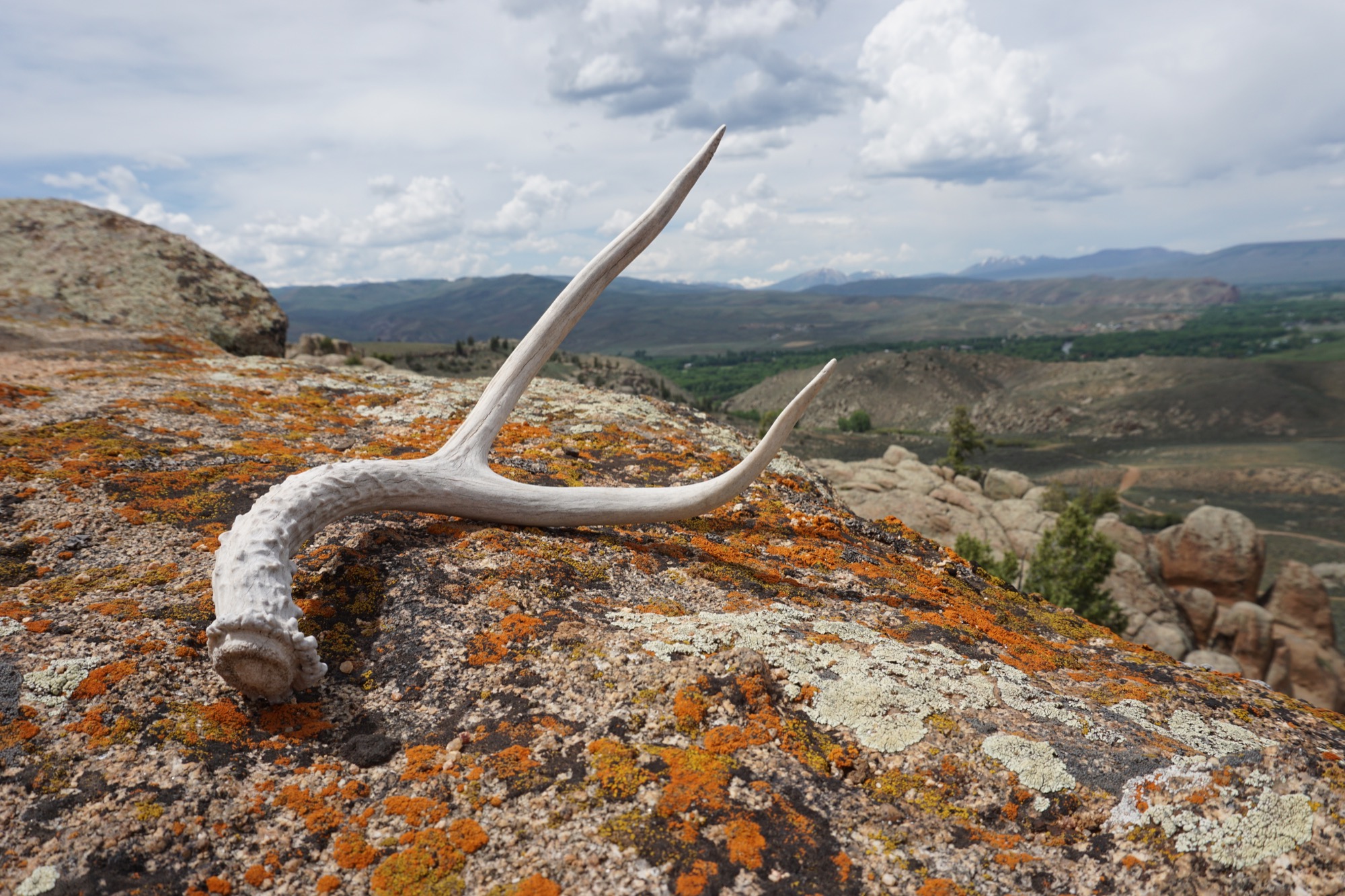
MTN Lab is as much a concept as it is a company. “Our process is the most indicative of what we make,” Hine explains. The founders source all of their materials themselves in the Colorado mountains. “We quarry our own stones to carve and collect our own wood.” Like it was for generations of makers in the mountains before them, MTN Lab’s workflow follows nature’s rhythmic swing. “Right now it’s the season for us to go get river stones because the flow just came down,” Hine tells me, when I sit down with him and his partner on that warm day in early September. “And we are doing antler stuff because we found a bunch of Elk sheds. That’s this flow that we follow.” Adds Unrau: “Our company is trying to do the whole process from sourcing, getting our materials, designing it, building it ourselves, photographing it ourselves.”
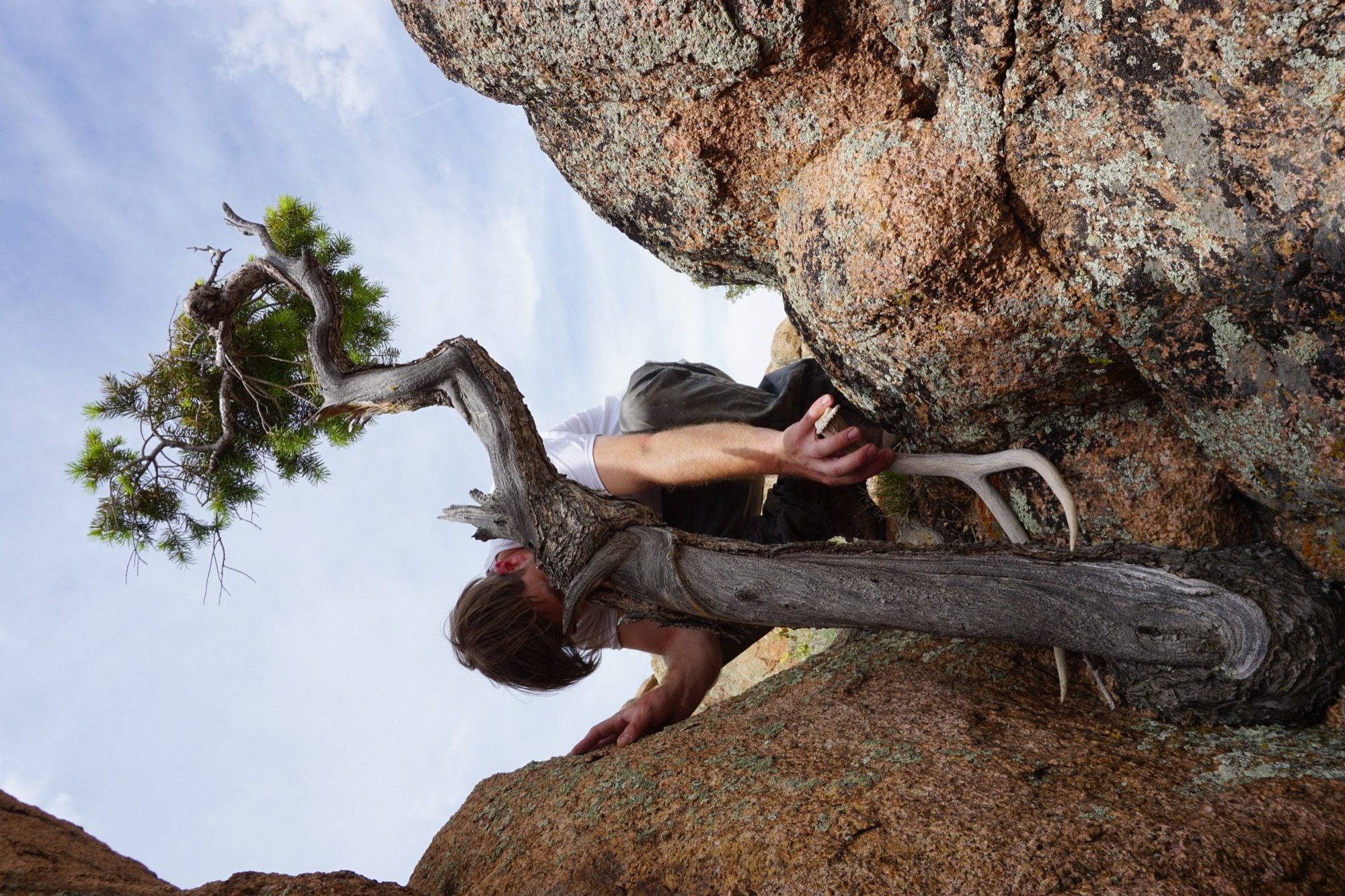
The friend believes having grown up in the mountains is what motivates them to see the entire process through, from beginning to end. “Spending all of your free time in the backcountry—you’re just so inspired by what you’re surrounded by,” Unrau says. “Initially, we were out there to ski, climbing to ski. We were dirt-biking. But when you spend that much time out there, it altered our perception of why we were there. And now it’s awesome because we get to ski, but that’s not the whole part of the process. The ski is the vessel for finding the materials—as well as the inspiration.”
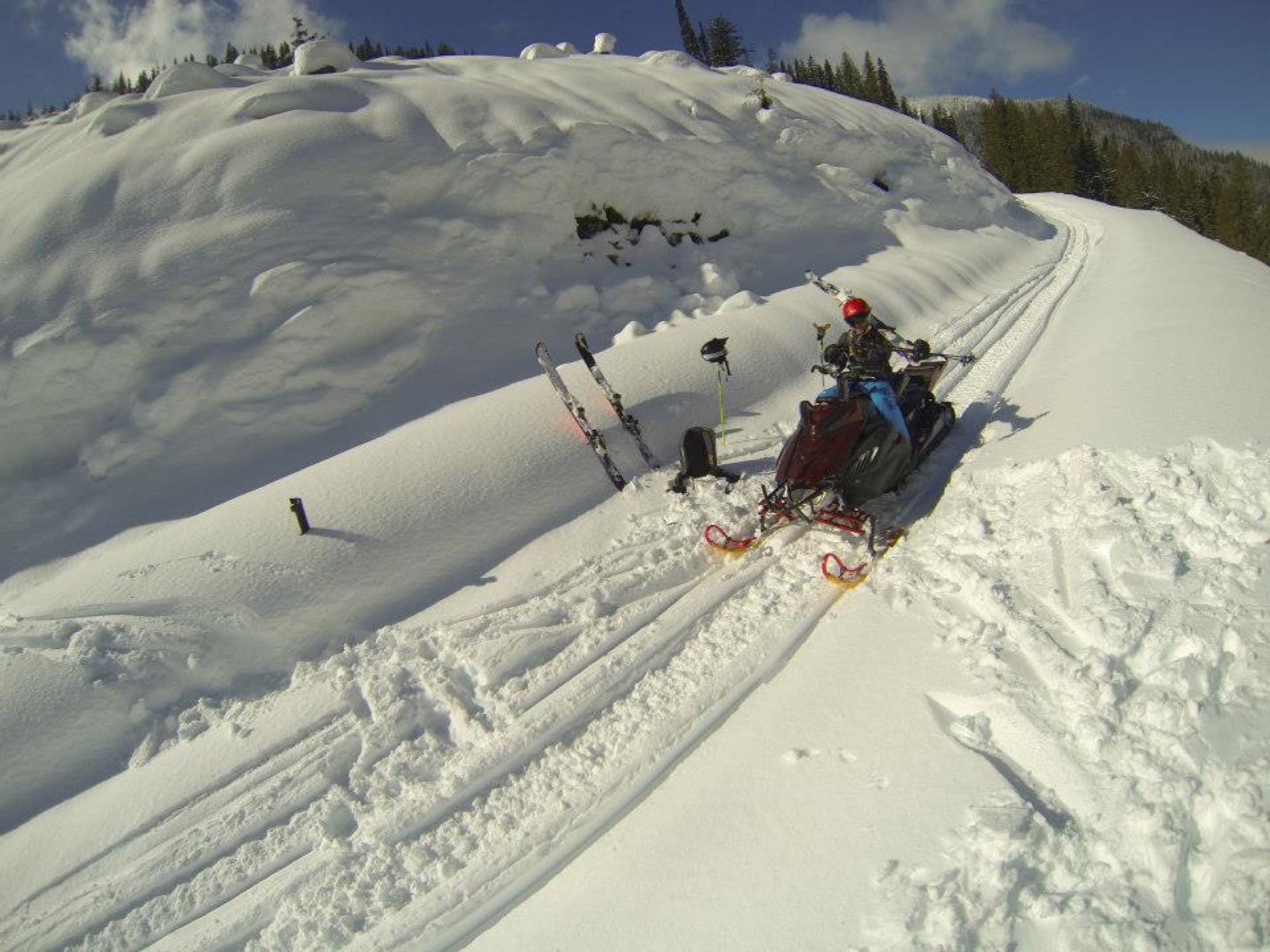
“The ski is the vessel for finding the materials—as well as the inspiration.”
Connecting nature and art
“I’ve always liked minimalist design, and I rarely see that done with natural materials,” Hine says. “You look at Bauhaus stuff, and it’s very industrialized. My dad being the modernist he is, half of me is always striving for that simplicity. But then there is the other part of me... the Colorado guy. And I see these cool pieces of wood and antlers and it naturally merged. In college, I was more on the industrial, clean-cut metal side of things, and my style has evolved more and more into a hybrid of rustic and modern.”
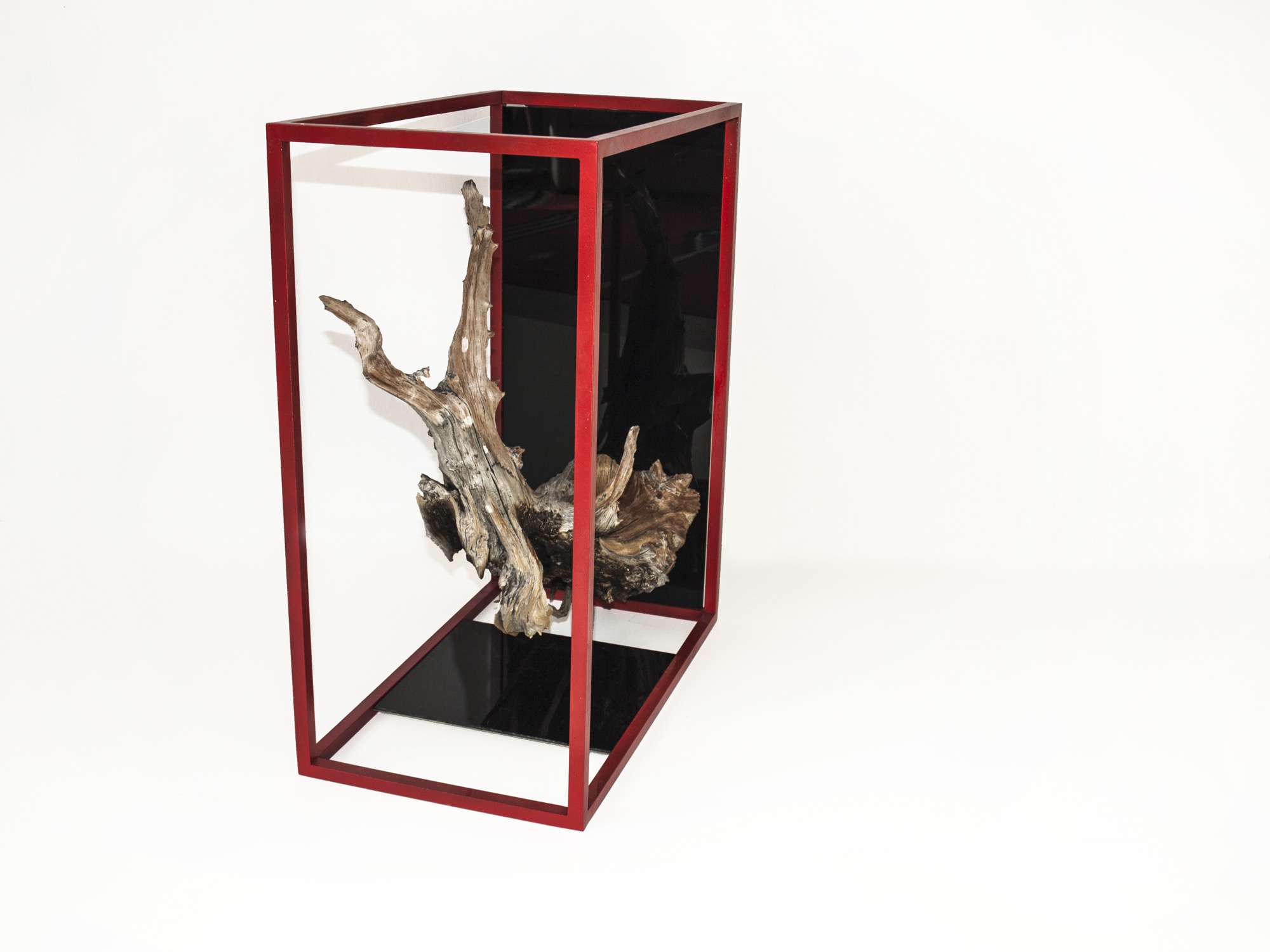
Unrau, for his part, never earned an art or design degree, nor does the lack of academic study in the field limit him in his current work. “We really do our designing when we’re out in the woods. We don’t sit down in an office to draw. We see the material, and the material almost dictates its design.”
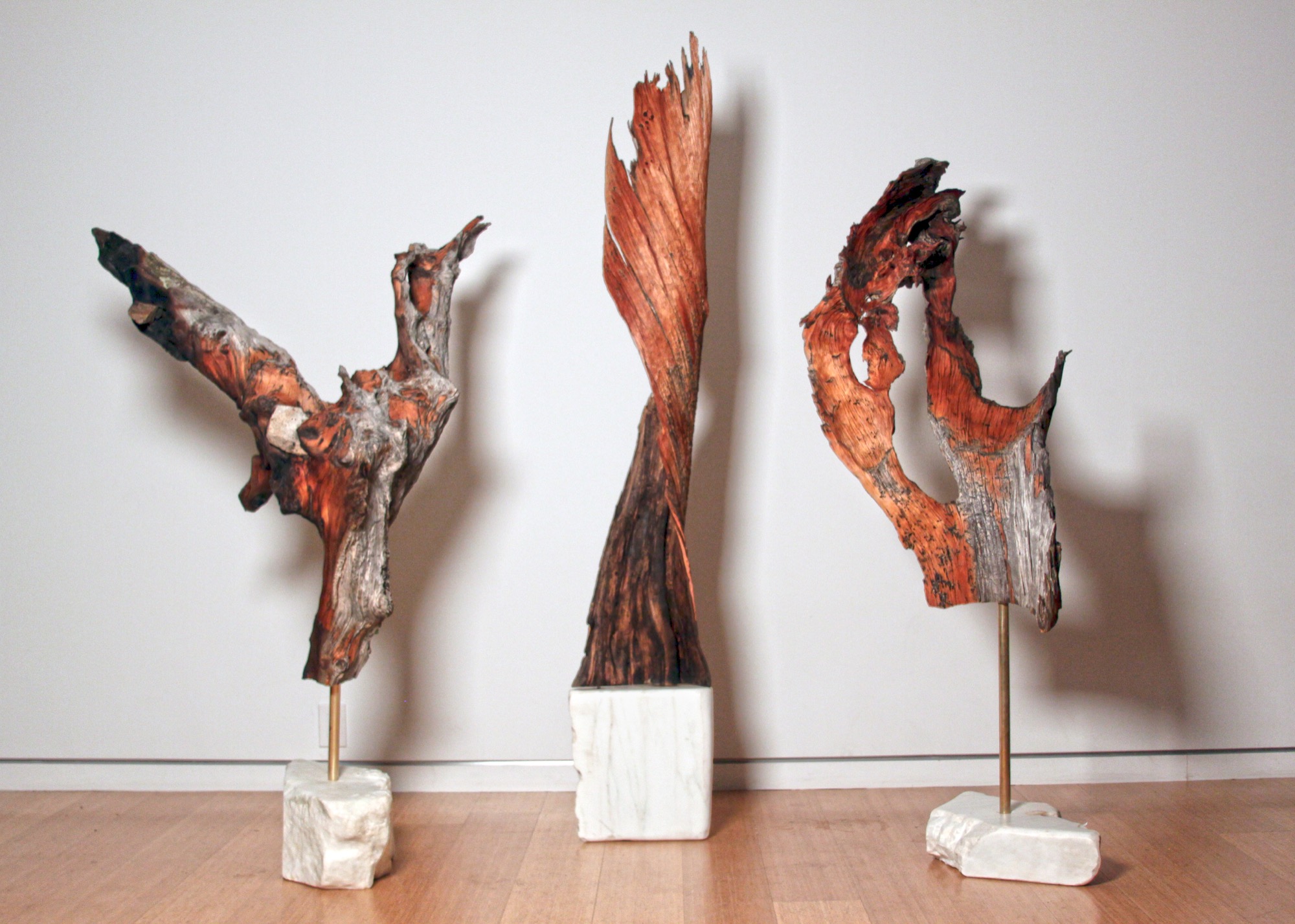
They usually know right away, if a piece of wood they come upon in the forest will transform into an art sculpture, a table, or something else entirely. Back at the studio, they combine found pieces of wood or elk shed with marble and often with contrasting metal. The final artwork or furniture piece comes together like a collage. While the sculptures are never drawn out, the furniture generally is. “We design our table bases, draw them by hand. Sometimes, we bring it into CAD.”
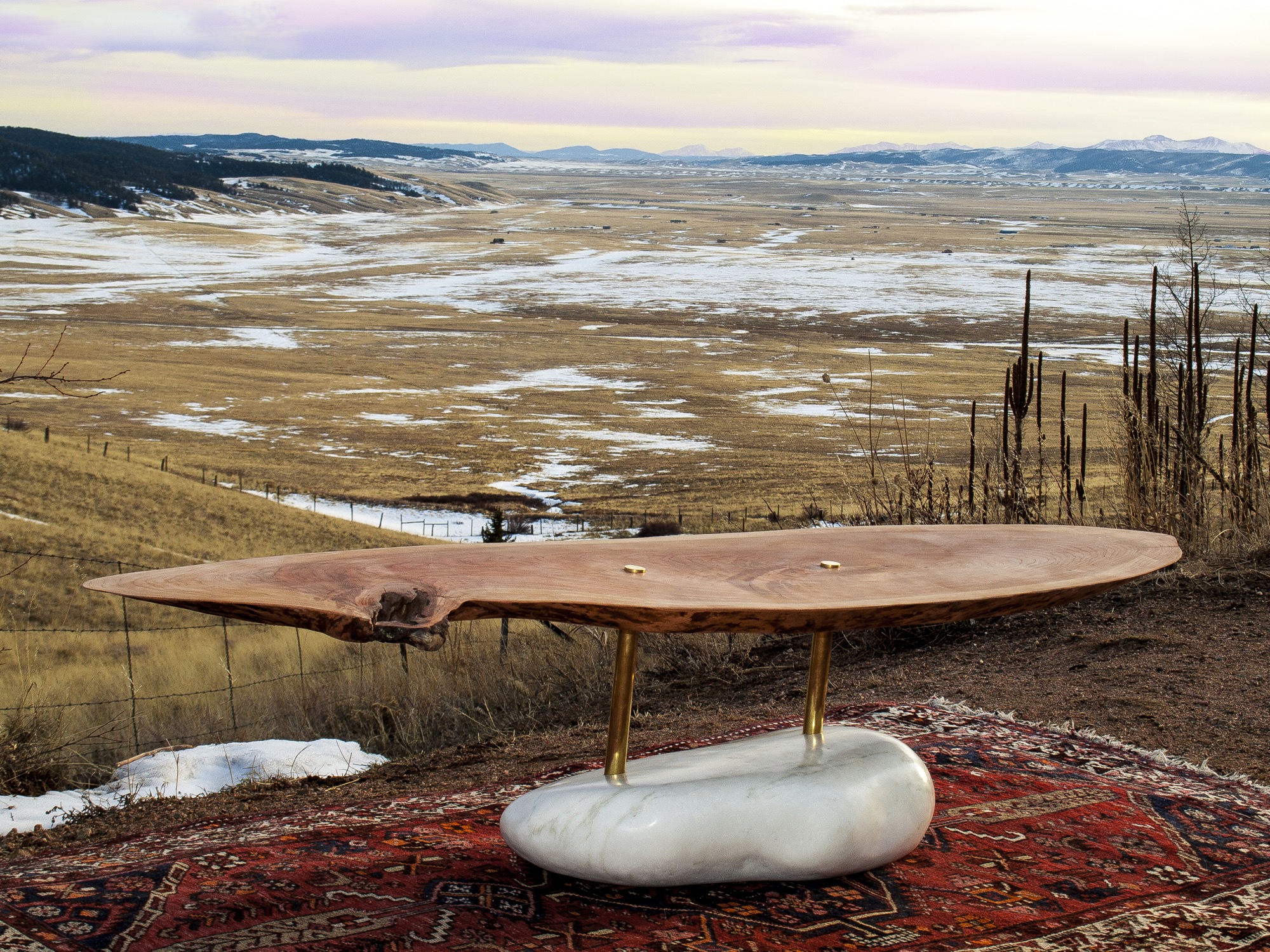
The day I met up with Unrau and Hine, they had come down from their studio above 8000 feet to deliver a piece of art they made for the Boulder Museum of Contemporary Art. “We had this mobile,” Hine begins, chuckling, “And then Rudy dropped it on the staircase, and we were like ‘Oh, no, we’re so crushed. And we had to quickly build it a second time yesterday, and it came out eight times better than the first. That process isn’t always easy to rely on, but sometimes when you make it again, it’s better. This is how we continuously design.”
Speaking about the synergy between Colorado’s magnificent nature, rich history and tradition, and progressive modern art, Hine notes that he is profoundly influenced by the stone carvings of American artist and landscape architect Isamu Noguchi. “It’s that blend of leaving these big natural boulders and polishing one face of it.”
Rustic designs with wood and stone are ubiquitous. “But it’s hard to find someone who has done them simple enough so that these materials individually speak for themselves,” hine says. “Antler furniture is really something we have been experimenting with, because it’s hard to find a simple antler-anything. All the chandeliers are the same hunter antler cluster. And all of a sudden, you are appreciating the simplicity of the singular antler as a sculptural element. That’s what makes it alpine modern, and not just alpine.”
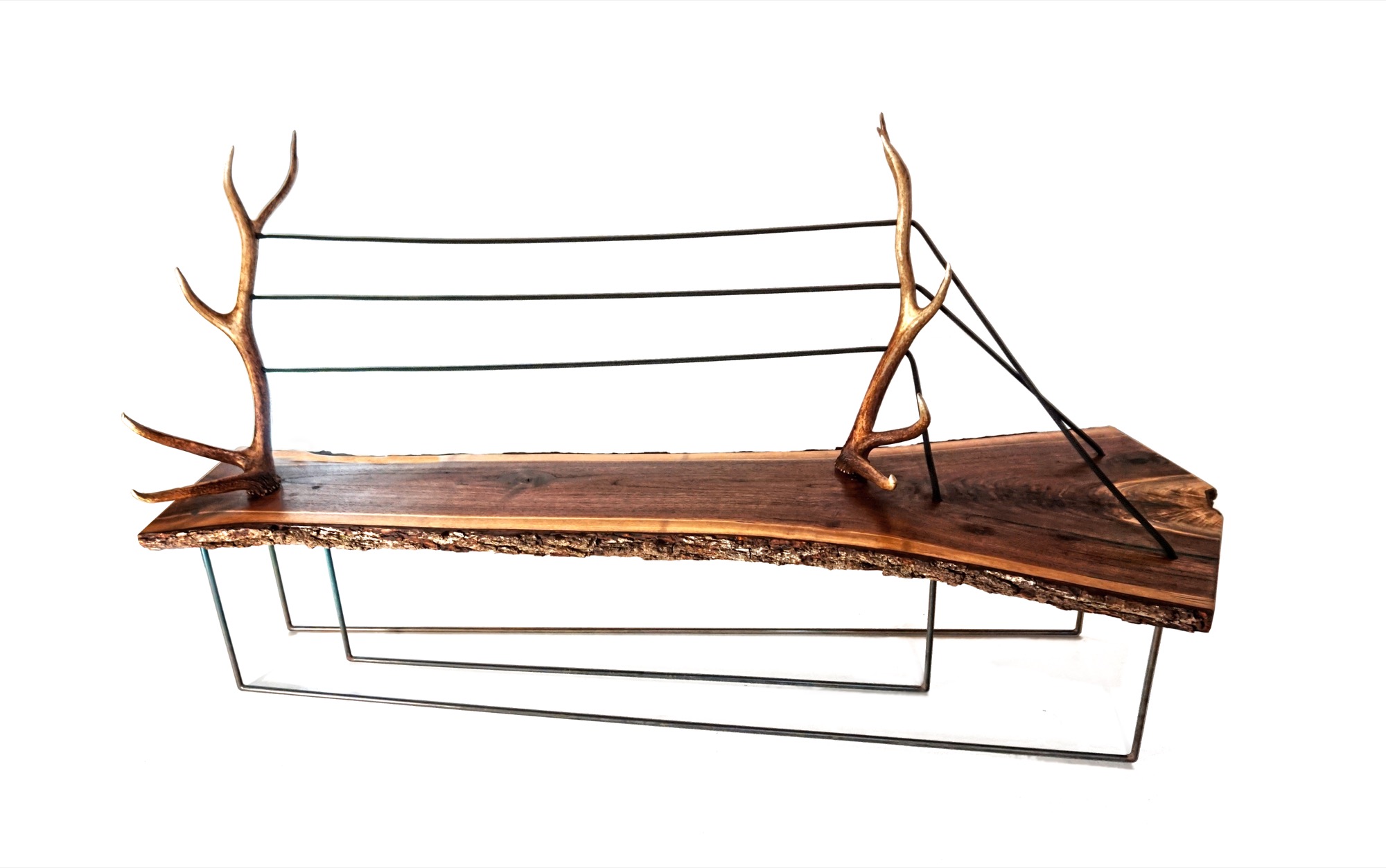
“And all of a sudden, you are appreciating the simplicity of the singular antler as a sculptural element. That’s what makes it alpine modern, and not just alpine.”
A modernists at heart, Hine still looks to the arts and crafts movement for inspiration. “Not stylistically but the whole concept of it is huge, especially since my education is in mass production and industrial design and product development. And going back to actually hand-building one-off pieces from the found materials we use, you can’t really build the same piece twice. It’s almost like we’re in an arts and crafts revival, which is weird for me because that’s the antithesis of the Bauhaus influence, of going from craft to industrial production.”
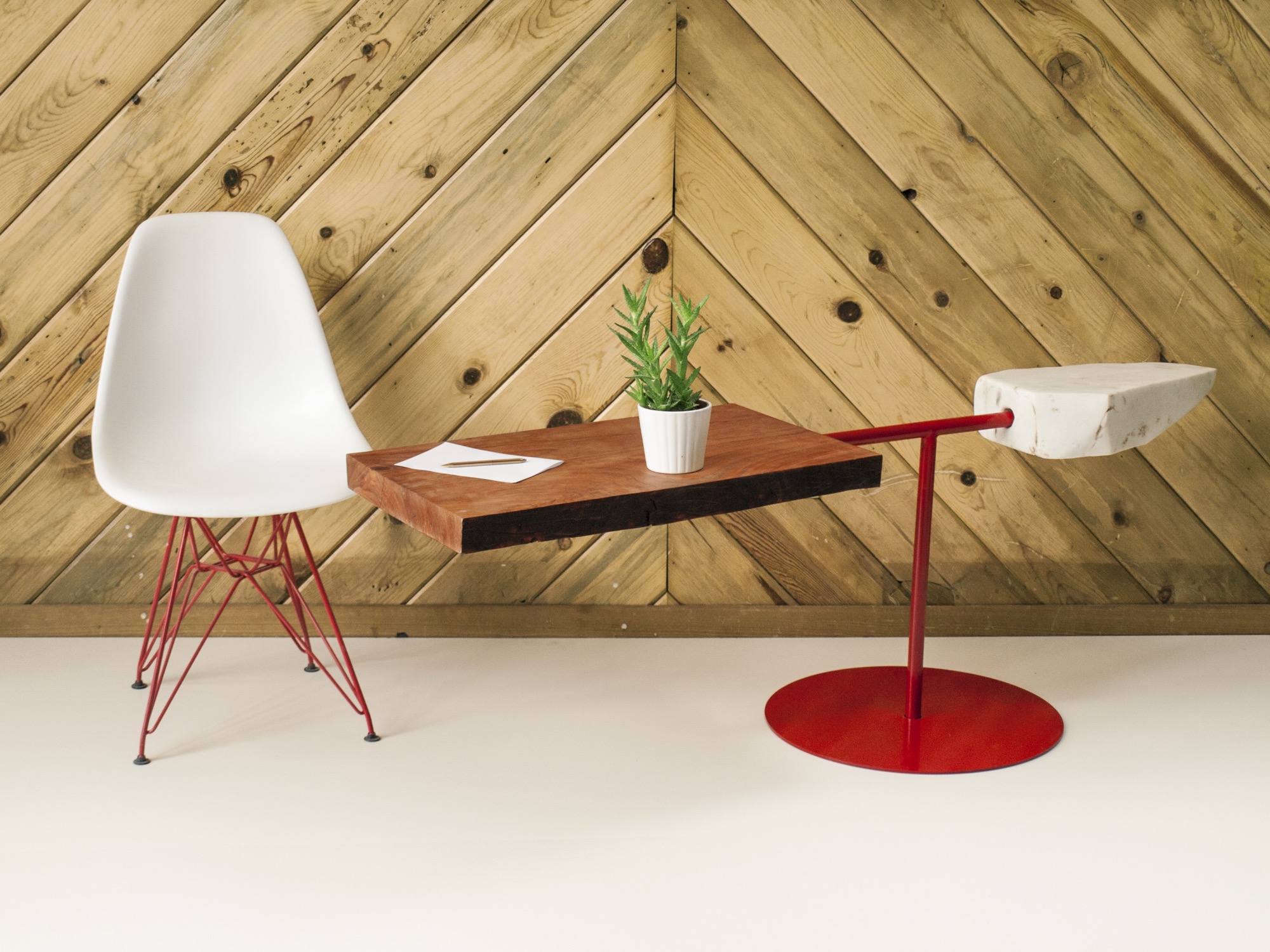
Our conversation later on reveals that the two 27 year olds are somewhat of an antithesis, too—to their fellow millennials. The Internet, they admit tittering, is their shortcoming. “Neither of us really enjoys social media, self promotion, or even doing the sales part,” Hine says. “It’s the cliché artist who doesn’t sell his stuff. We just are either in the woods or in the shop. It never feels like were working.”
MTN Lab projects
Each MTN Lab piece embodies a story of adventure and friendship.

For example, Unrau says seventy years ago, many trees were cut down to make room for high-voltage lines to Fairplay, south of Breckenridge, Colorado. “The company just left them, so these big old-growth rounds have been drying up there all these years,” he says. MTN Lab milled the pine rounds into table tops. “That’s our next big design push, designing bases for those tables,” he says. “Or the motorcycle, which is a lifelong dream we’ve shared since we were little kids.”
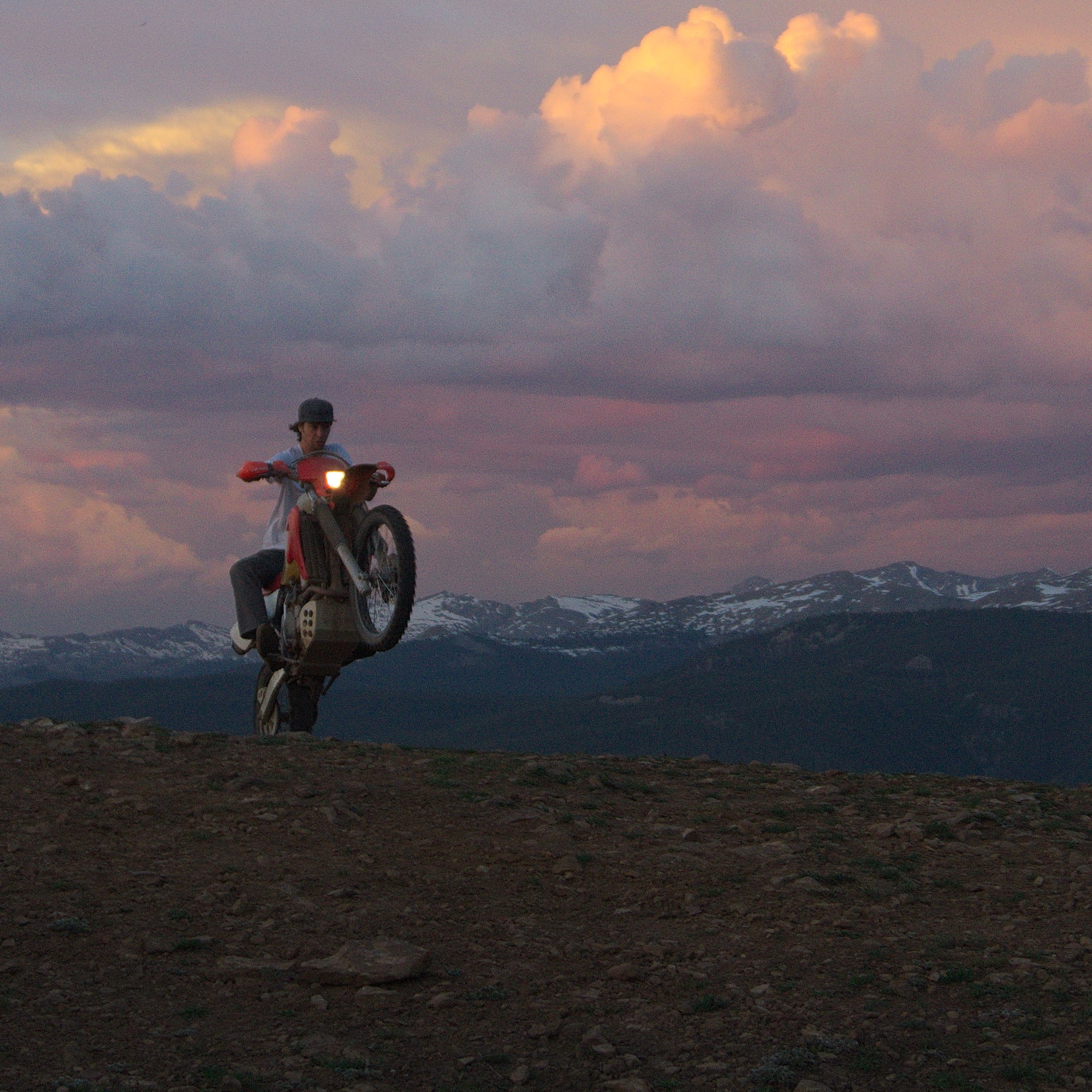
Indeed, Hine and Unrau want to build a motorcycle entirely from scratch, the back end made hand-carved in wood. Before winter, they even want to experiment with producing their our own steel, from mining the rock to crushing and melting it. Whether the resulting material will in fact be usable won’t matter as much: “At least we will be able to appreciate the process when we go to the store and buy steel.”
“The motorcycle is going to be very much like our furniture and our sculptures,” Unrau says. “I would describe it as an art bike. It’s going to be functional. It’s going to ride very well, but it’s not going to look like a conventional motorcycle. I don’t know if we’re going to be willing to sell it.” The business partners are also debating whether they will ever have the heart to sell the 1960s Airstream that once belonged to Unrau’s grandfather and they just finished restoring. “I never want to sell any of our stuff,” Unrau admits, laughing. “It’s hopeless.” △
Airstream Dreams at AutoCamp Russian River
Wes Anderson meets the W Hotel at AutoCamp Russian River, where guests sleep in custom Airstream trailers and lounge at the midcentury-modern clubhouse
Nestled in the Russian River Valley, AutoCamp’s custom Airstream trailers and midcentury pavilion provide a boutique camping experience.
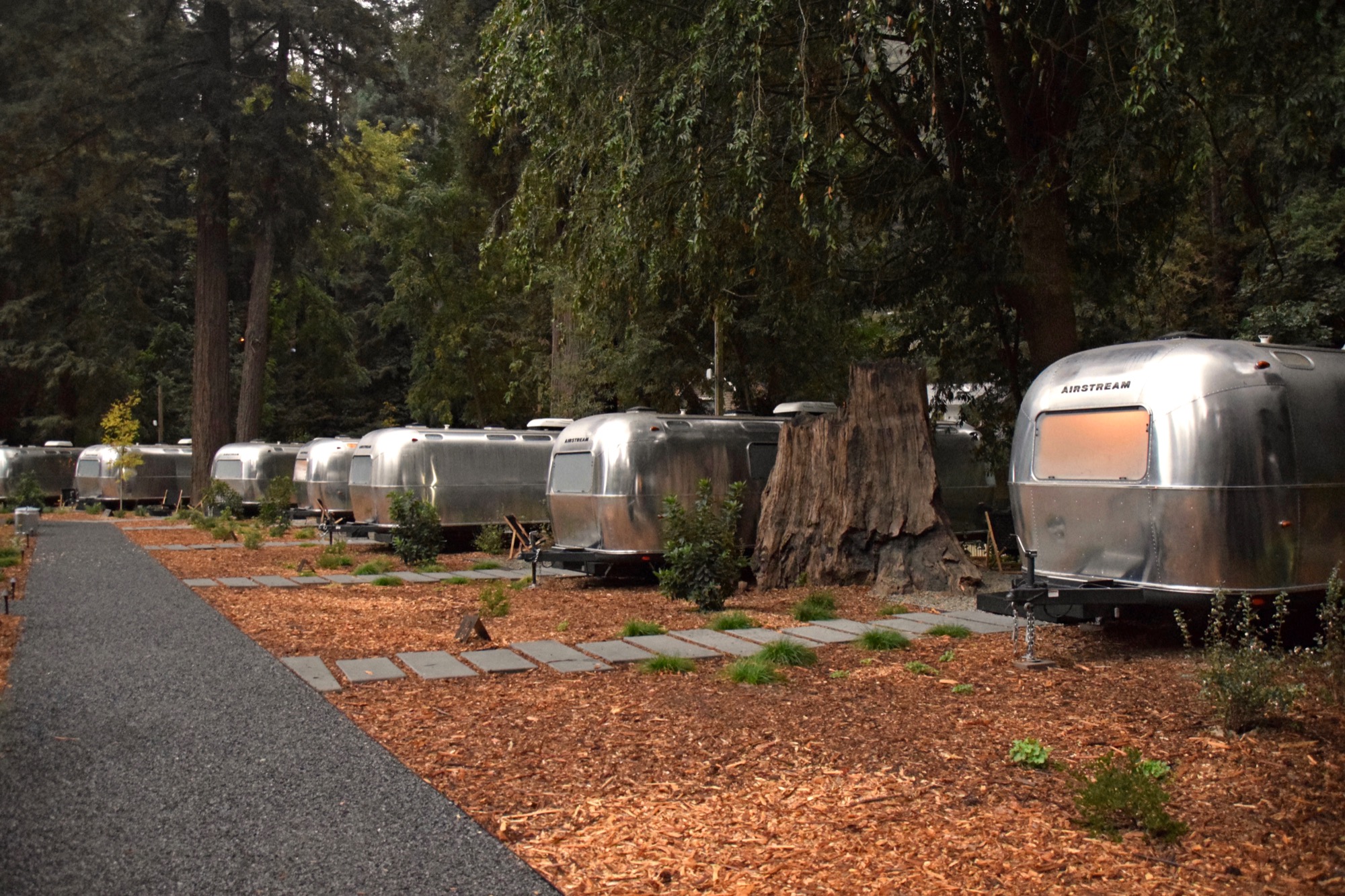
First established as a logging community in the late 1800s, the town of Guerneville, California, has grown to become an artist enclave, queer haven, and tourist destination. Seated in Sonoma County, Guerneville benefits from its proximity to wineries, redwood forests, beaches, and the bucolic Russian River, which winds along the 101. It has also been riding a new wave of revitalizations, most recently manifest in the opening of AutoCamp’s second location at the end of the town’s main strip. A cross between boutique hotel and campsite, AutoCamp Russian River is known for its Airstream accommodations, artfully furnished tents, and midcentury modern Clubhouse.
Over at Dwell.com, we had written about the Clubhouse before its opening and were eager to see the "glampsite" for ourselves, so we packed our bags for a weekend trip. What we discovered there is equal parts design and adventure. Whatever the category of trip—family outing, Airstream appreciation, or corporate retreat—AutoCamp allows you to “rough it” in style.
"A cross between boutique hotel and campsite, AutoCamp Russian River is known for its Airstream accommodations, artfully furnished tents, and midcentury modern Clubhouse."
The heart of the community
Turning off Old Cazadero Road into the parking lot of AutoCamp, we were greeted by the Clubhouse, a modernist structure designed by ANACAPA. It provides a sense of arrival and sets the tone for the experience. It also stands as metaphor for the continued renewal of Guerneville, since it sits on the very site of the clubhouse belonging to Spooner’s Resort, an ill-managed, unsavory RV park that was previously on the property.
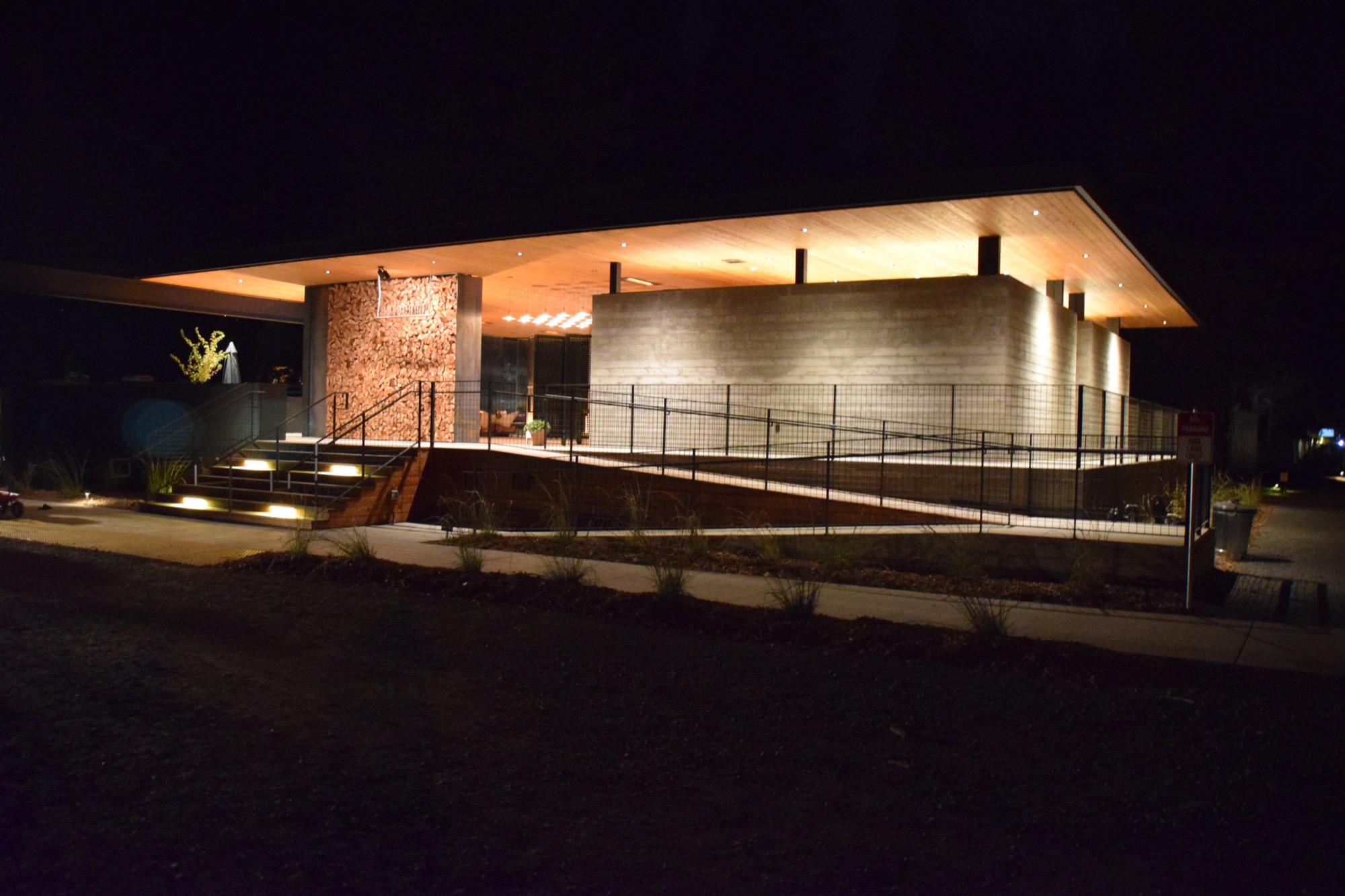
For the 3,000-square-foot structure, Dan Weber drew inspiration from midcentury masterpieces like the Barcelona Pavilion by Mies van der Rohe and the Kauffman House by Richard Neutra. The pronounced horizontal planes of the Clubhouse are a launchpad for the soaring verticality of the surrounding forest. Its robust material palette of board-formed concrete, locally harvested redwood, and blackened steel not only speaks to the natural setting, but also acts as safeguard against the periodic flooding that occurs in the area.
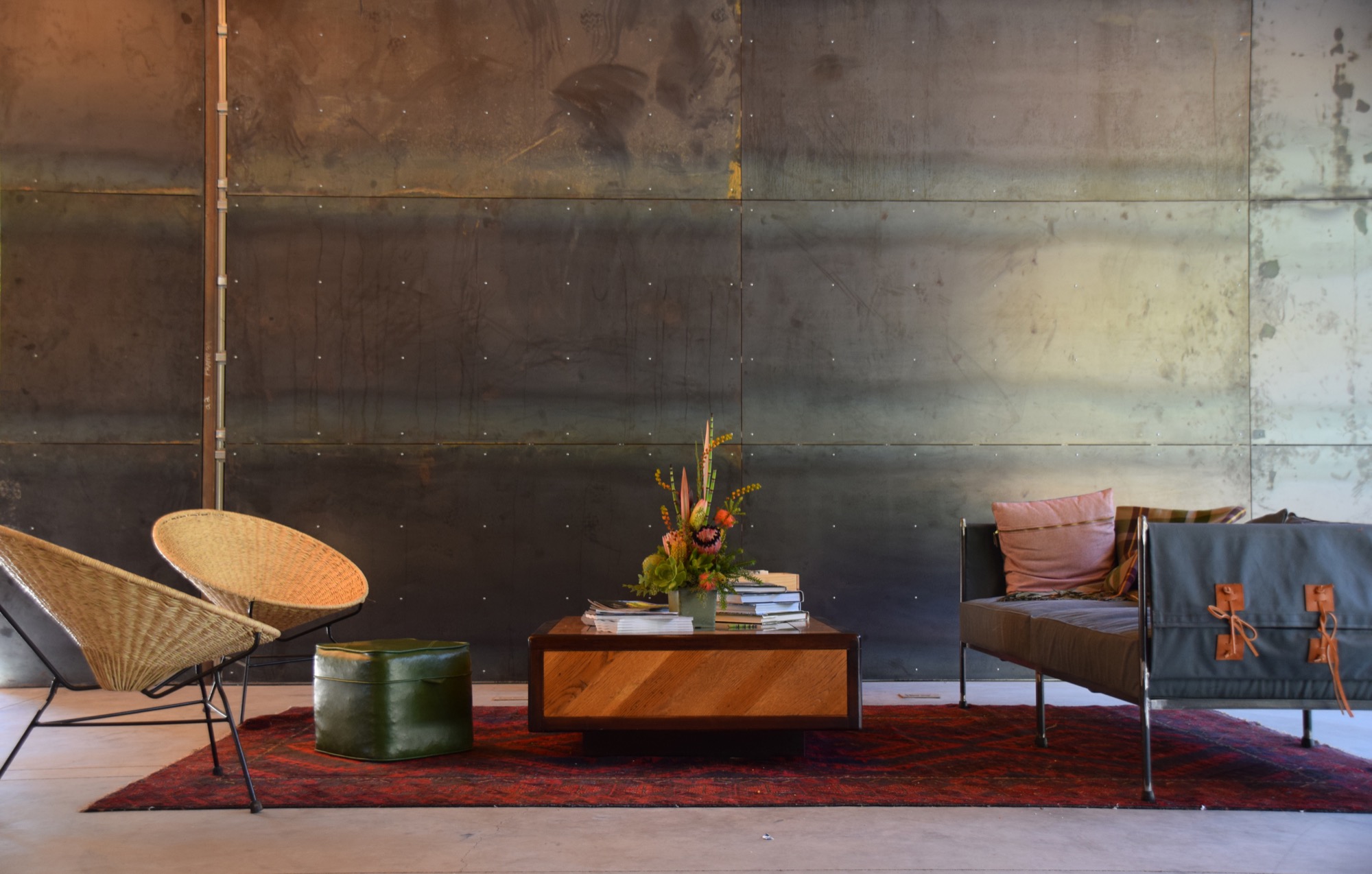
The Clubhouse evoked a persistent sense of homecoming as we jetted to and from camp. For guests, it is the reception area and rallying point: a hanging fireplace and custom-designed furniture by Alexis Moran invite you into their halo of warmth; on the north side, an outdoor fire pit offers views of the meadow and the glinting Airstreams that encircle it. There’s a lounge section stocked with books and magazines, an ideal spot for enjoying a cup of joe from the coffee bar—and for those staying in canvas tents, the Clubhouse provides luxurious bathrooms and showers. With so much traffic, the Clubhouse is the true heart of the community, a place to decompress, play a game of dominoes, and meet and swap stories with fellow travelers.
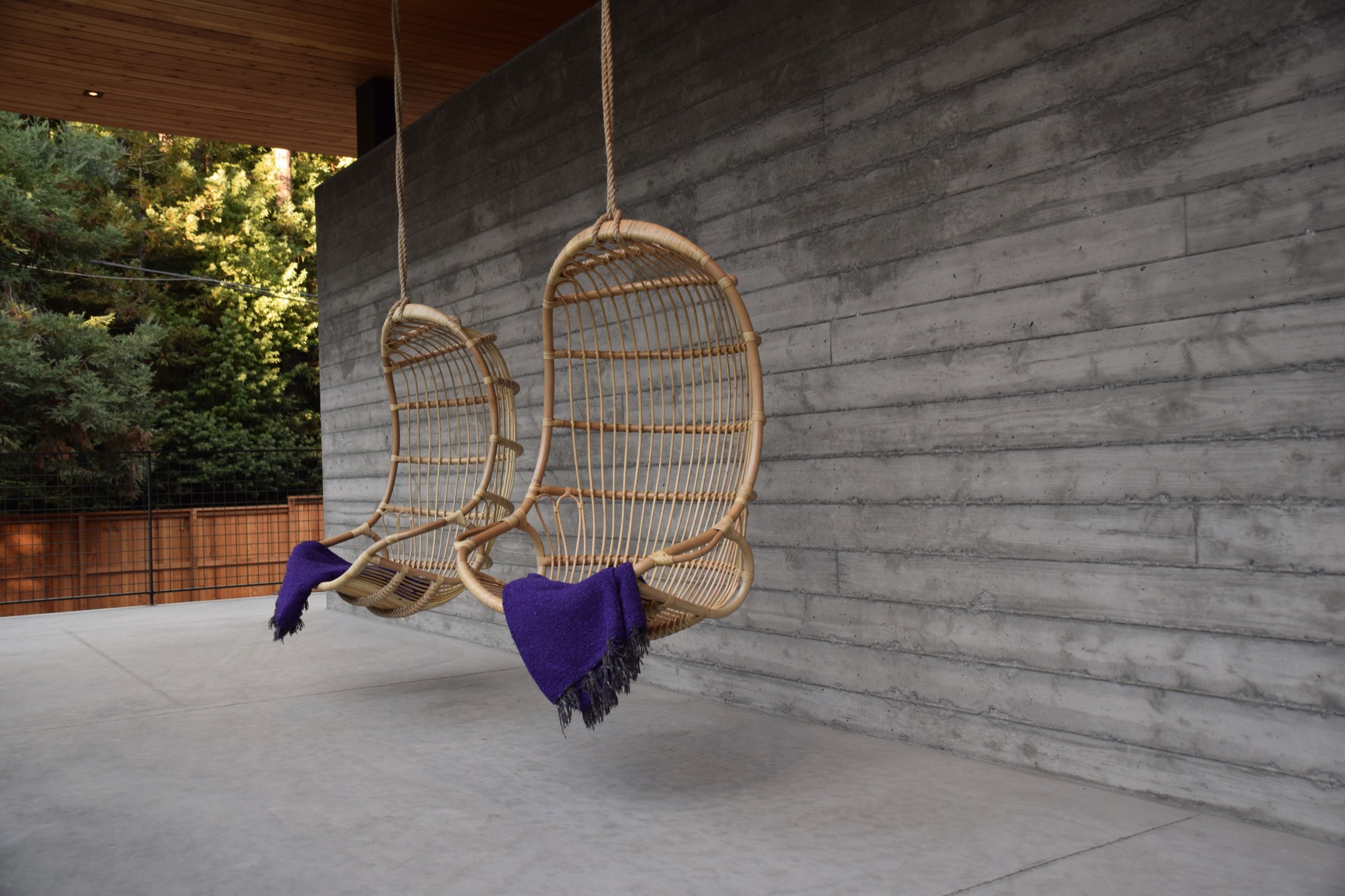
Ryan Miller, co-founder of AutoCamp, is excited about putting down roots in Guerneville. Originally from southern California and now a Bay Area resident, Miller had been driving up the coast on a road trip when he came across the town. Immediately, he knew it was something special. “It’s the tightest community,” he said. “You get the sense that something is peaking.”
The AutoCamp experience is always evolving, and there’s room for the community presence to grow even stronger. Future programming like yoga classes, ecology talks, movie screenings, kids’ activities, and maker workshops will revolve around the Clubhouse. Already, it has hosted a pop-up event with local entrepreneur and restaurateur Crista Luedtke—whom many credit for Guerneville’s transformation—serving dinner, and Phoebe Dahl of ethical clothing line Faircloth Supply Co taking over the Canteen, the Clubhouse’s general store.
Setting Up Camp
By day, the 23 Airstreams on the grounds have a striking effect, their silver bodies giving off a pearlescent glow; by night, their windows gleam in the darkness. Whether you’ve been a longtime fan of this American icon or just discovering the classic camper, staying in a custom-designed Airstream is a rare experience. Thanks to the vision of architect Dan Weber and interior designer Lauren Geremia, the accommodations strike a balance between rustic and modern, emphasizing comfort without losing their connection to the outdoor setting.
“She had a good feel for the culture,” said Miller of Geremia. “It was cool to work with someone who could facilitate so many creatives coming together.” From sourcing artwork to recruiting furniture makers like the aforementioned Moran, Geremia helped realize the warm, folksy vibe that pervades AutoCamp. We were taken with every detail: pendant lights by Schoolhouse Electric hang on either side of an indulgent Casper mattress, and vintage Observer’s books provide a bit of bedside reading. The homespun touches complement luxe elements like the marble tiles lining the bathroom and the crisp walnut cabinetry.
"Whether you’ve been a longtime fan of this American icon or just discovering the classic camper, staying in a custom-designed Airstream is a rare experience."
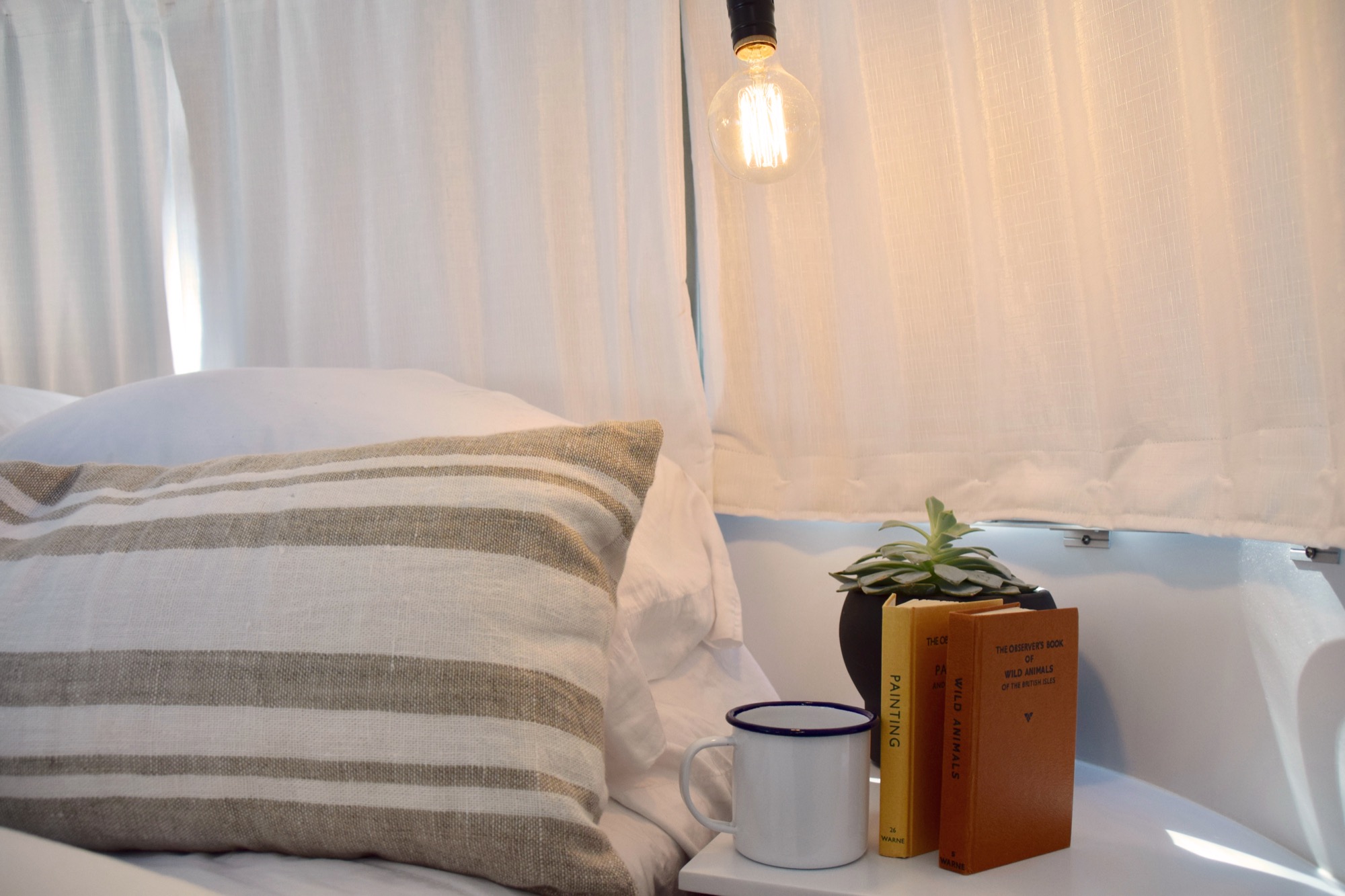
For those who prefer to hibernate at home base—or just want to relax after a day of traipsing through the woods—the Airstream is equipped with a wall-mounted flat screen TV and a Bluetooth sound system. A thoughtfully stocked kitchen and a private deck area allow you to brew coffee or fry eggs and bacon in the morning. And no campsite would be complete without a fire pit, the perfect stage for roasting s’mores (psst—if you forgot to grab marshmallows at the store, the Canteen stocks grab-and-go S’mores Kits).
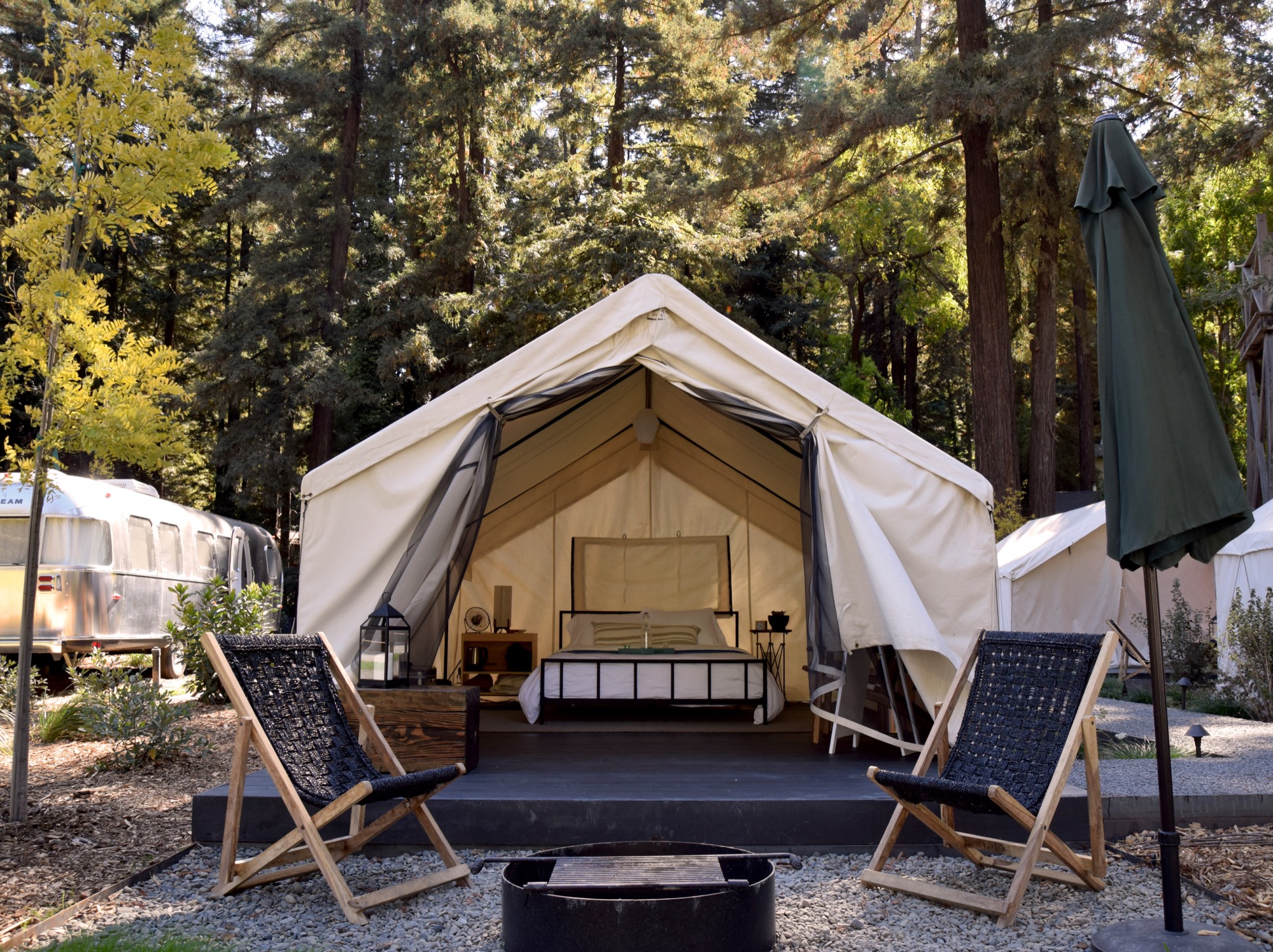
The 10 canvas tents on site, made by Wyoming-based Sheridan Tent & Awning, harken back to Guerneville’s heritage as a logging town. Geremia’s stylings—think Wes Anderson meets the W Hotel—create a cozy-chic atmosphere that caters to families, friends, and romantic couples alike. AutoCamp originally had a funky, vintage style, but over time, says Miller, “We found ourselves in a clean, modern aesthetic and layering textiles.”
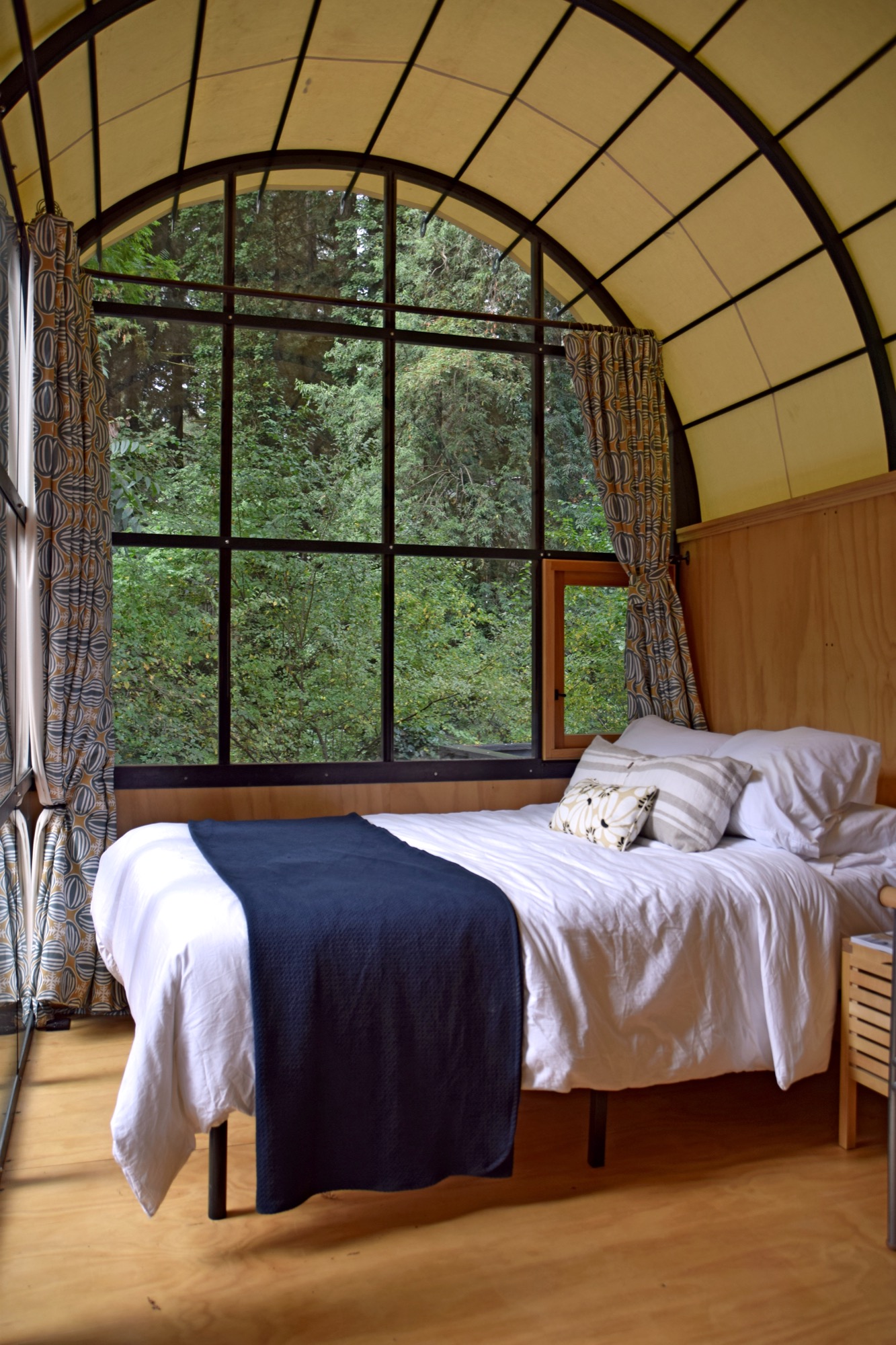
An accessible cabin built by Shelton Huts, run by Mattie Shelton and Evan Walbridge in Santa Barbara, rounds out the grounds. A steel structure wrapped in canvas with plywood floors and walls, the hut has a glass facade that offers a lush view of the banks of Hulbert Creek, which runs along the west side of camp. Custom fabric curtains designed by architect Jeff Shelton, Mattie’s father, provide shade and privacy.
"Think Wes Anderson meets the W Hotel."
Launchpad for Adventure
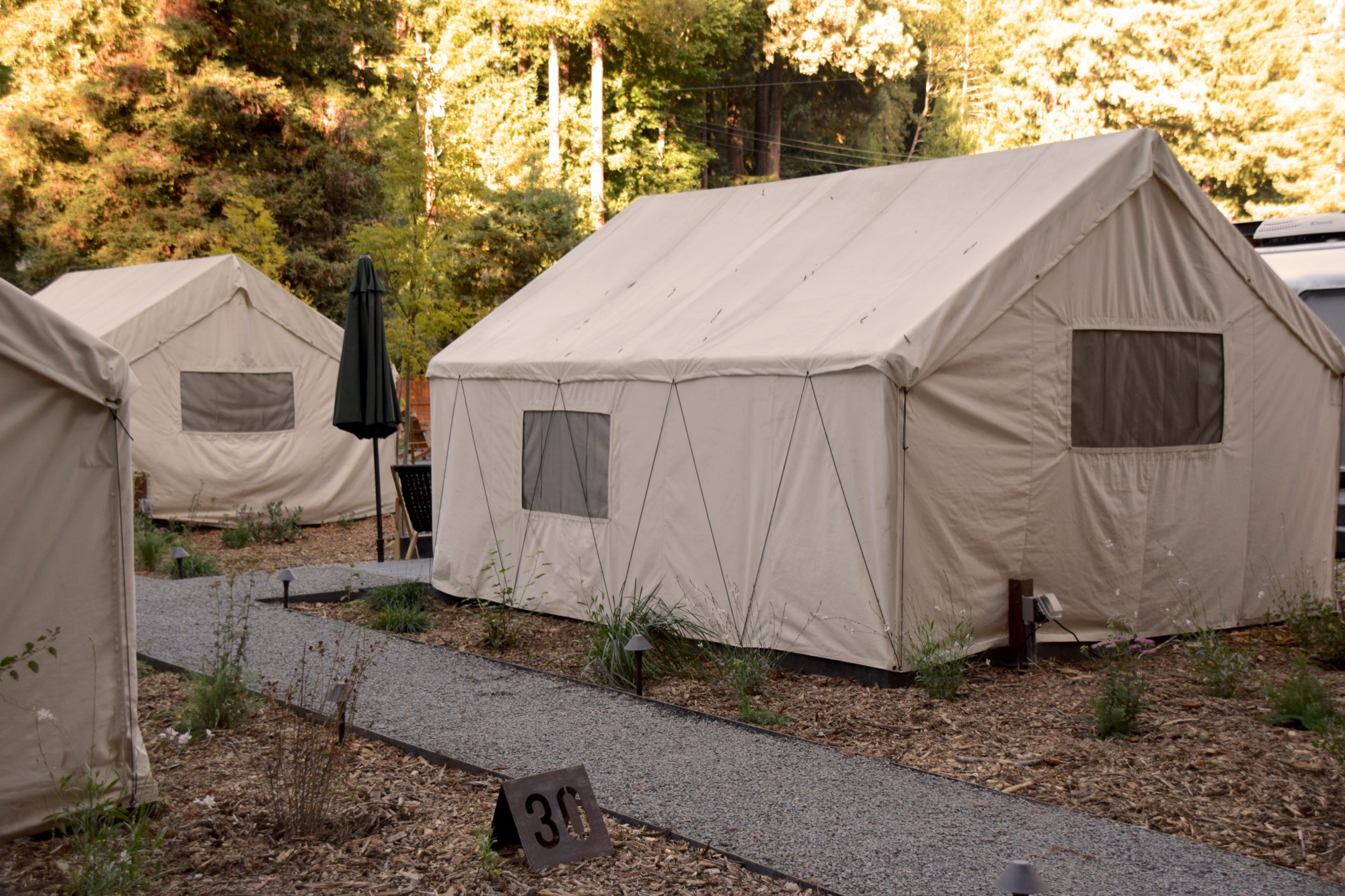
You won’t be at a loss for things to do at AutoCamp. Emerging from your Airstream or tent in the morning is an event in itself—bundled against the early chill, we helped ourselves to coffee in the Clubhouse and looked out at a meadow cloaked in fog. Linus bikes, helmets, and locks are available on a first-come, first-serve basis; on our journeys into town, we spotted several of these distinctive baby blue beach cruisers. You can check out beach towels and umbrellas to bring to the river or borrow a bocce ball set for a leisurely game on the green. An adjacent playground, basketball court, and tennis court, though not affiliated with AutoCamp, are easy to access as well.
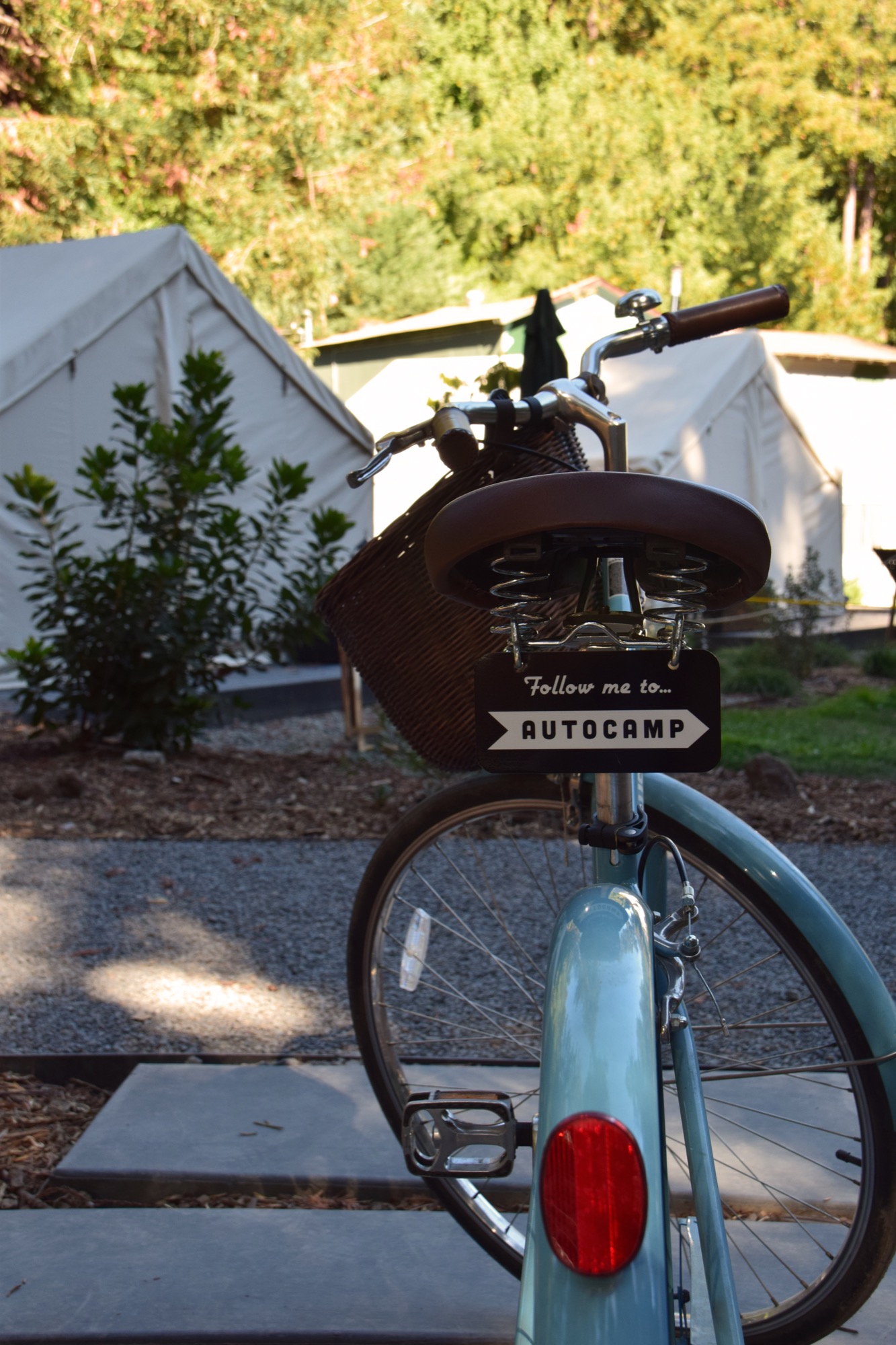
Where else you go is up to you. Describing AutoCamp, Miller said, “It’s a platform to jump off of. The best experience at AutoCamp is using it as a base camp for exploration.” From exploring the local scene to getting lost in nature, the Russian River Valley has much to offer—and AutoCamp puts it all at arm’s reach.
“It’s a platform to jump off of. The best experience at AutoCamp is using it as a base camp for exploration.”
Nightly rates for tent accommodations start at $139, while Airstream camping starts at $225. △
A Drawn-Out Hike
Seemingly so cumbersome compared with instagramming your every adventure, contemplative sketching in nature slows you down enough to see all the details.
In times of Instagramming every outdoor adventure in, well, an instant, slowing down to sketch a nature scene, seemingly so cumbersome by comparison, becomes a contemplative process, the details more significant for the effort.
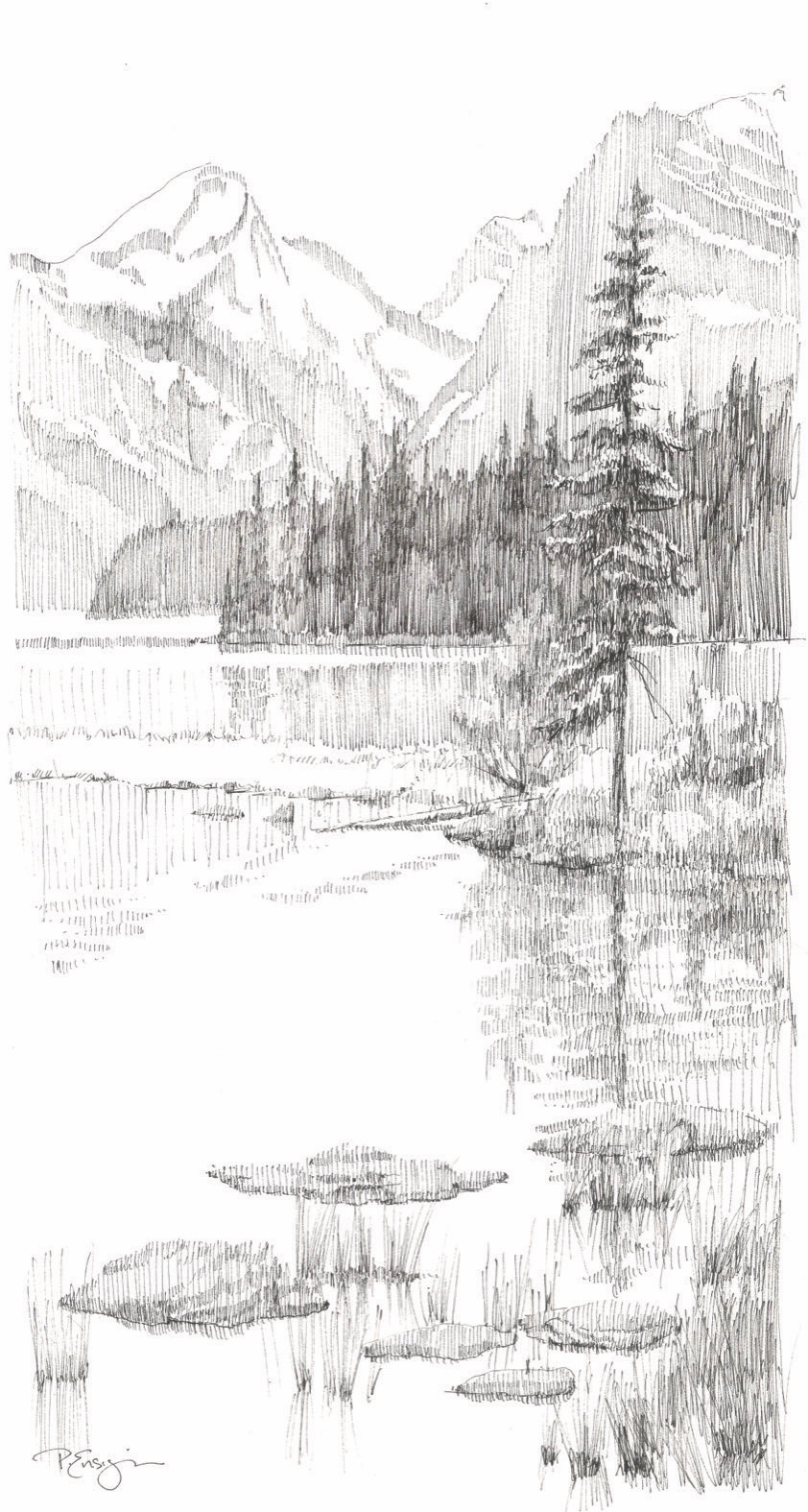
Down a short path to the water’s edge, I find a spot beneath a lodgepole pine. I sit down on my folding stool and take in the scene before me, rugged mountain peaks descending steeply, rimming Bow Lake in the Canadian Rockies. For a few moments, I simply look. It’s a powerful and grand view. While most people might take a series of photos to document the beauty of this vista, I prefer to draw.
Drawing is quiet work. It’s my favorite way to connect with the mountains. First, I study my subject carefully. I examine each ridge and crag. I study layers of rock and sand, discover the nooks and crannies and the remnants of snow. Looking intently, I seek out proportions and relationships, consider the depths and heights, and pay close attention to the movement of light and shadow. To draw effectively is to see, really see, what’s in view. But even more than seeing, drawing on location is a total experience. Sitting on this quiet bank, away from picnickers and tourists, I hear the gentle lap of water against the shore and the birds in nearby branches. I feel the soft breeze against my face and smell the damp ground at the water’s edge along with the sweet scent of pine needles. Immersing myself in my surroundings, as I begin to draw, I let my hand and my thoughts reflect the grace of the moment.
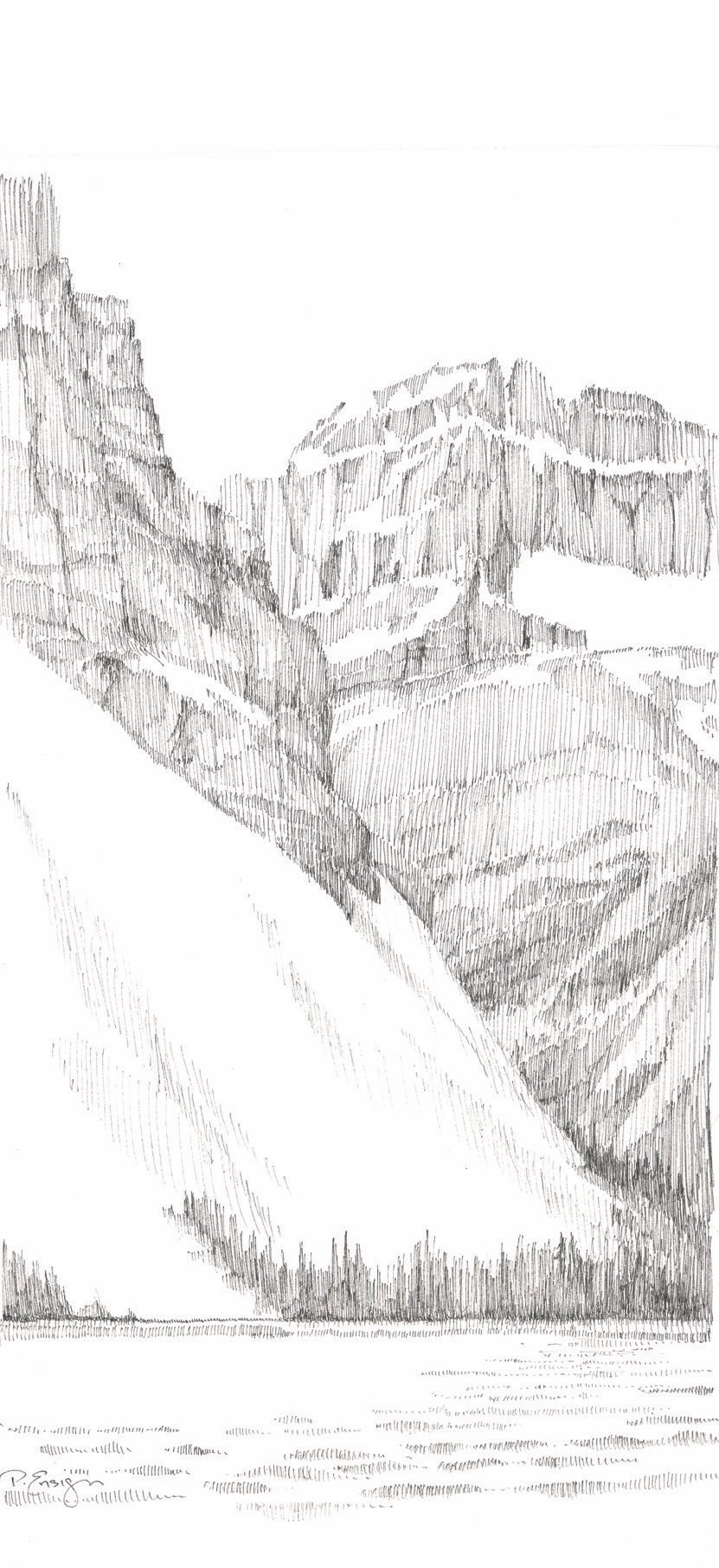
Splendor, line by line
No special talent is needed for this task. Drawing is simply putting marks on a surface to illustrate where one’s eye goes. Anyone can experience the joy of drawing a scene before them. All that’s needed is a paper, a pencil, and a little time. Today, I start with a line drawing that identifies the big shapes, the overlap of one ridge against another. Next, I look for dark and light areas—known as values. As my drawing develops, I stay focused on my subject, constantly verifying angles and details. Lastly, I take care not to overdo the minutiae and make a point to stop before too many lines spoil the intention.
Glacier-hopping
Earlier in the day, I stopped at a pullout on the Icefields Parkway with a fabulous view of Crowfoot Glacier. The parking lot was filled with cars, campers, and buses. Tourists hopped out of their vehicles, snapped a few pictures, then jumped back into their cars to speed down the road to the next viewpoint. How will they know one glacier from the next? What memories will linger long after they have left this grand landscape?
Yes, the quiet deliberation of drawing is slow and methodical. It takes time. What could be more valuable in our hurry-up world of instant everything than to open the senses and make a lasting imprint on the soul? Take just one hour to study, absorb, and look carefully at a scene, and you will never forget it. A relationship will form, a lasting memory will be etched in consciousness. I never forget a location where I have spent time sketching.
“What could be more valuable in our hurry-up world of instant everything than to open the senses and make a lasting imprint on the soul?”
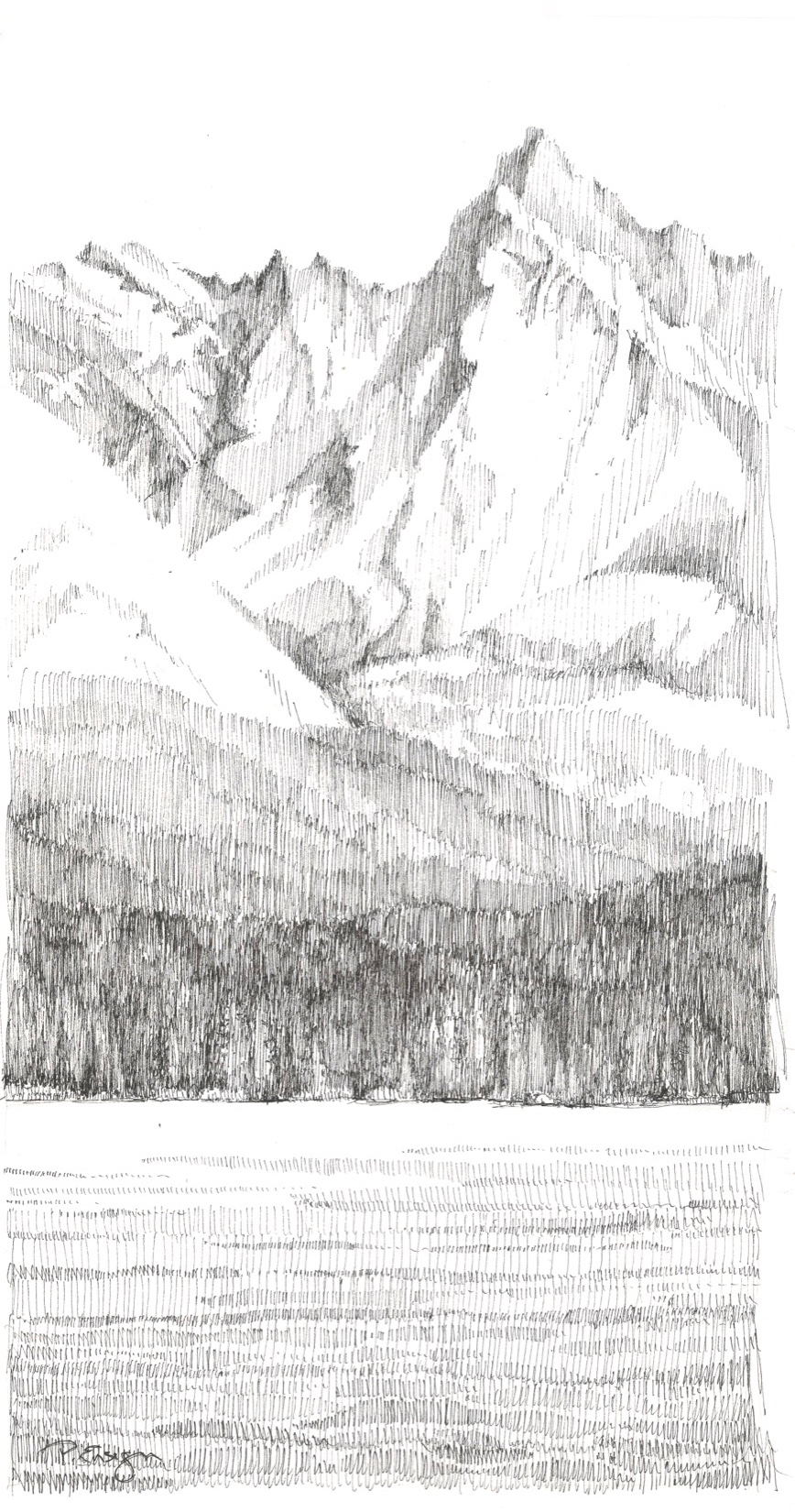
Drawing is a wonderful way to hold on to our travels and experiences. It’s never about the success or failure of the end result. It’s not about technique or individual style. It’s about the process. It’s about the time, the connection, and the quiet communion between artist and subject. △
“Drawing is a wonderful way to hold on to our travels and experiences.”
The Modern Craftswoman
Crafting small leather goods and wood objects in Boulder, Colorado, Alexa Allen is an artist, a designer, a maker, and a mother
Alexa Allen is an artist, a designer, a maker and a mother. Though not necessarily in that order. It’s more of a constant mash up of all of them, all at once, every minute of the day.

Her story is familiar in the world of design. She started one place, took a few turns, took a few more turns, and today straddles a beautiful line between working for a renowned creative house (i.e., superstar and jeweler to the stars Todd Reed), and launching her latest venture crafting small leather goods and wood objects.

Allen doesn’t turn towards the age-old cliches of “work hard,” “do what you love,” and “follow your dream,” when describing her journey. However, there is no doubt that this woman has put her heart and soul and blood, sweat and tears into creating a thriving business, that right now, after 20 years digging in, is on the cusp of something big.
A conversation with Boulder designer and maker Alexa Allen
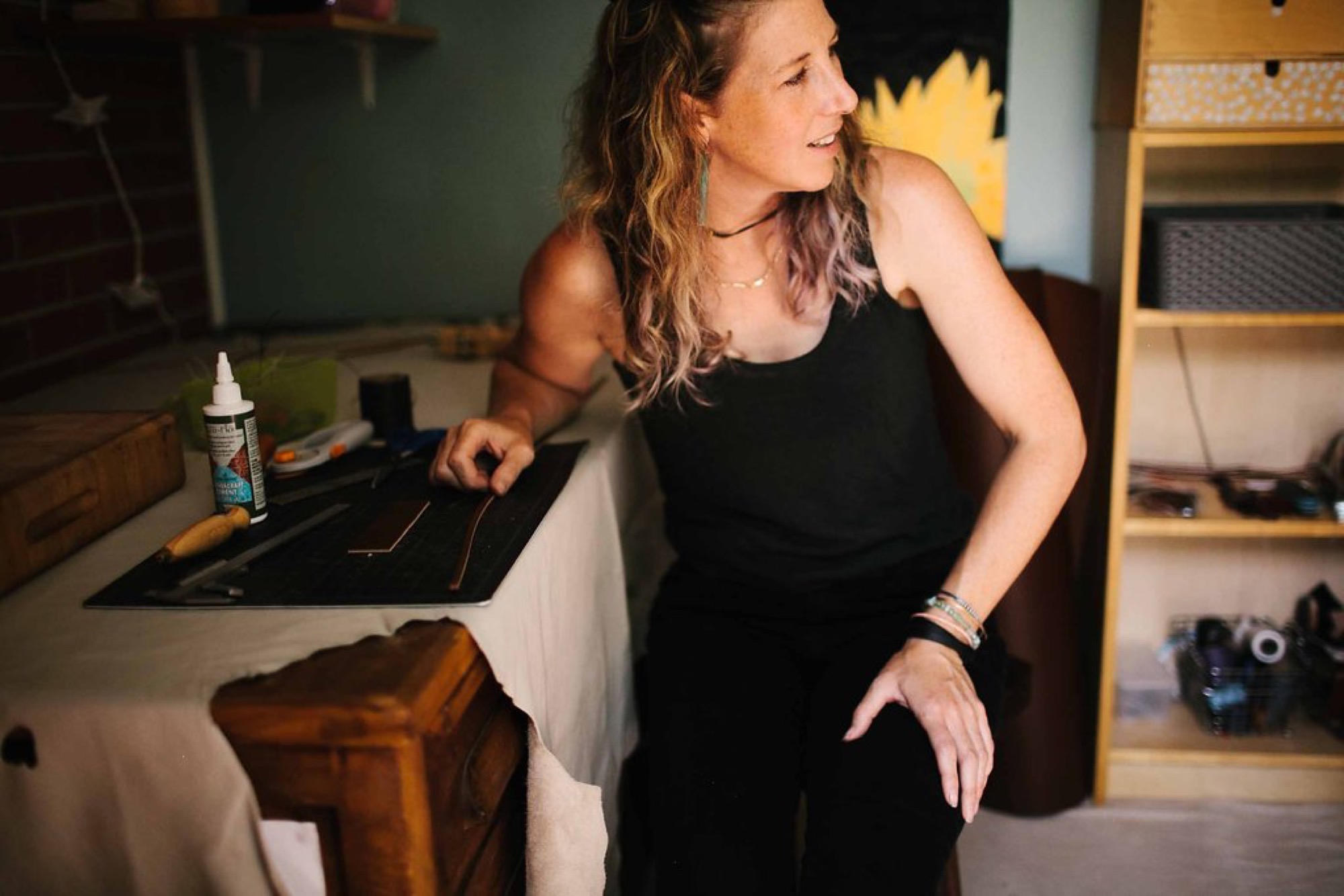
Give us the 15 second version of how you landed where you are today
I’m originally from Boulder, and after living in California for many years, moved back to Colorado in 2010 to start a line of eco-modern children’s furniture. While my love for furniture and woodworking remained, I got the creative itch to branch out and learn another craft. I found a leather class by a very talented local leather artisan, and was hooked immediately. I quickly discovered that the combination of wood and leather goods was a natural fit and this realization has shaped my career path ever since.
"While my love for furniture and woodworking remained, I got the creative itch to branch out and learn another craft... I quickly discovered that the combination of wood and leather goods was a natural fit."
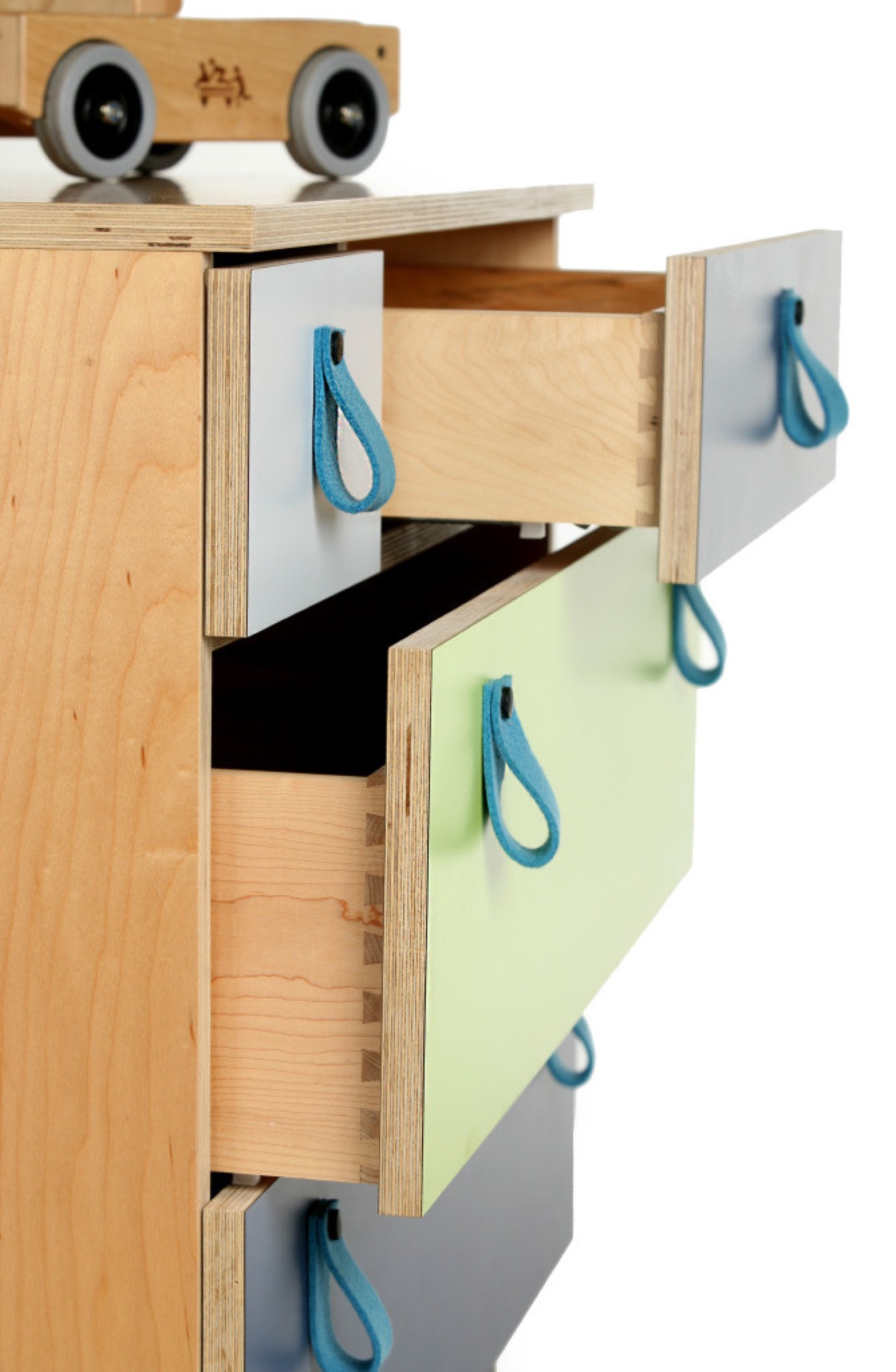
What aspect of your upbringing/childhood affected your decision to go into woodworking?
During my childhood, my father was a contractor so I spent a lot of time on construction sites. My father taught me about the tools of his trade—how to hold them correctly, how to use them, and how to take care of them. I spent endless hours trying to master the art of hammering a nail all the way in with one hit. I never did master that one. However, I’m sure I was one of the only girls in third grade who could wield a hammer, and I took great pride in it. Looking back, my career as a craftswoman makes complete sense though, truth be told, as a girl, I never envisioned that I would earn a living doing so.
"Looking back, my career as a craftswoman makes complete sense."
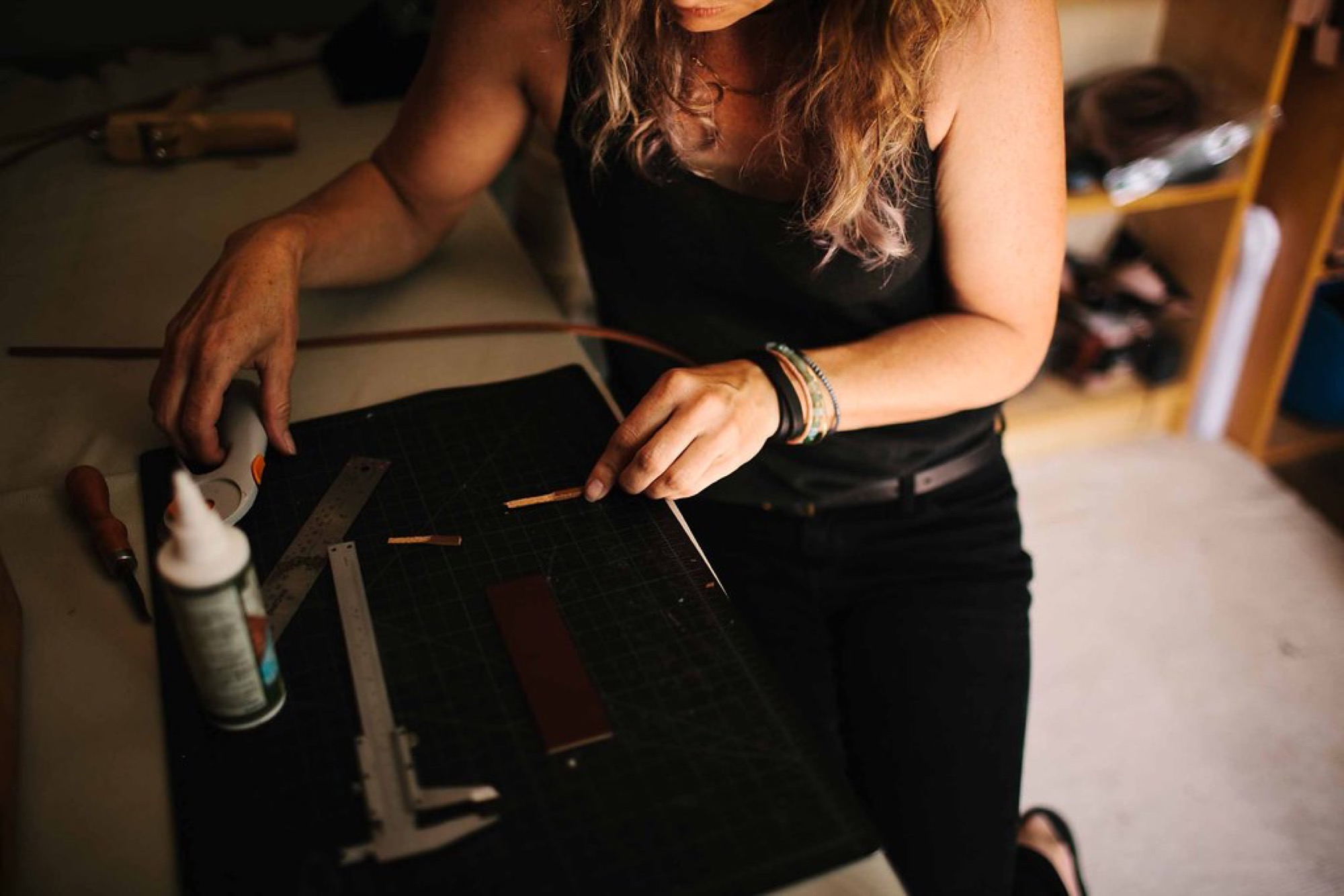
Describe the moment you decided to become a craftswoman
I earned a bachelor of arts degree in art history from Scripps College in Claremont, California. Scripps is an esteemed women’s college, and in addition to providing me with a great foundation in the arts, it also gave me the strength and confidence to succeed as an independent woman.
After my time at Scripps ended, I realized that interpreting and assessing the art of others was not my ultimate purpose in life. I wanted to create art of my own. As I contemplated which direction to take, it soon became clear that I needed to practice an art form that was physical and hands on. Thus, I enrolled in the furniture design department at The California College for the Arts (CCA). For me, the act of making/building/creating must engage both my mind and body—the physical act of making is a crucial component of my art.
"Scripps is an esteemed women’s college... it also gave me the strength and confidence to succeed as an independent woman."
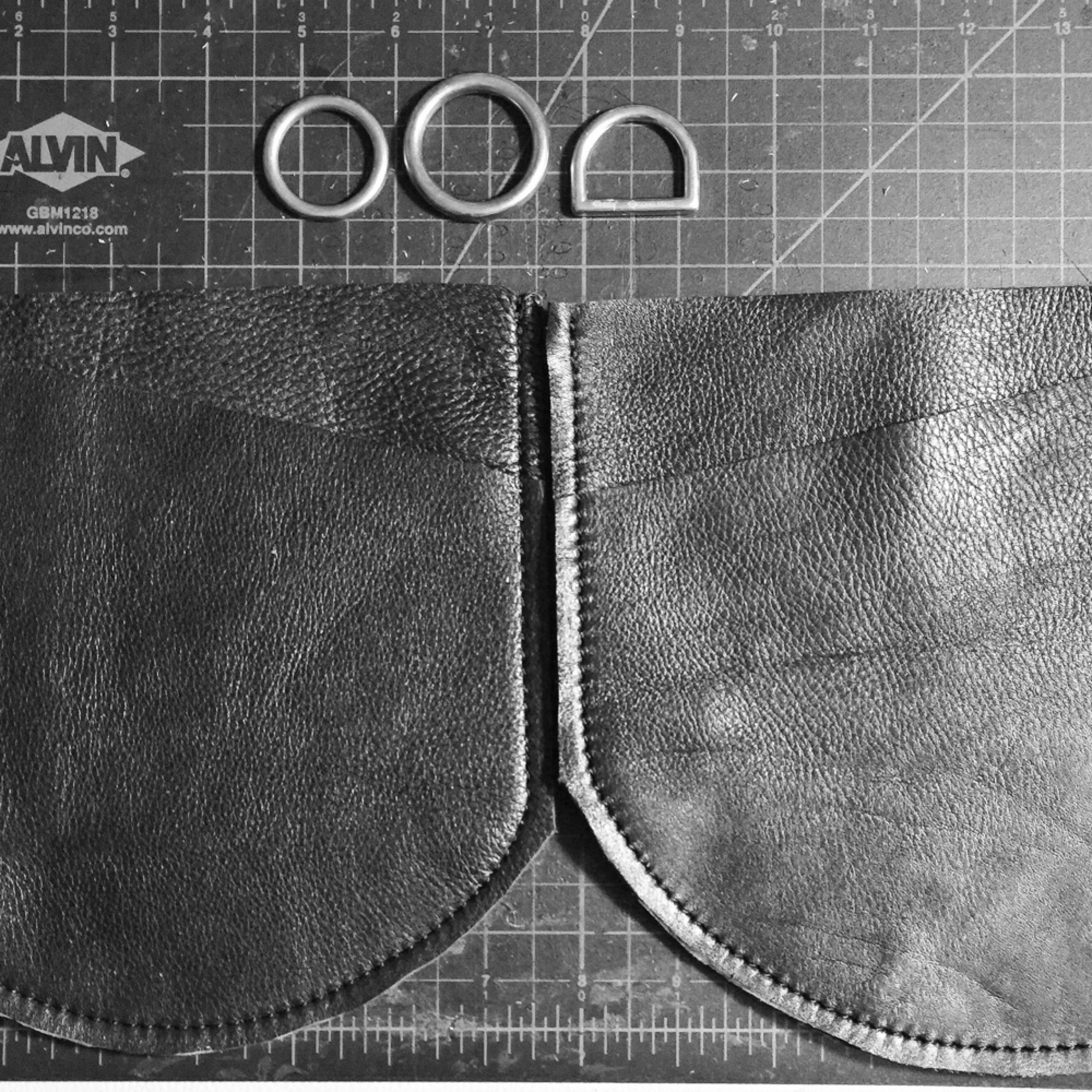
Furniture-making has now evolved into leatherwork and I am excited to see where it takes me next. The more I learn, the more passionate I become and the more my creativity grows. This thirst for new skills is the driving force in my work. By continuing to learn and expand my skills, I can confidently call myself a designer, an artist and a craftswoman.
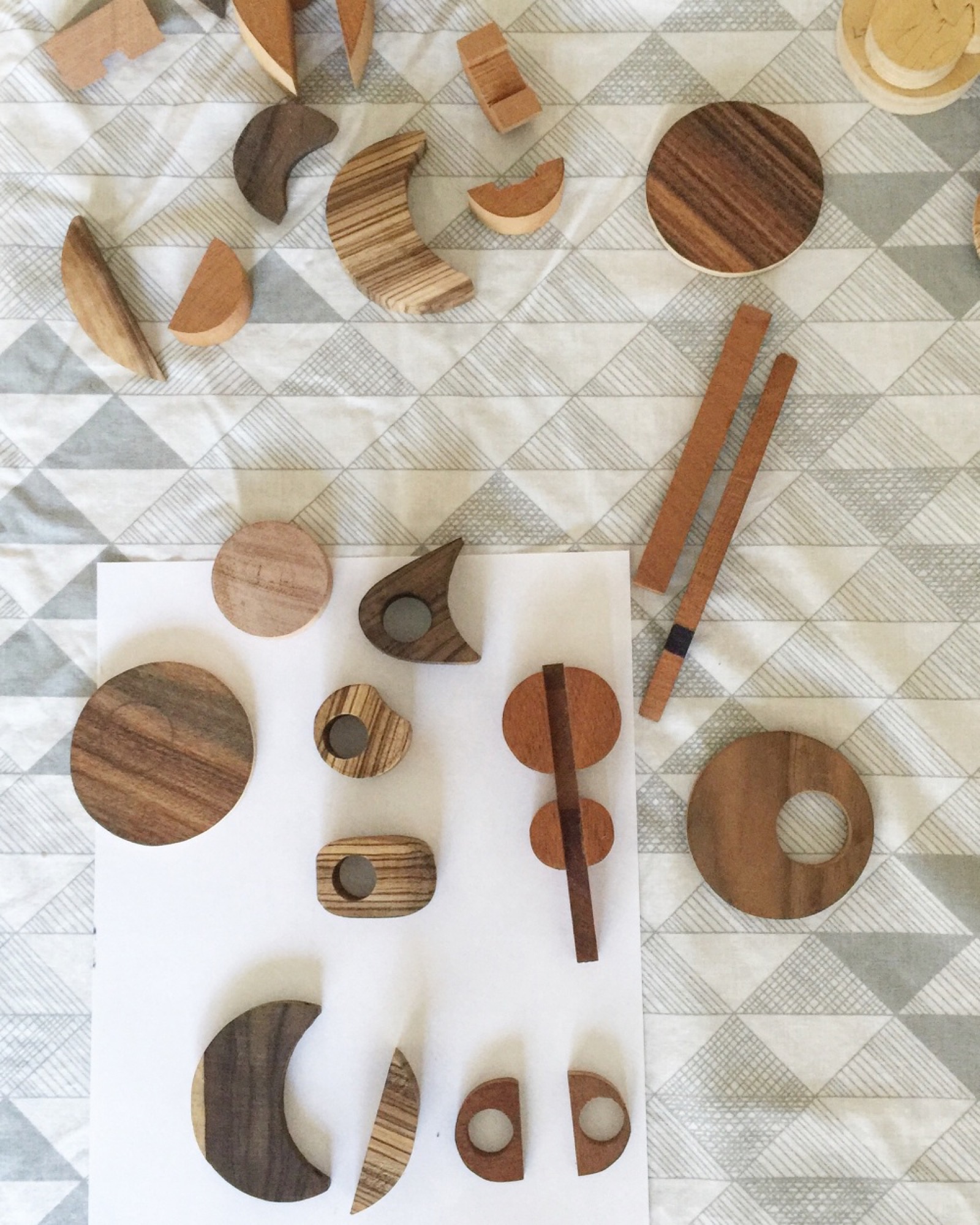
"By continuing to learn and expand my skills, I can confidently call myself a designer, an artist and a craftswoman."
What is the one piece of advice you would give to young women who are just getting started?
I was fresh out of art school at the California College for the Arts when I was hired at a custom cabinet shop in Oakland. The furniture department at CCA had a fairly large number of women in the program and we had an amazing camaraderie. It never occurred to me that this would not be the case in a “real life” scenario.
I was hired at the woodshop in the middle of a high-end Japanese-inspired project, which required a lot of skilled, on-site work. I was called on to route a 12-inch circle that needed to precisely fit a metal fixture, which had just been laid. I was stressed—one small slip of the router or one mistake in sizing, and I would have set the project back by weeks.

I made a jig and practiced in the shop, until it was perfect. The day I walked on site, there were five drywall guys all staring at me. I walked in and set up my router and my jig. By the time I had finished setting up the entire construction crew was watching my every move. I was so nervous! But, I knew what I was doing and I confident in my abilities. Needless to say I executed the task perfectly and from that day on, I was known as “the router queen.”
So my advice to women out there who are just getting started? Know your shit and walk in there like you own the place. △
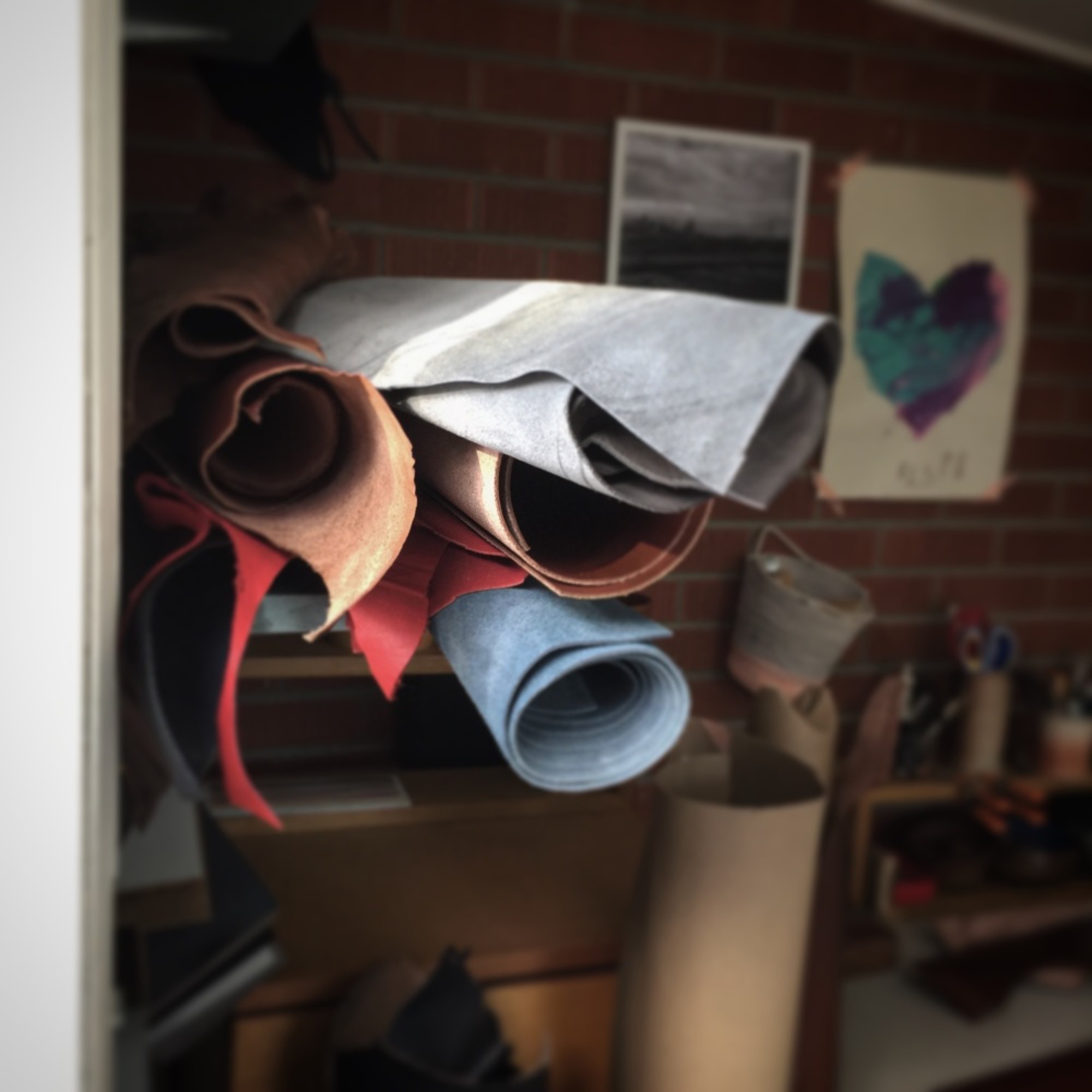
This story was originally published by TARRA: Women Who Create






